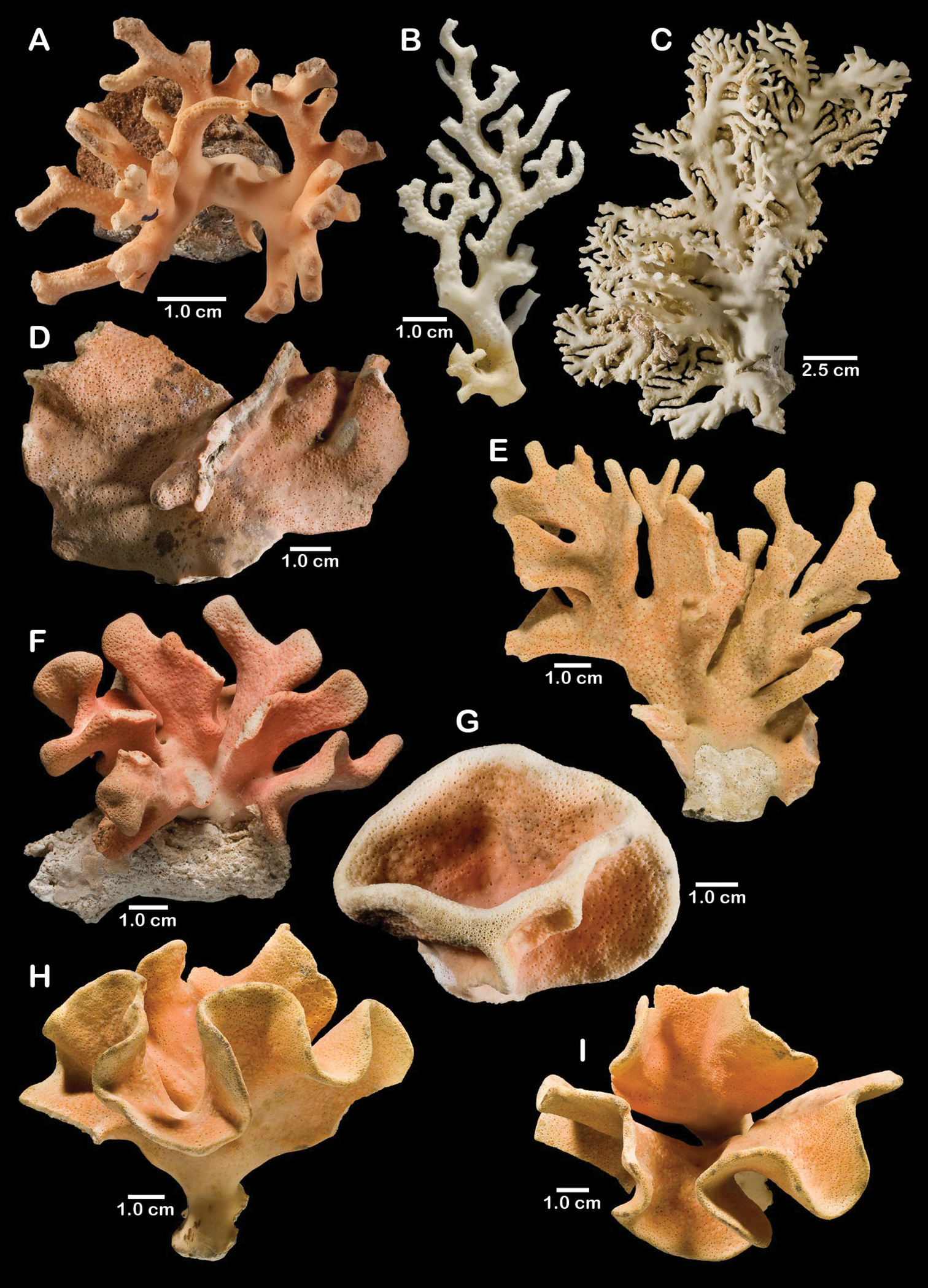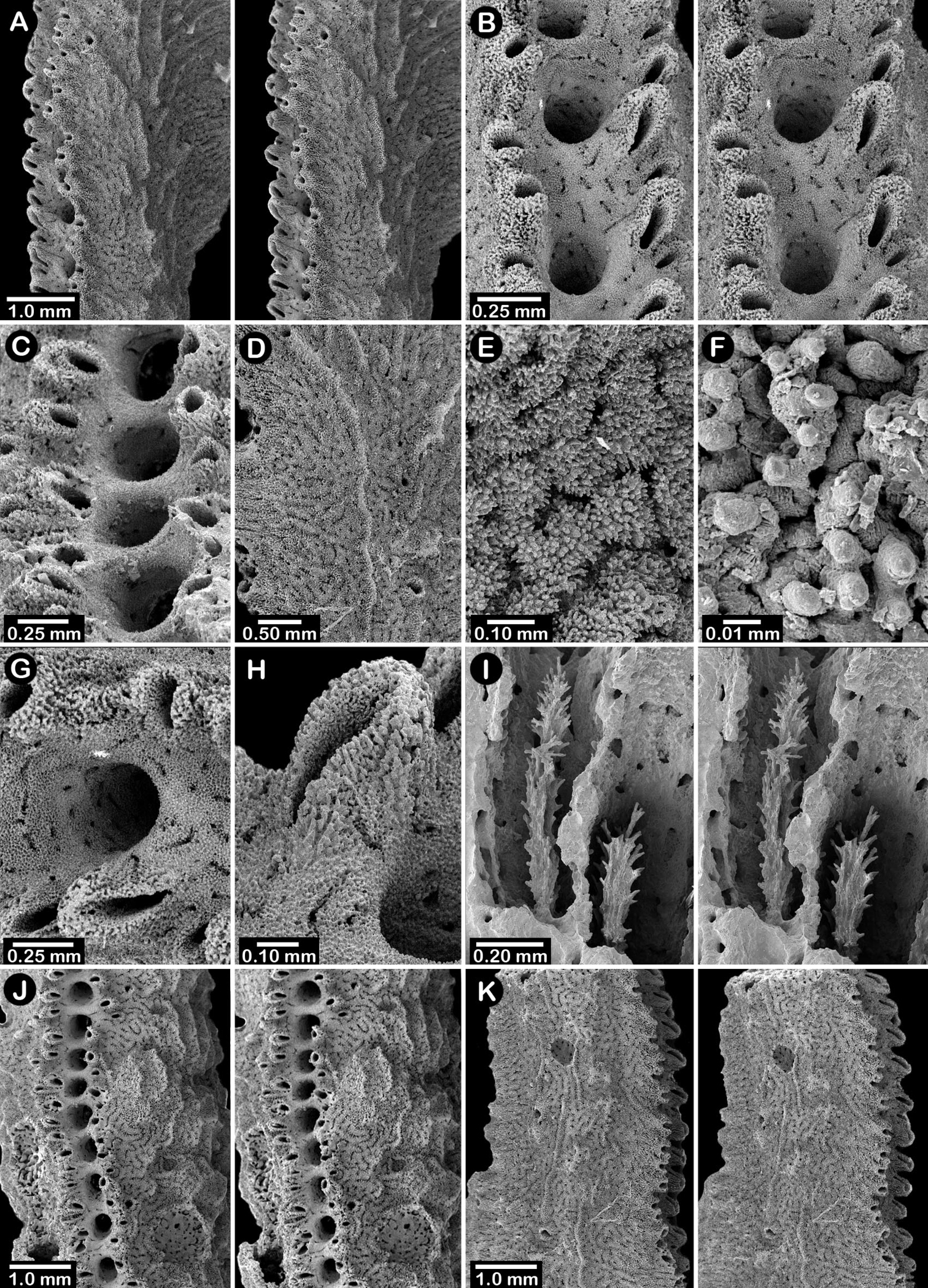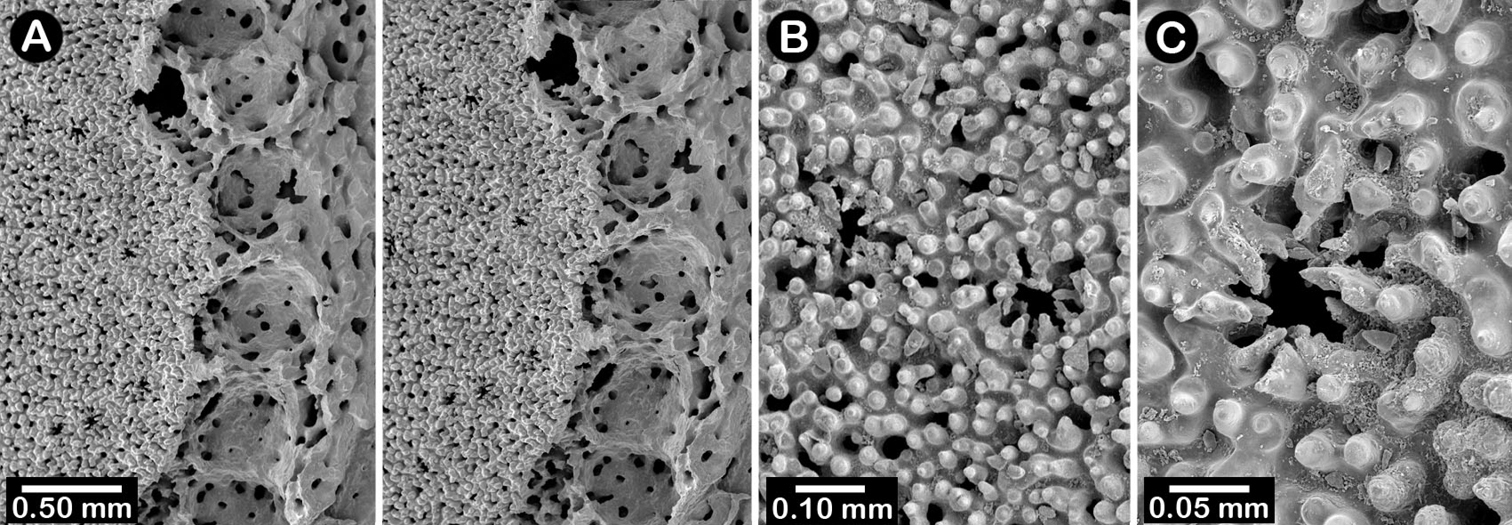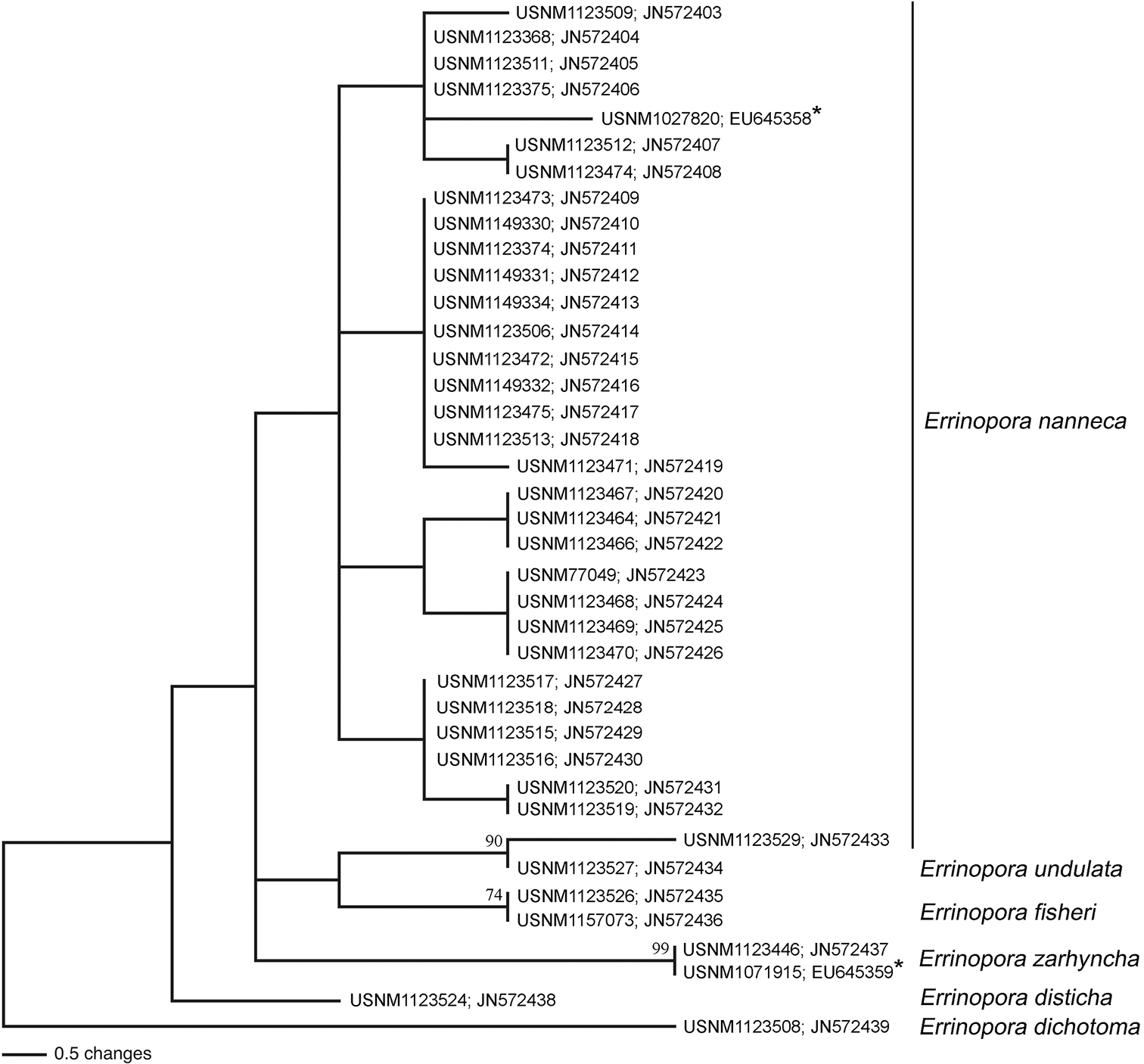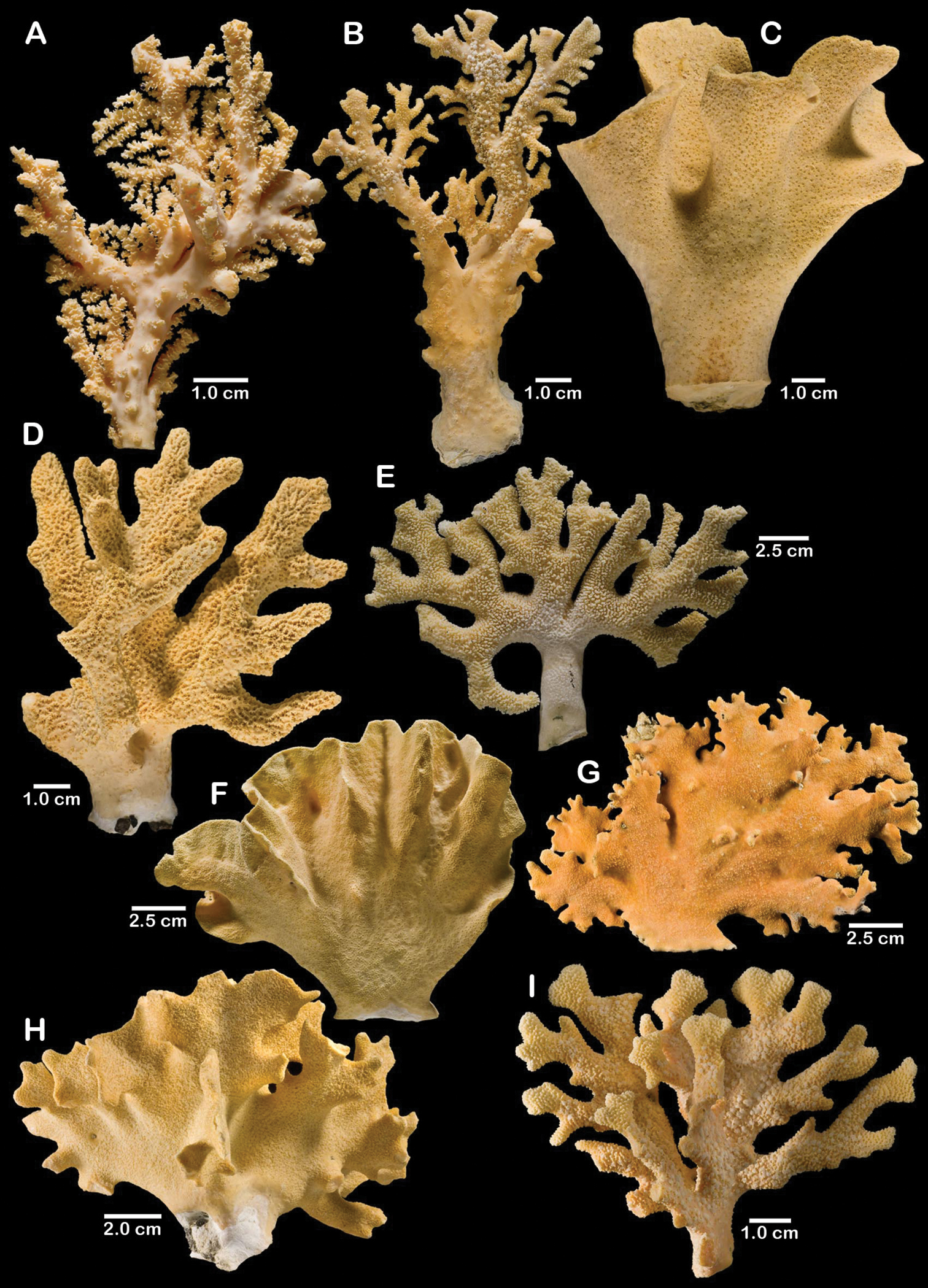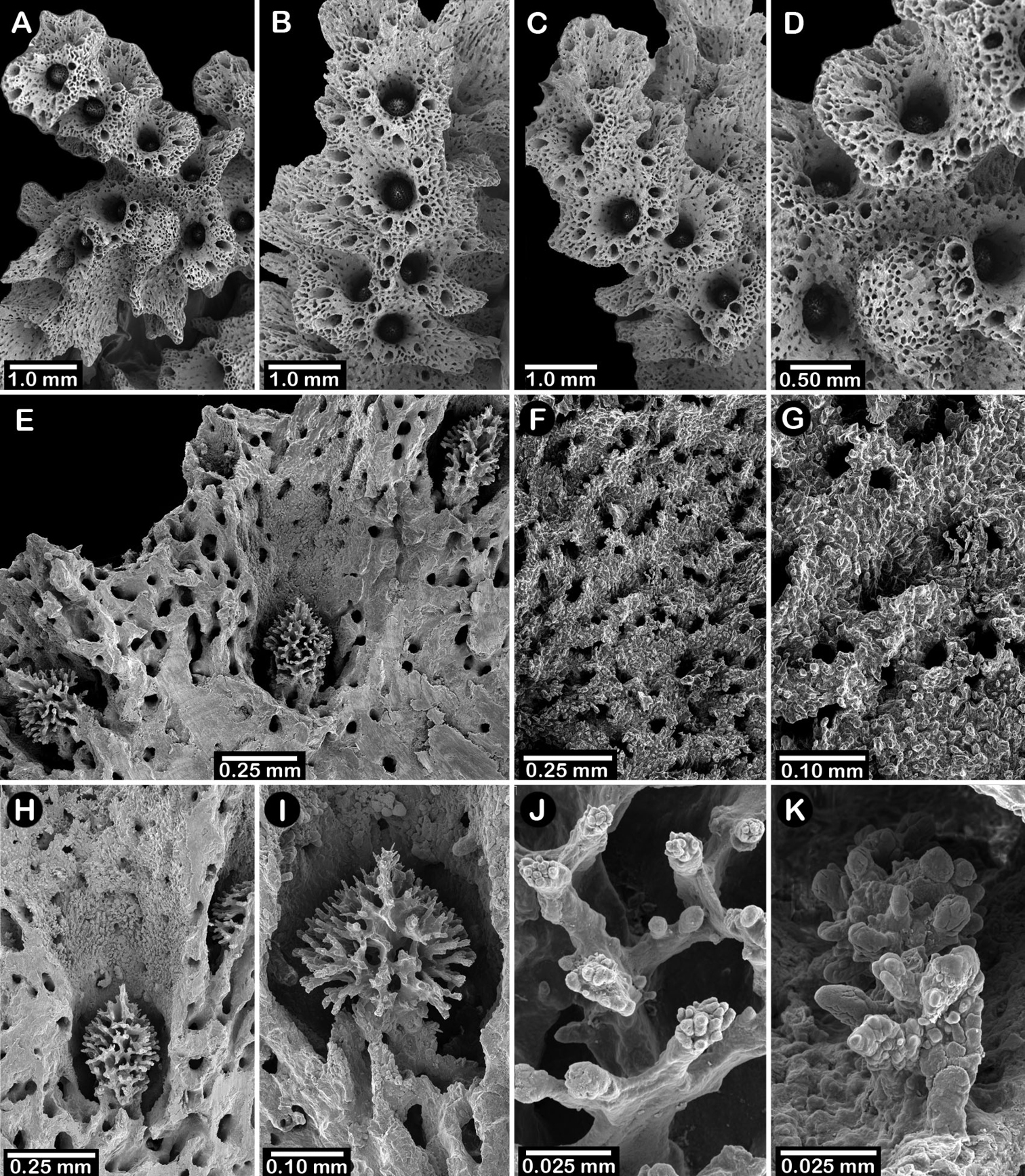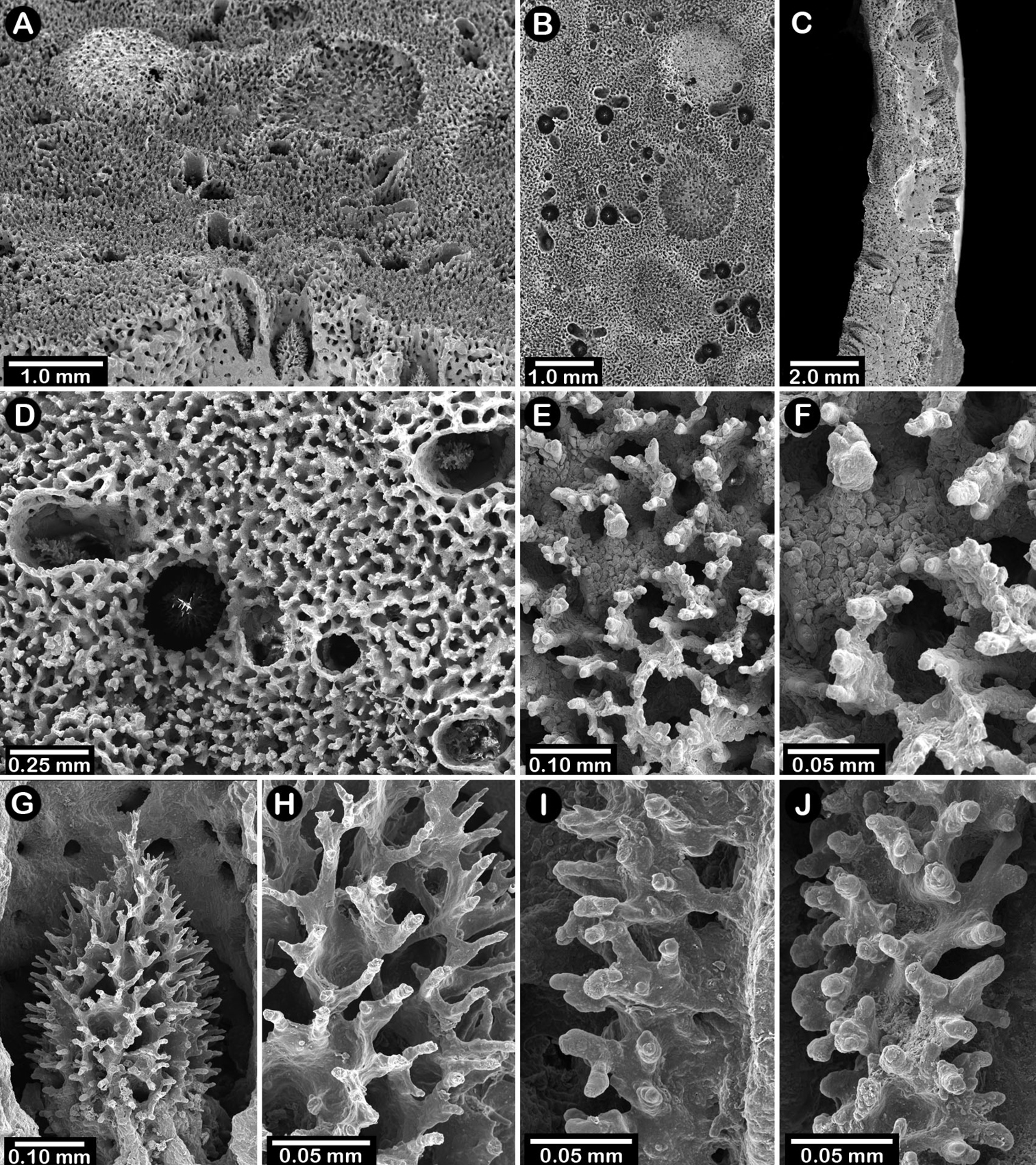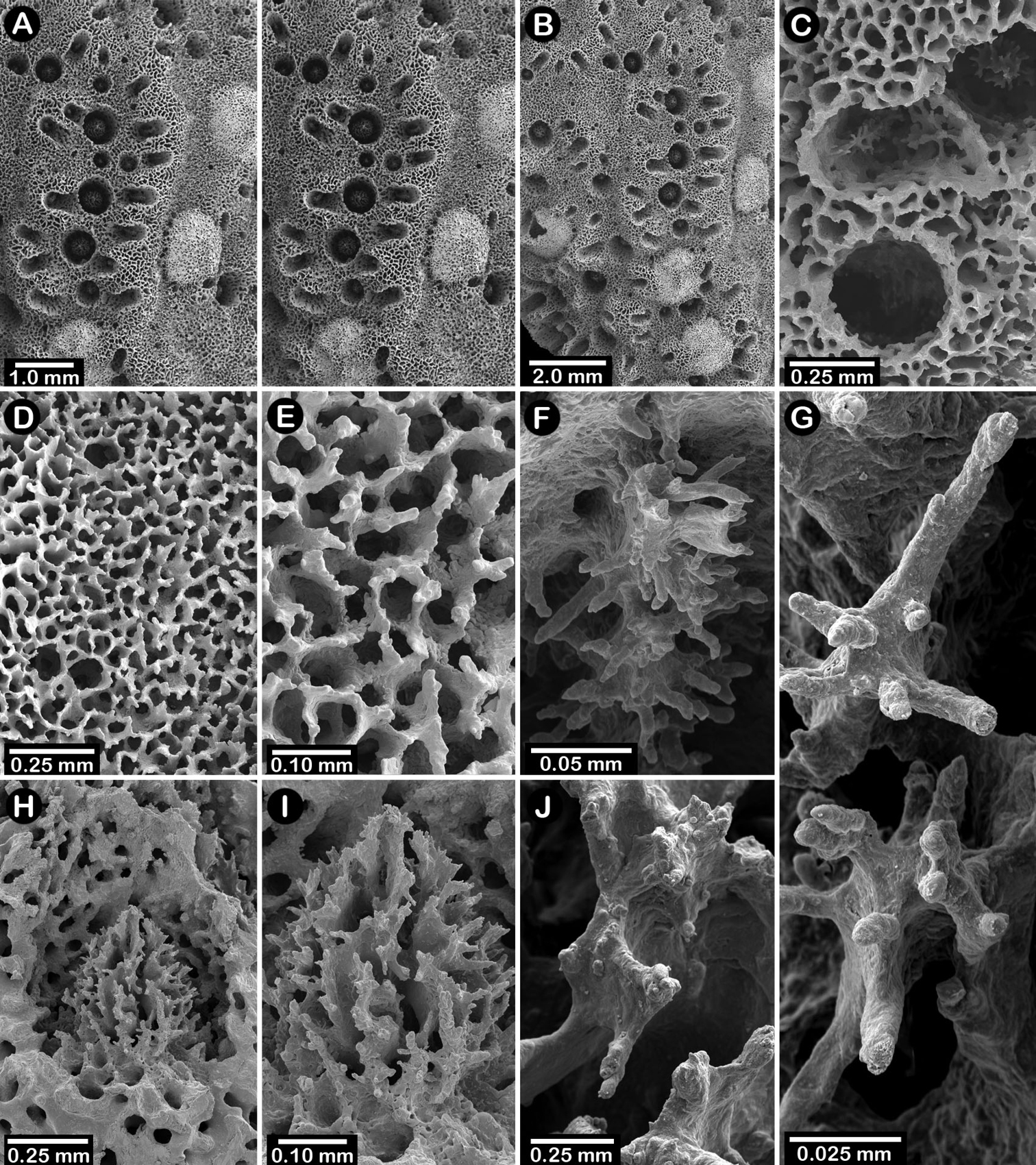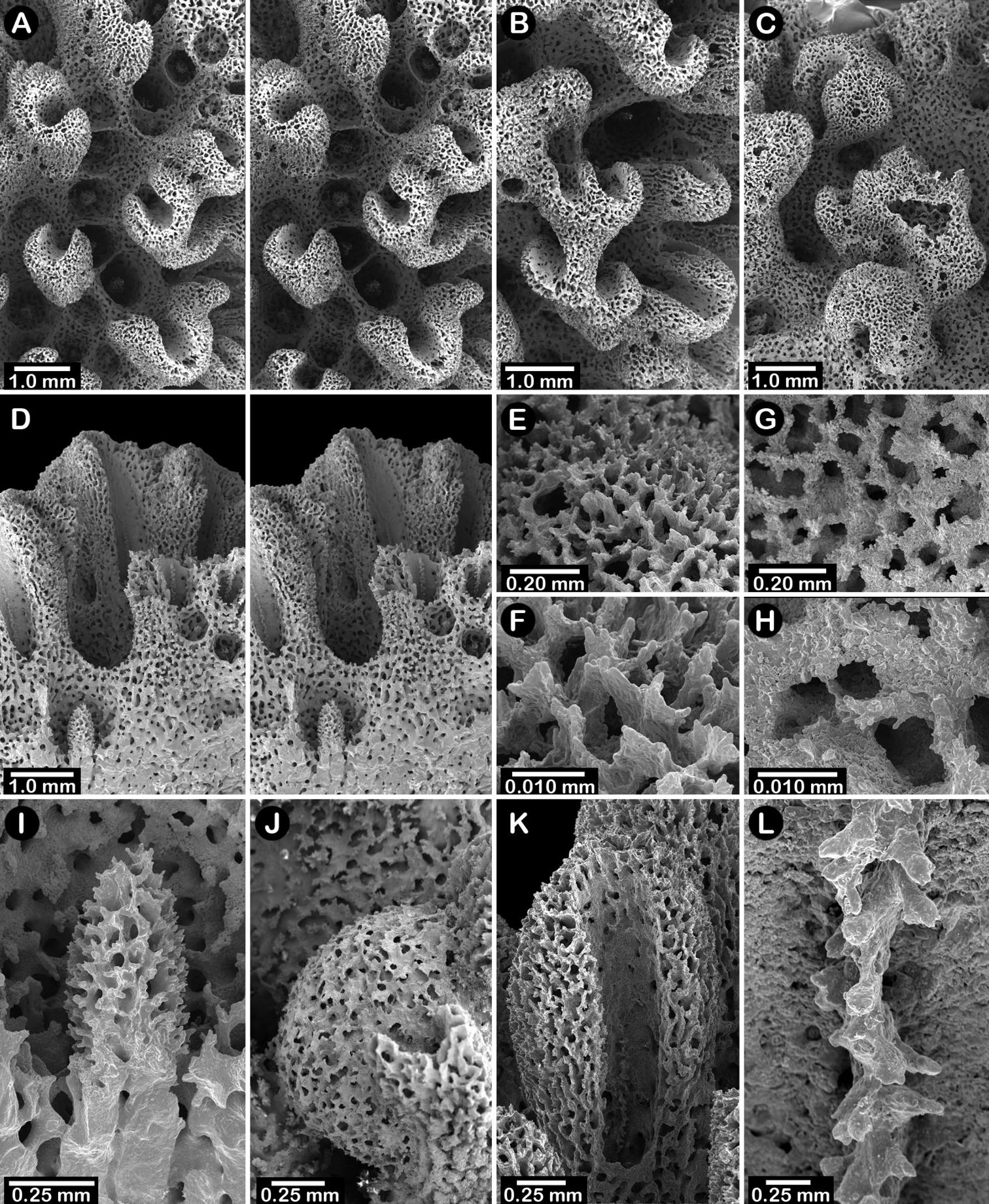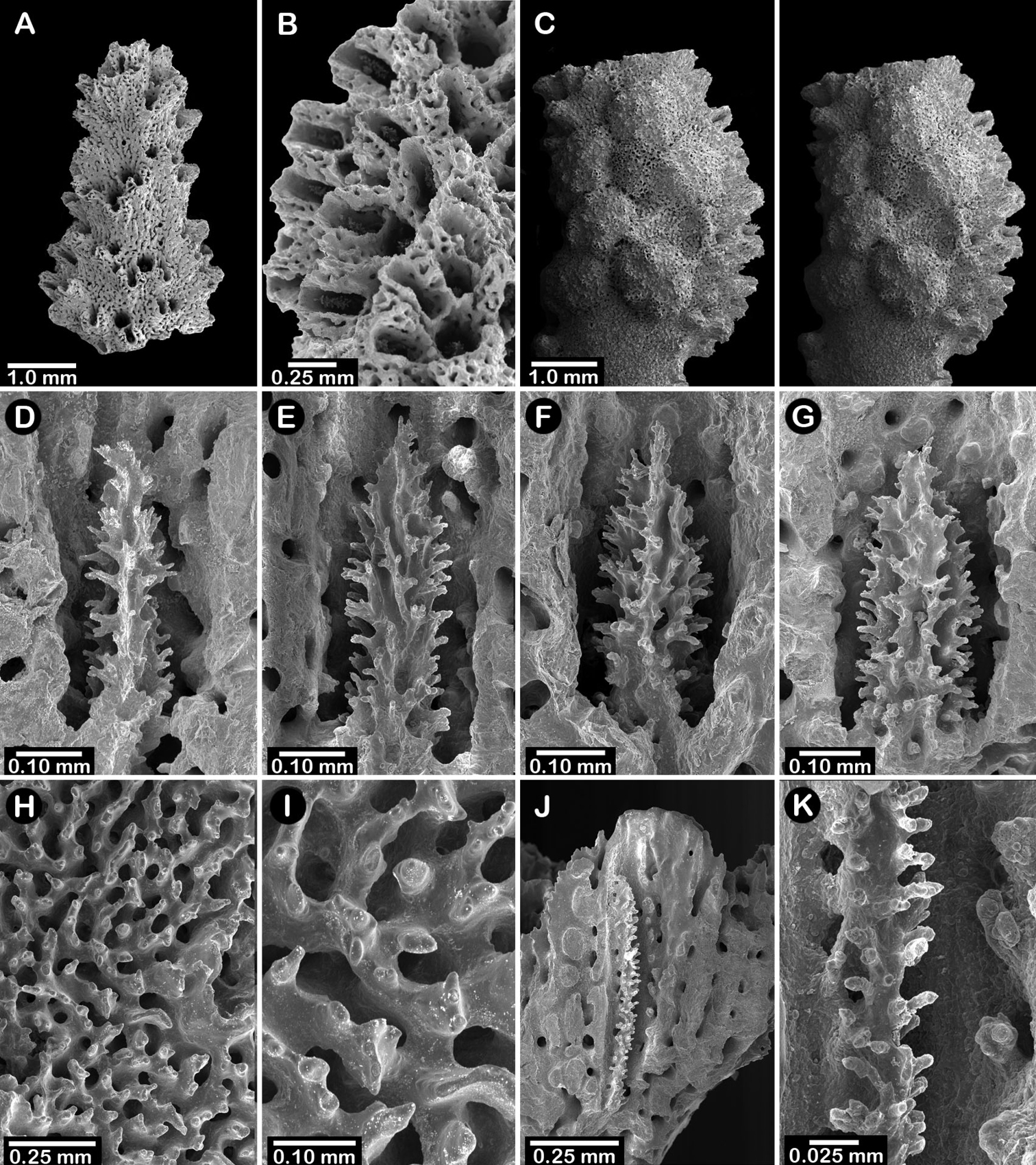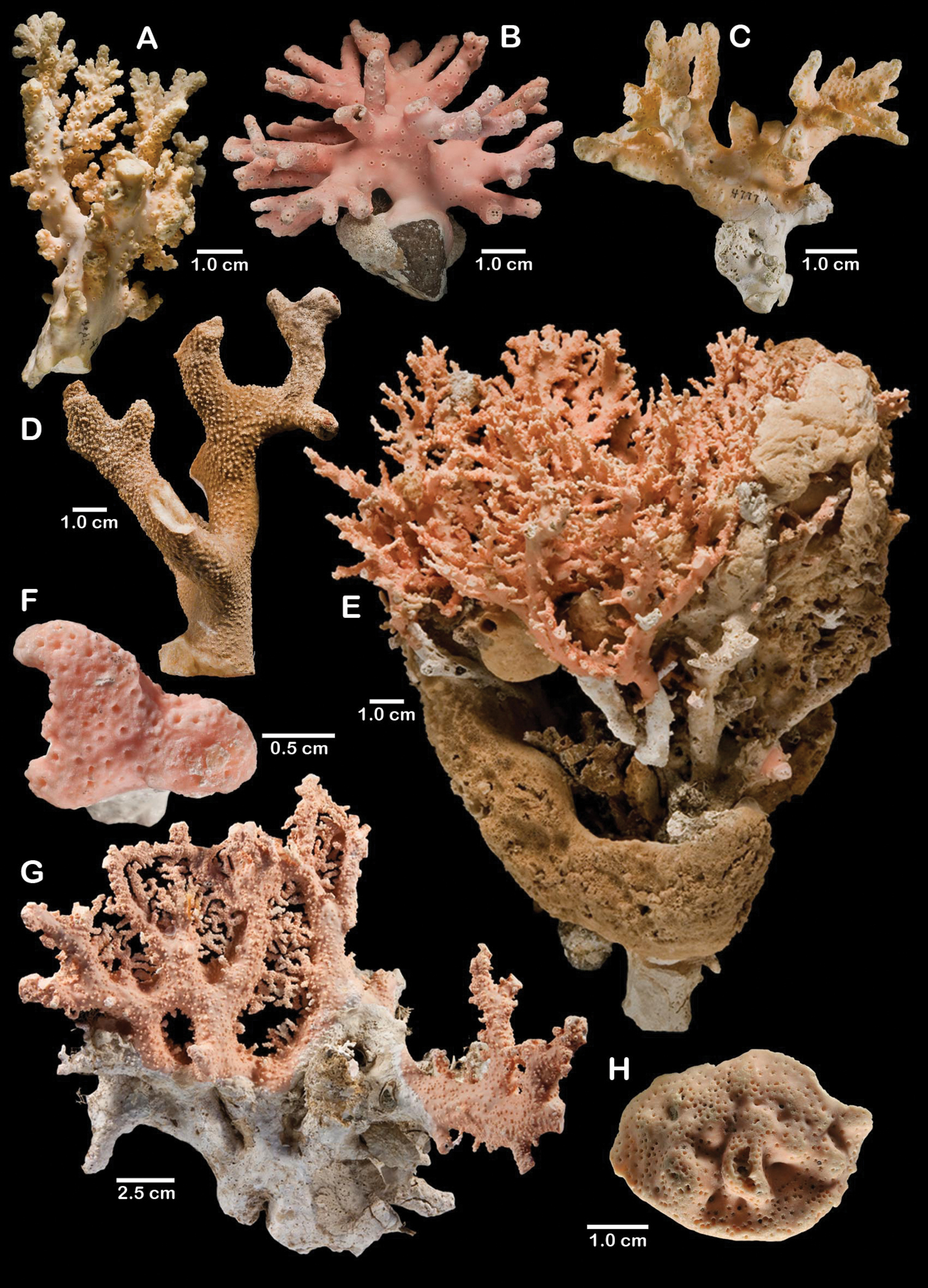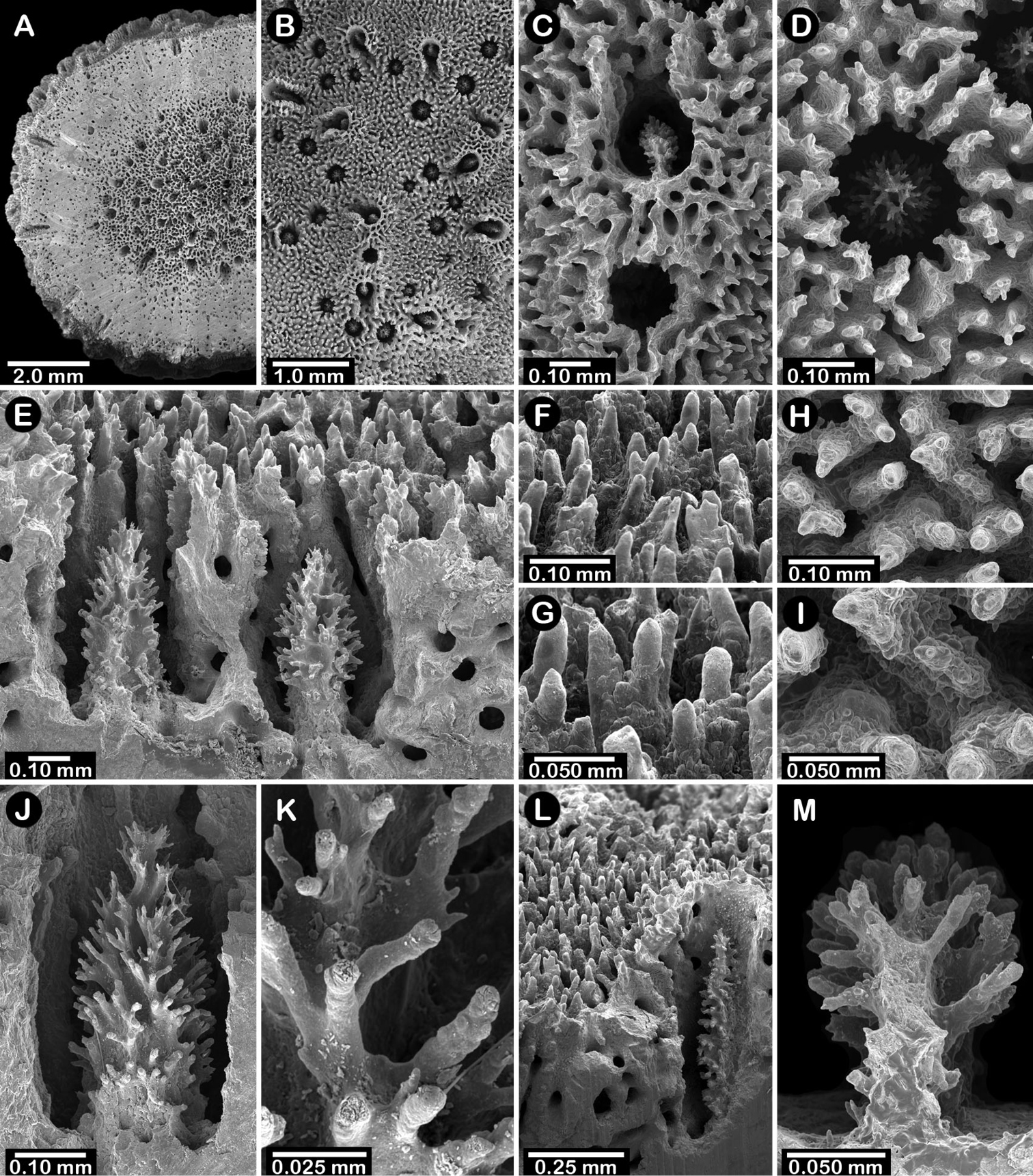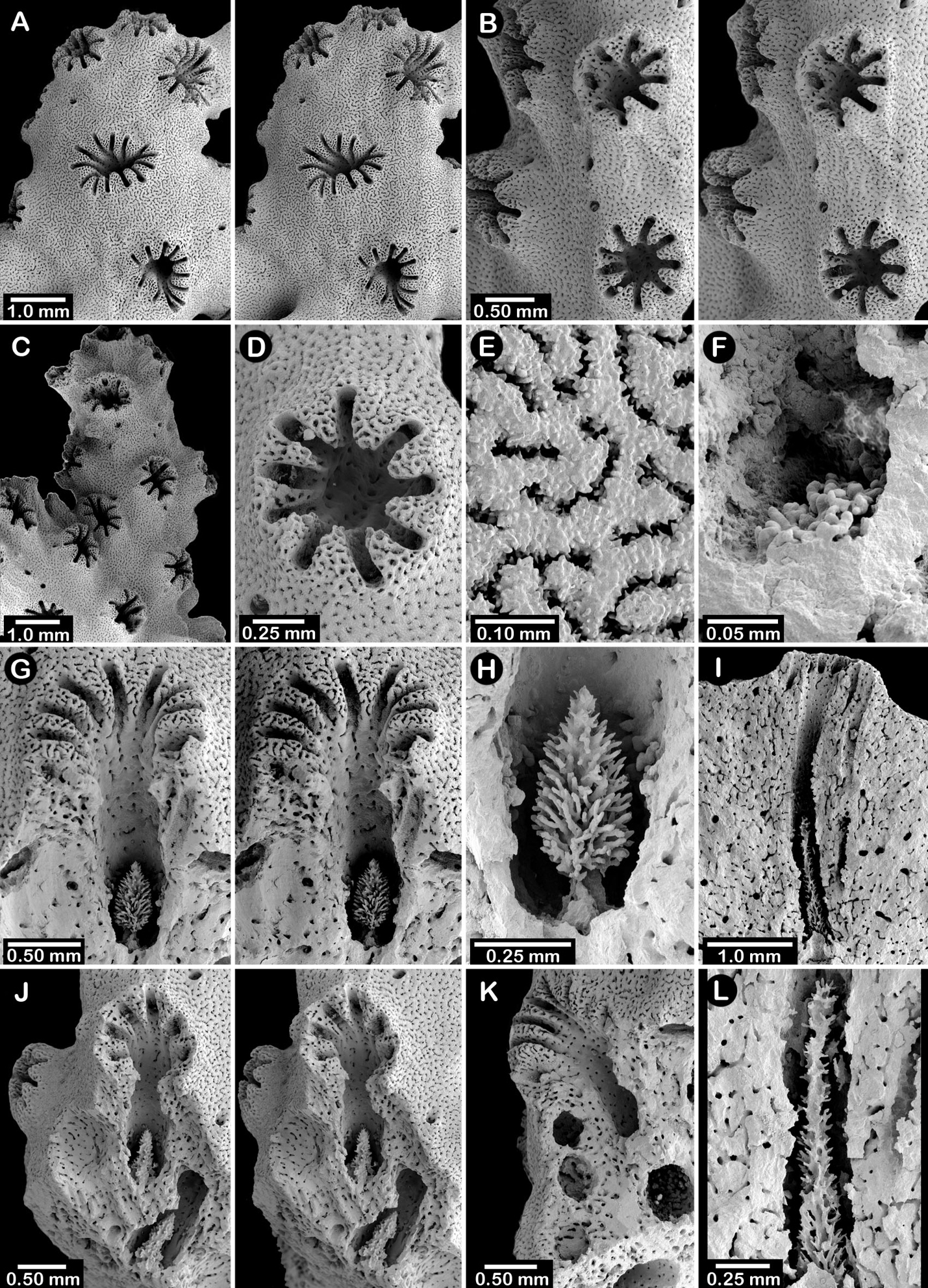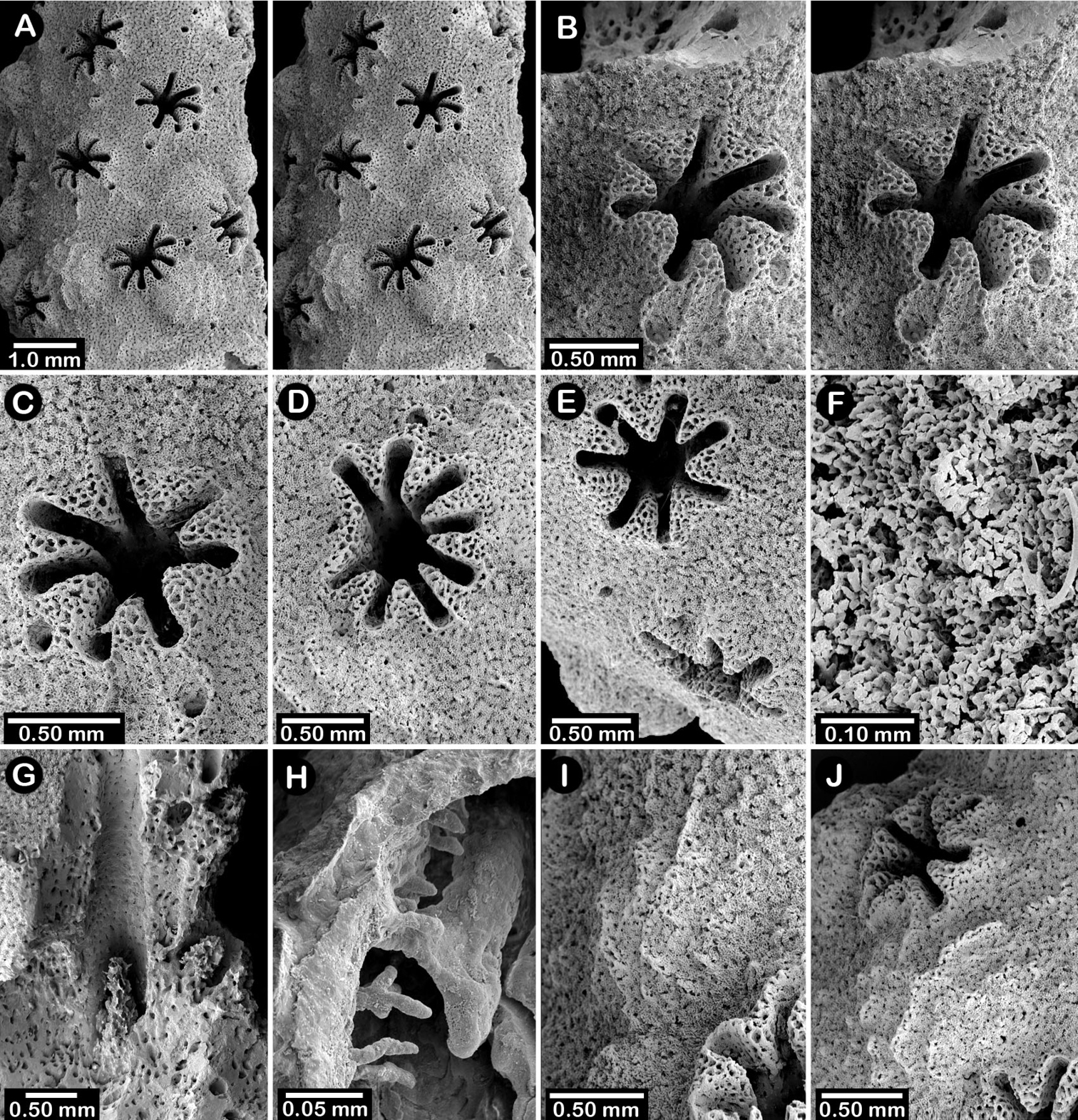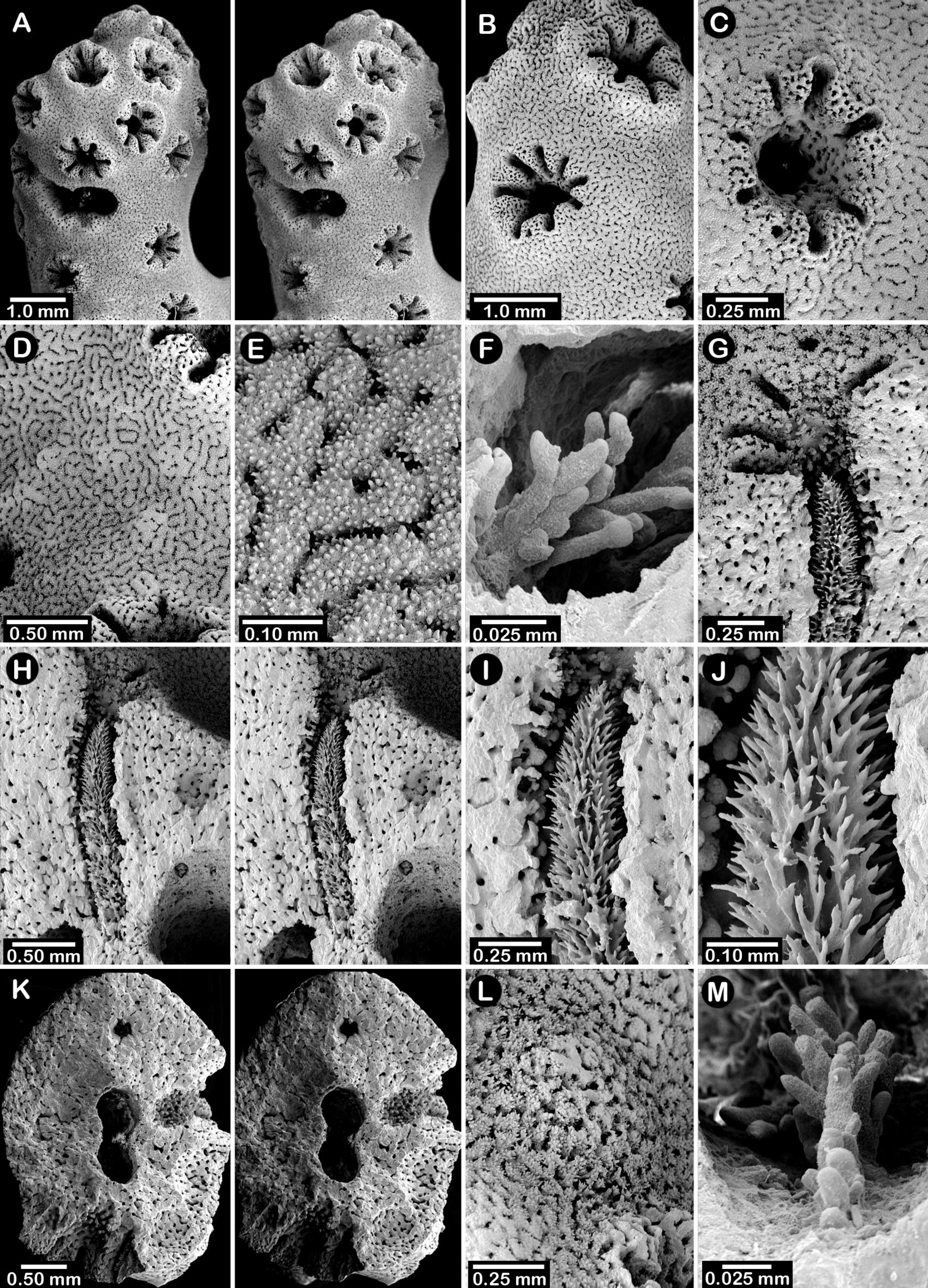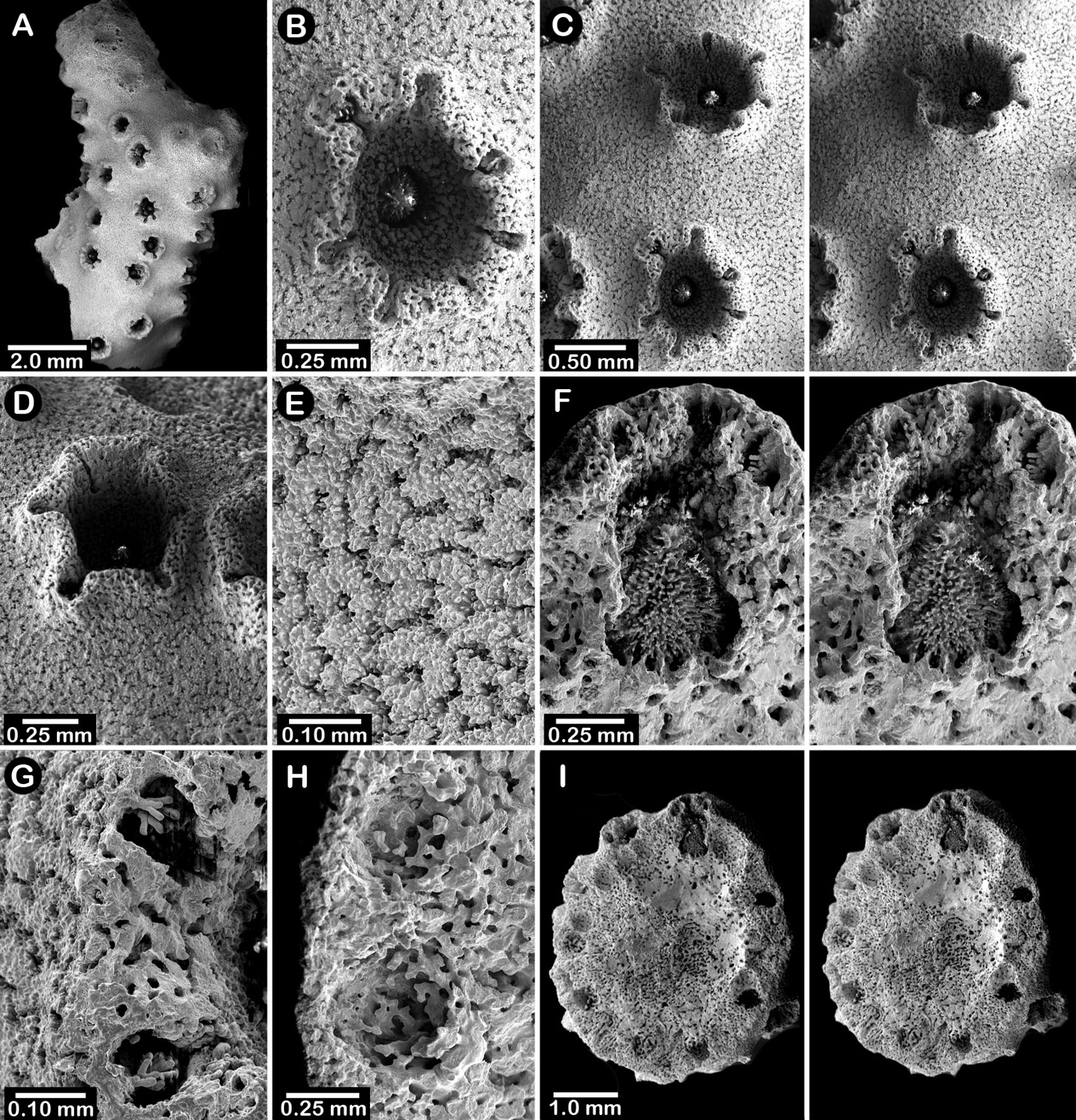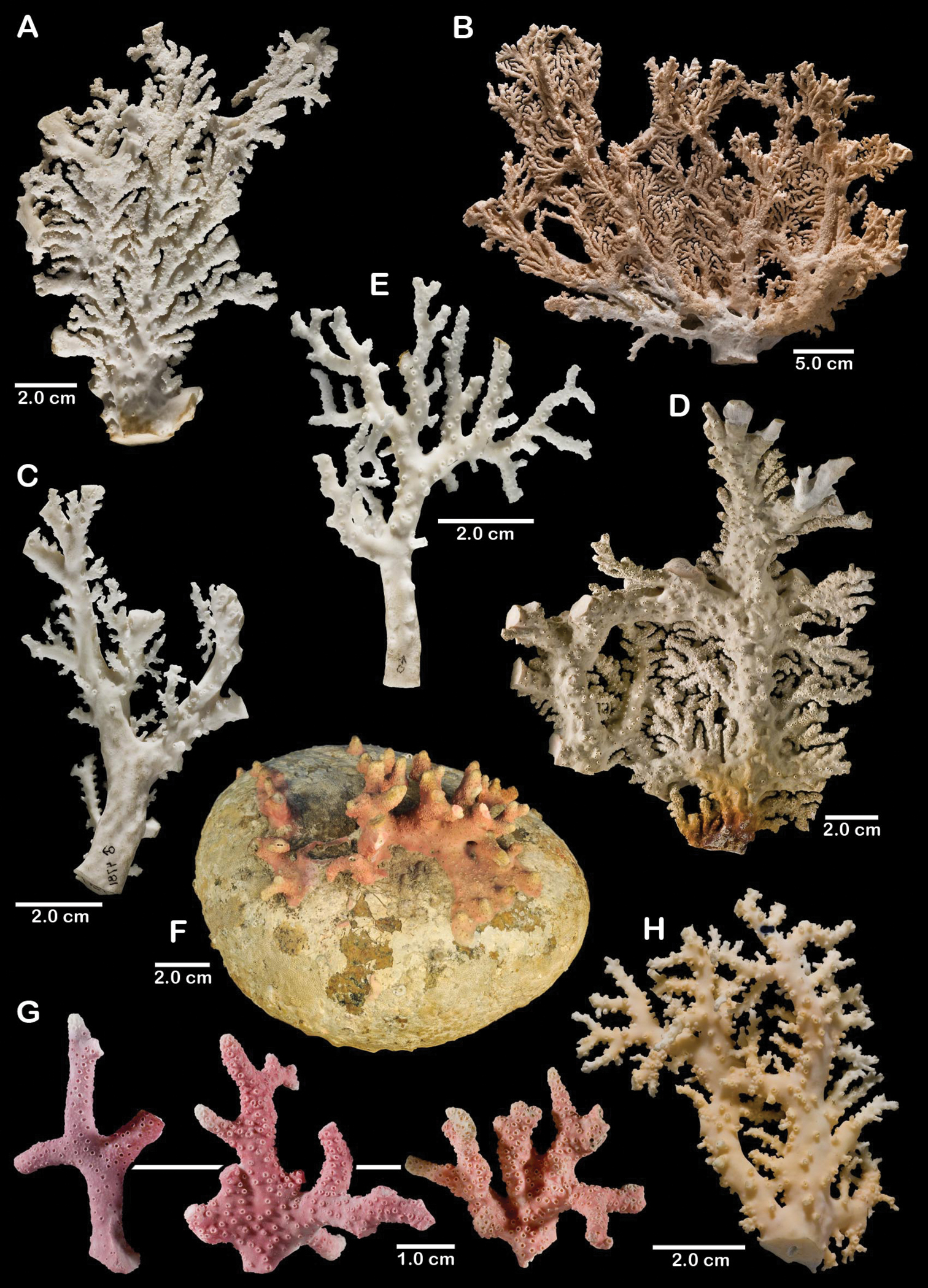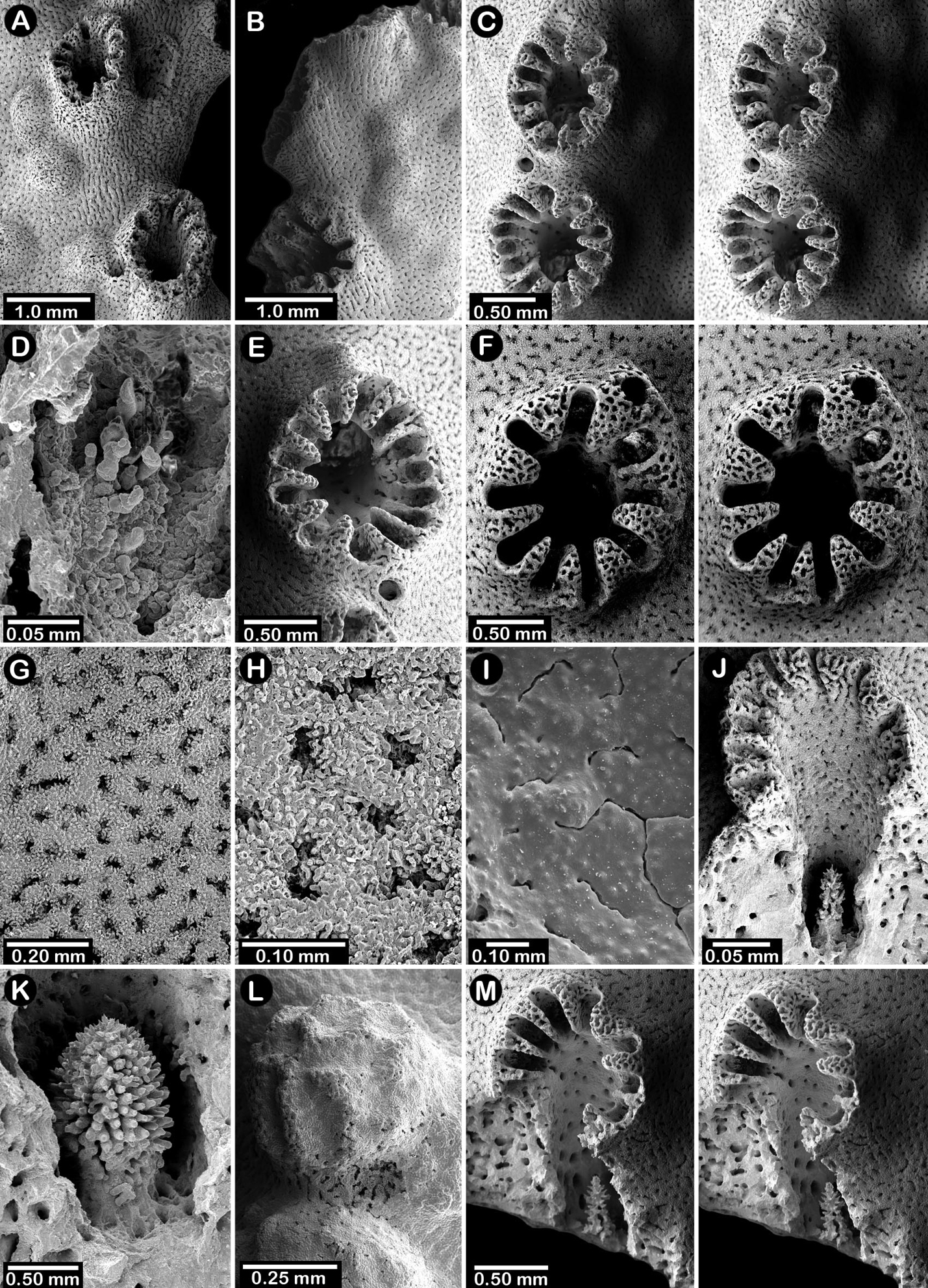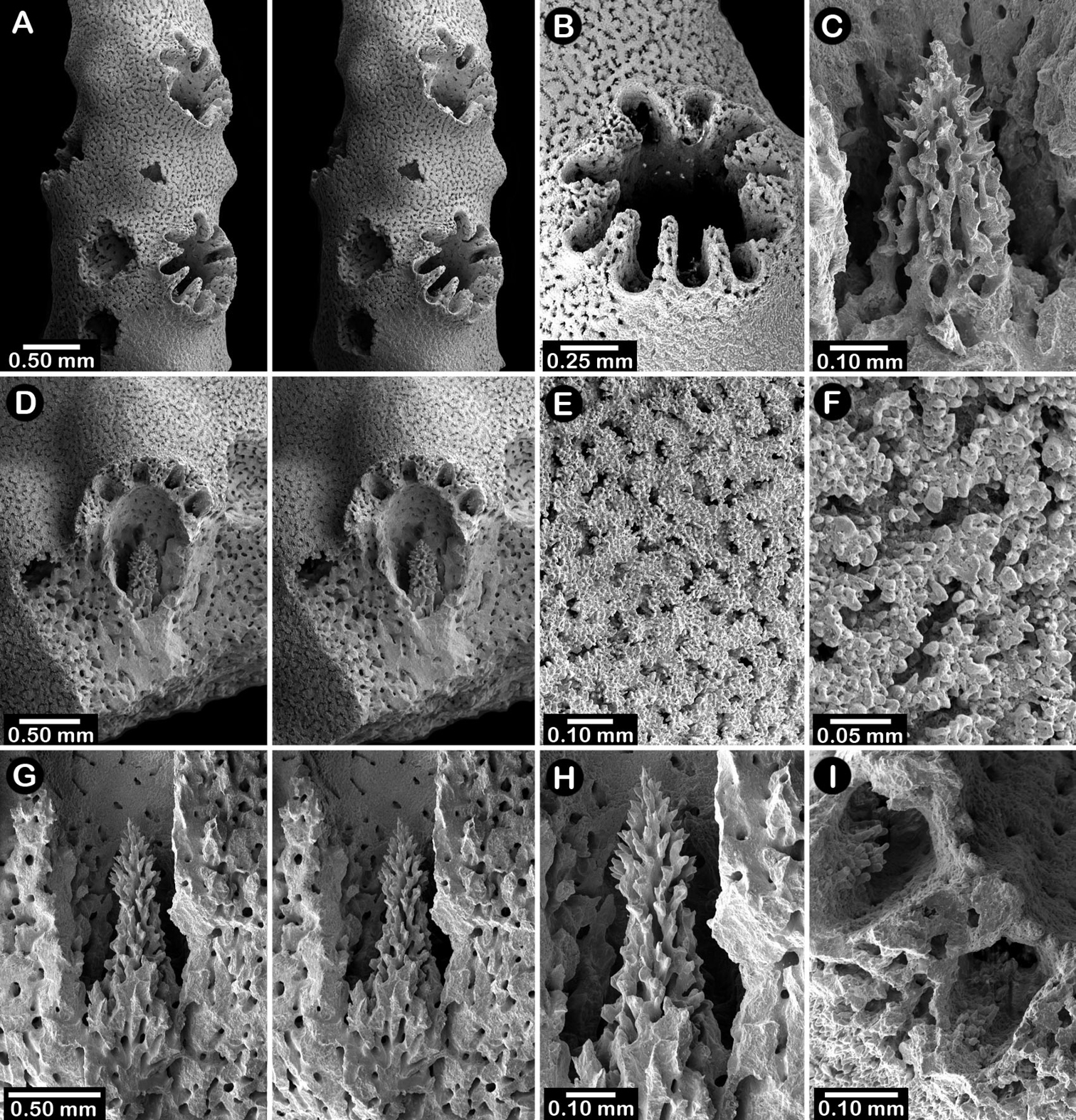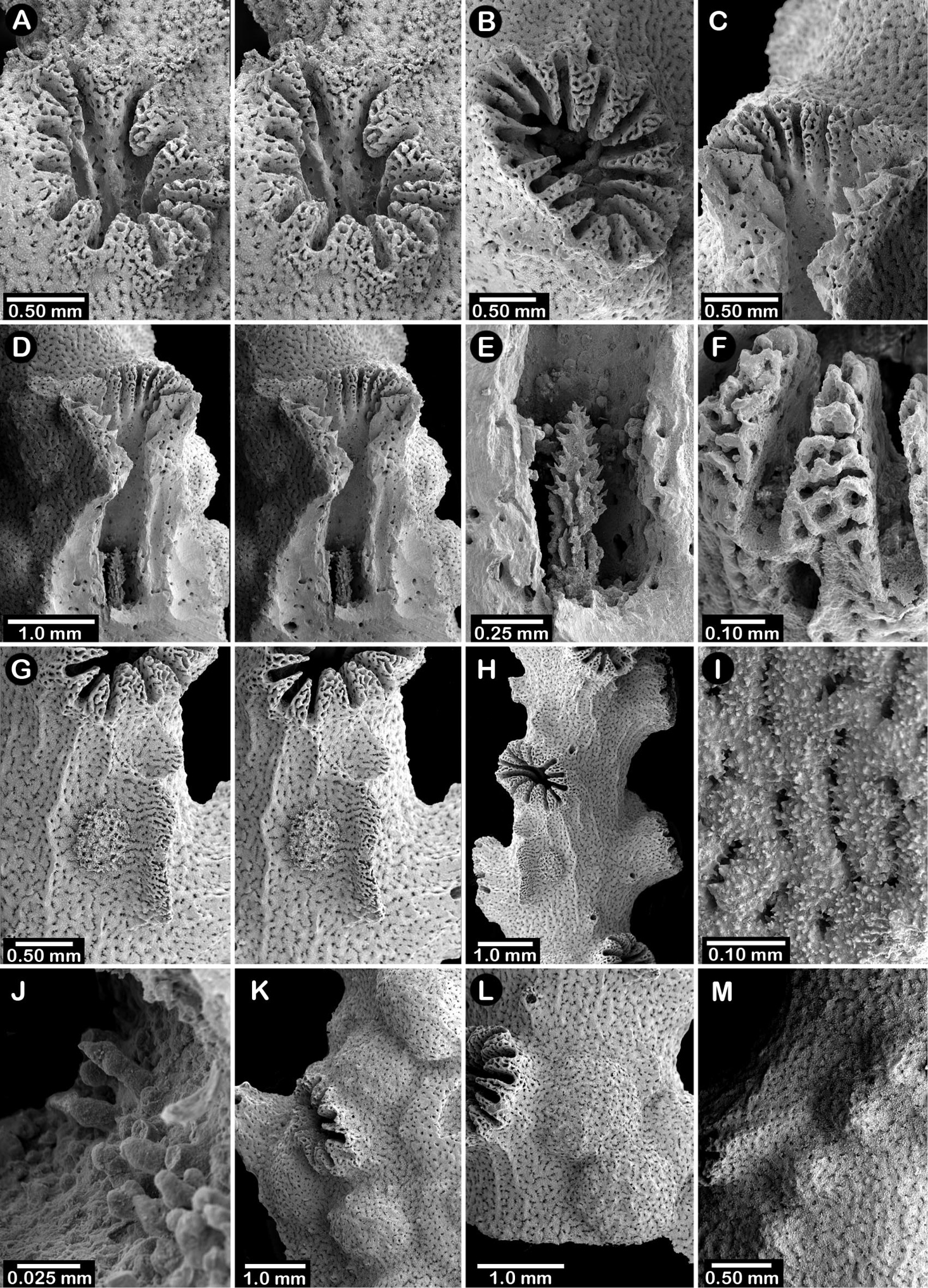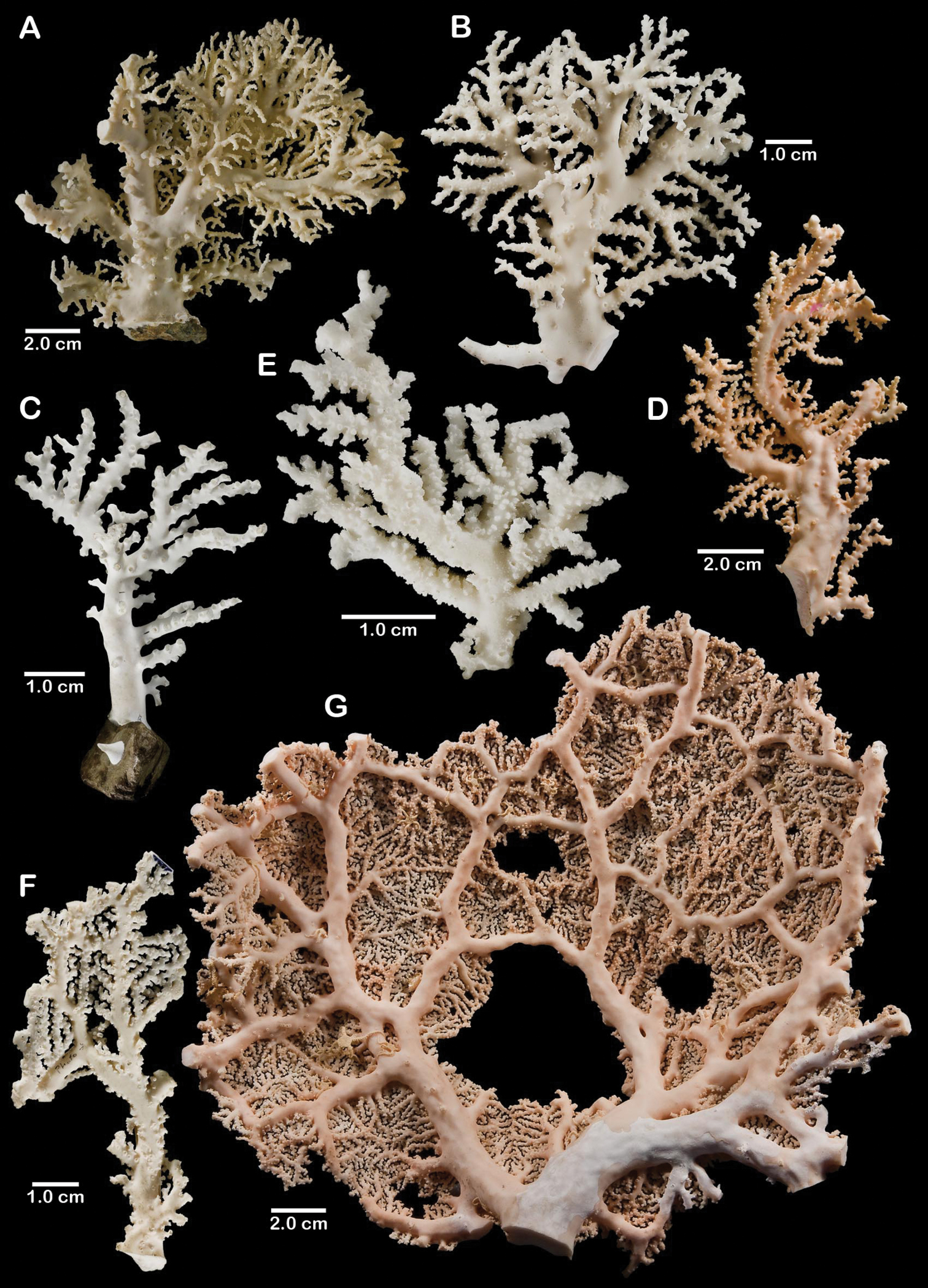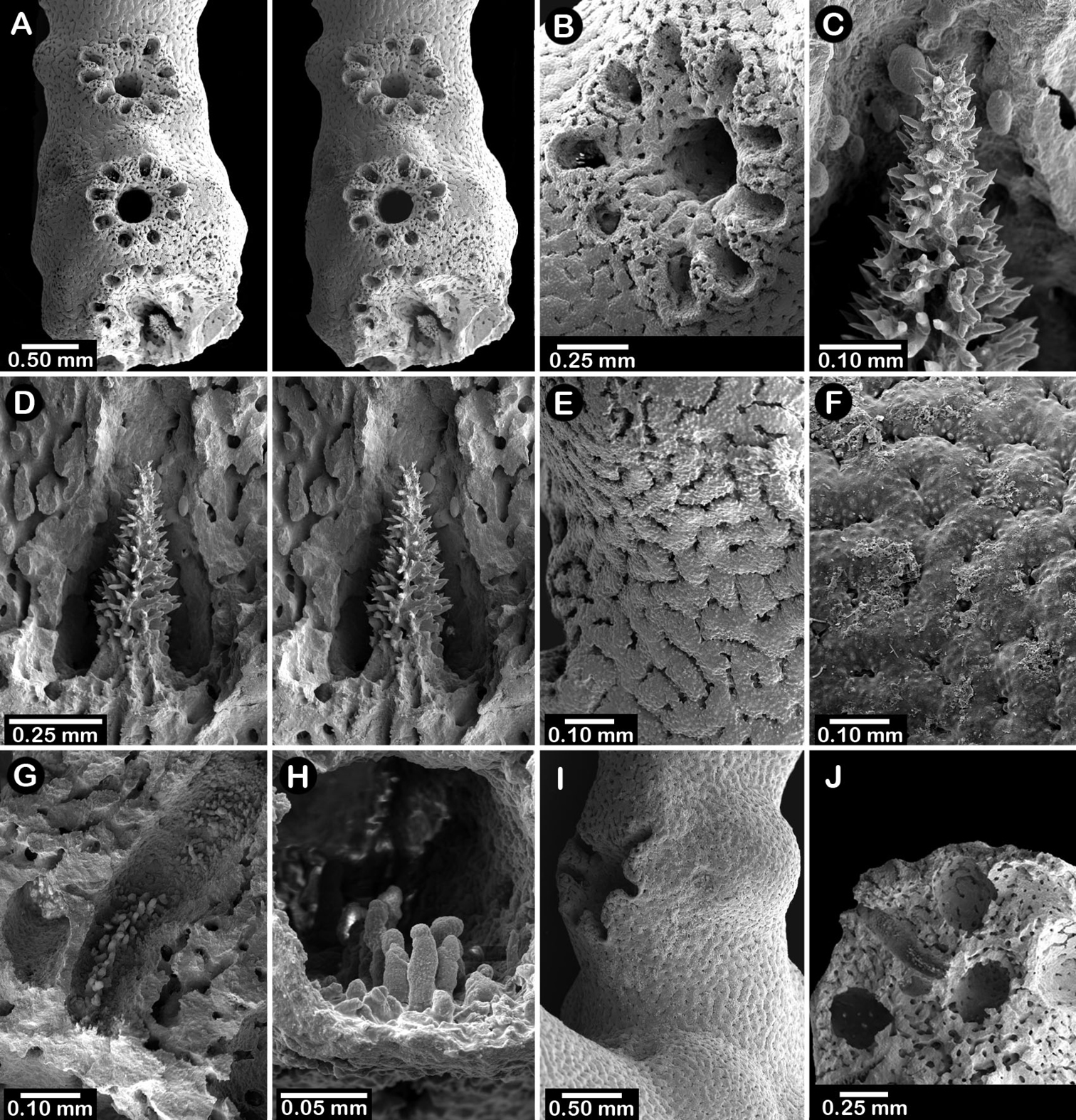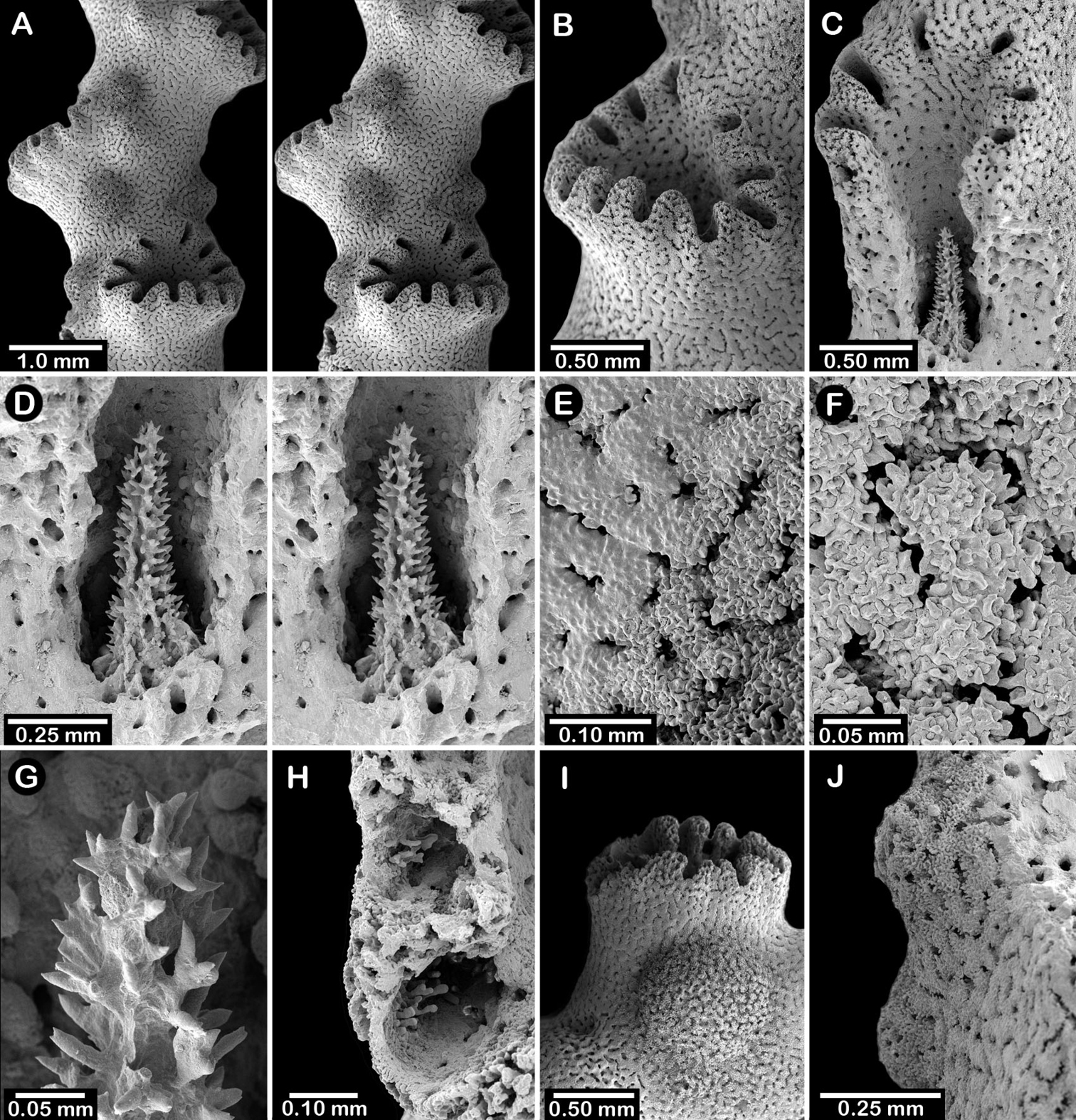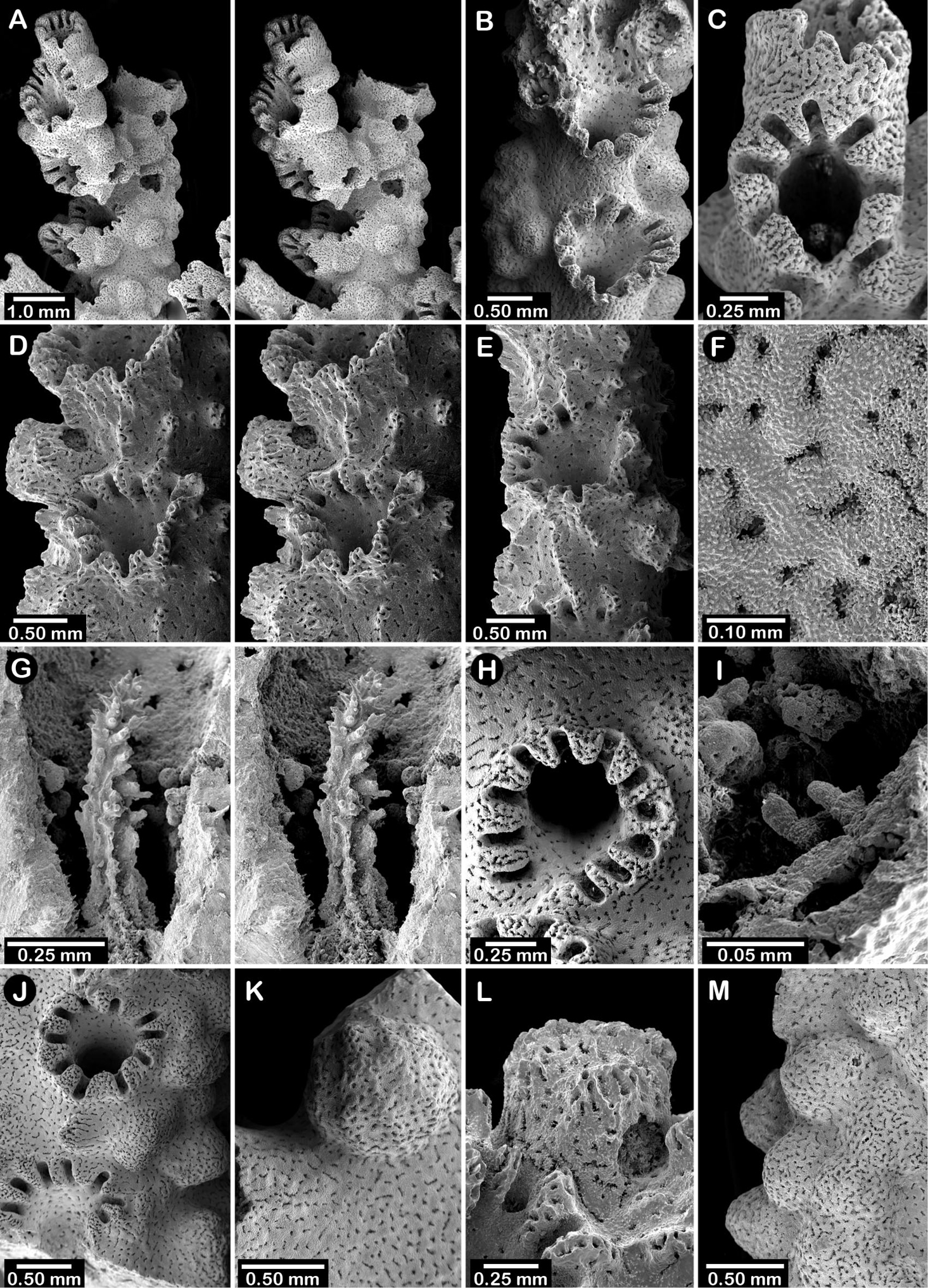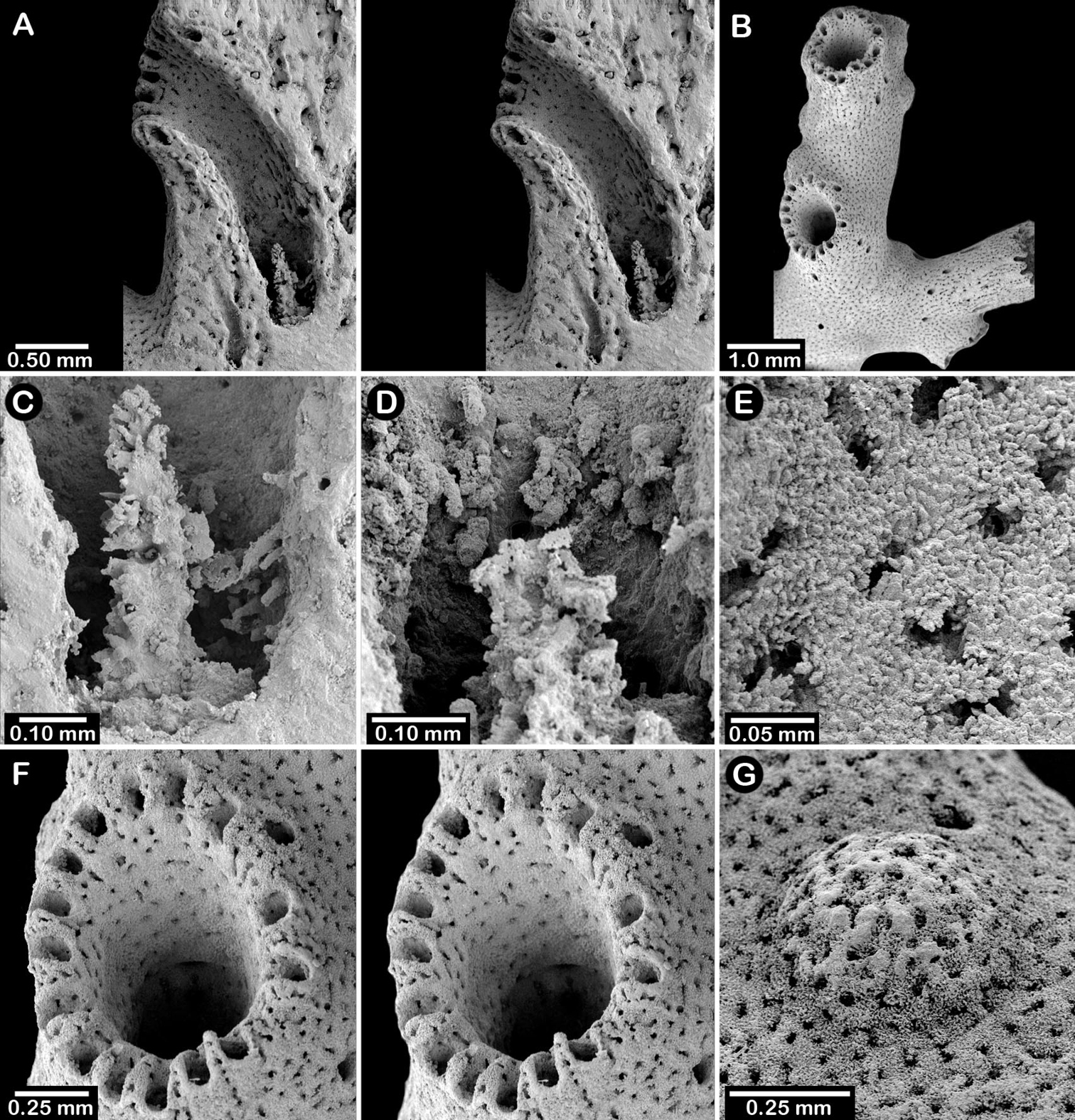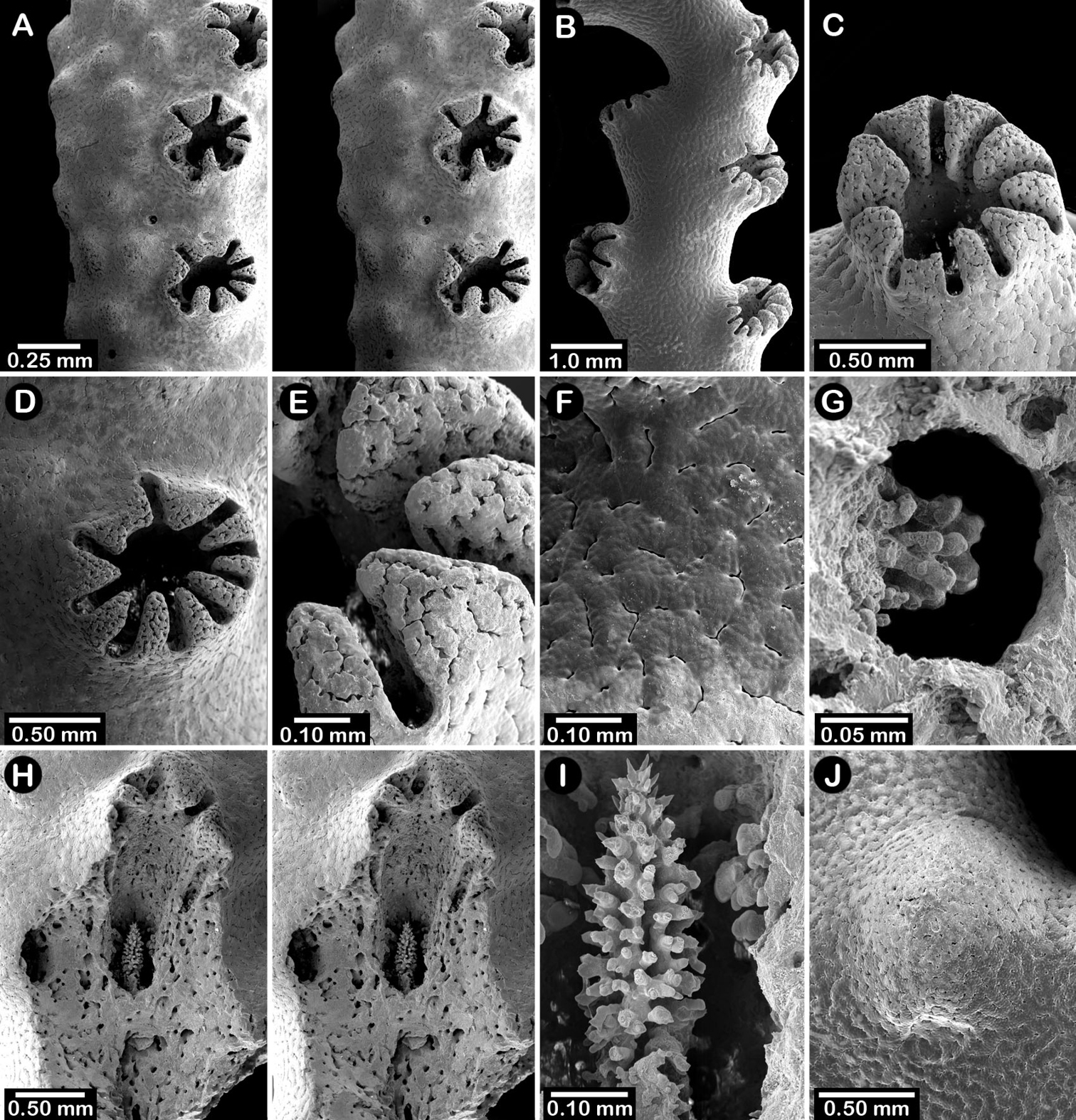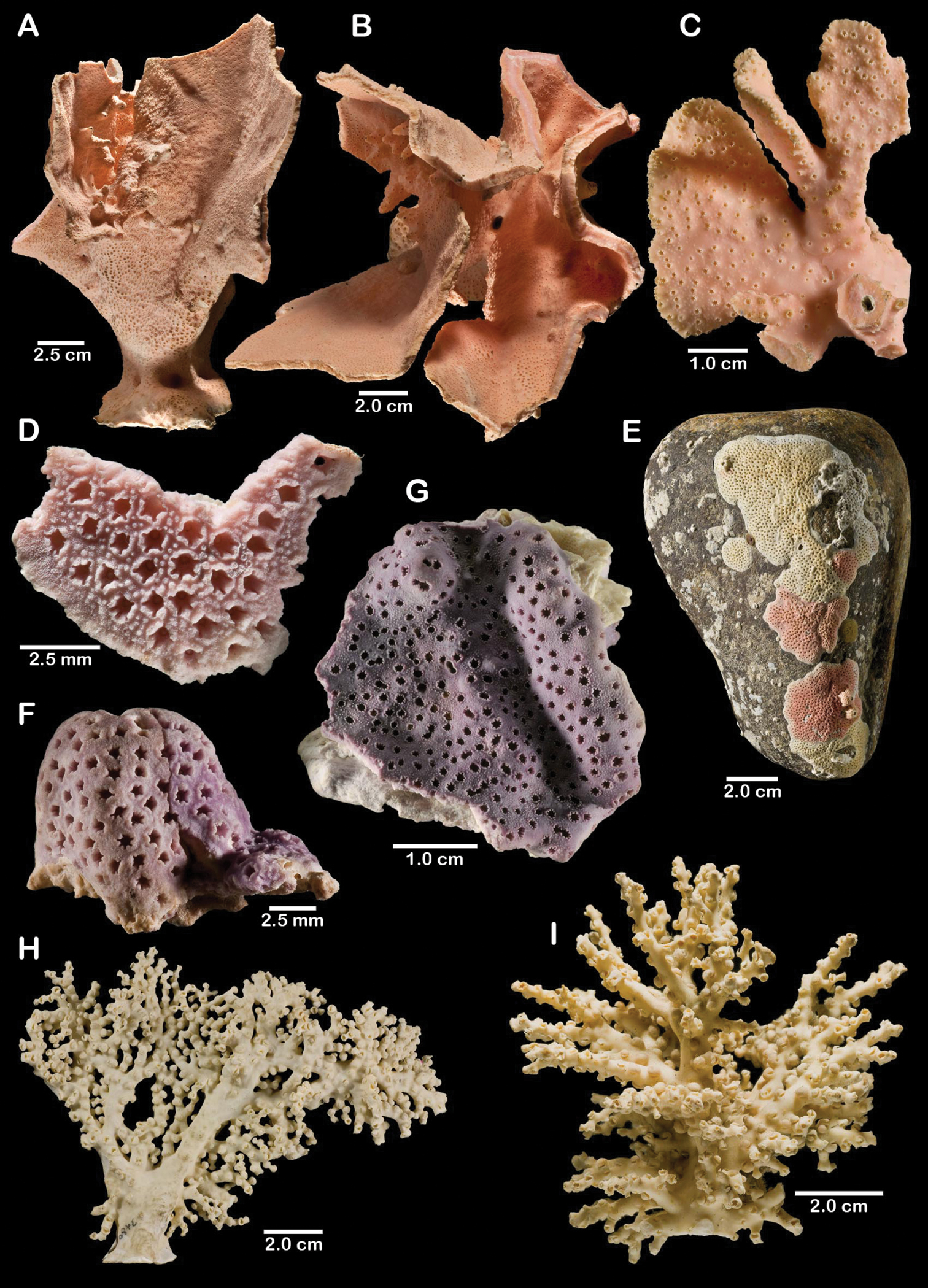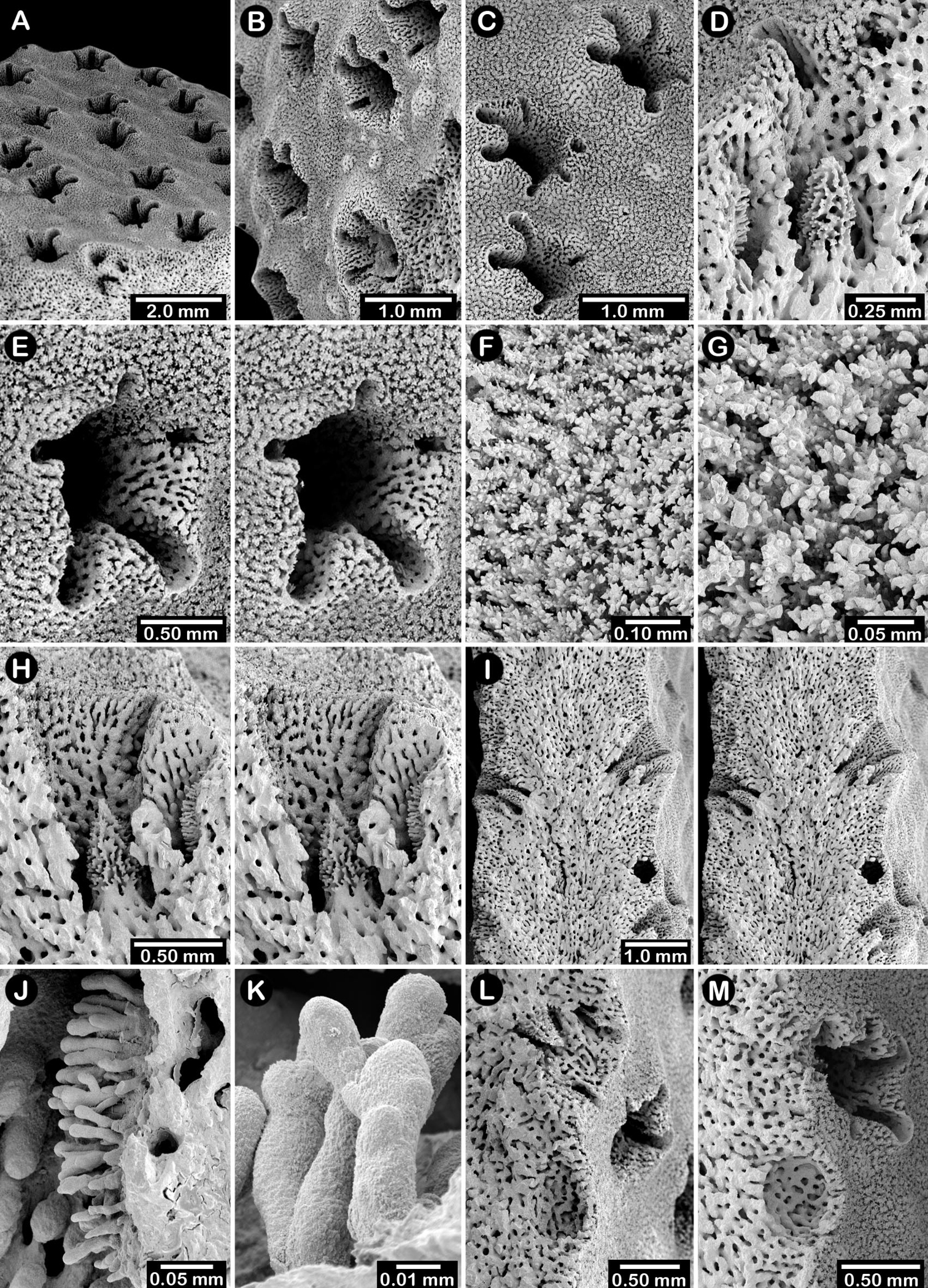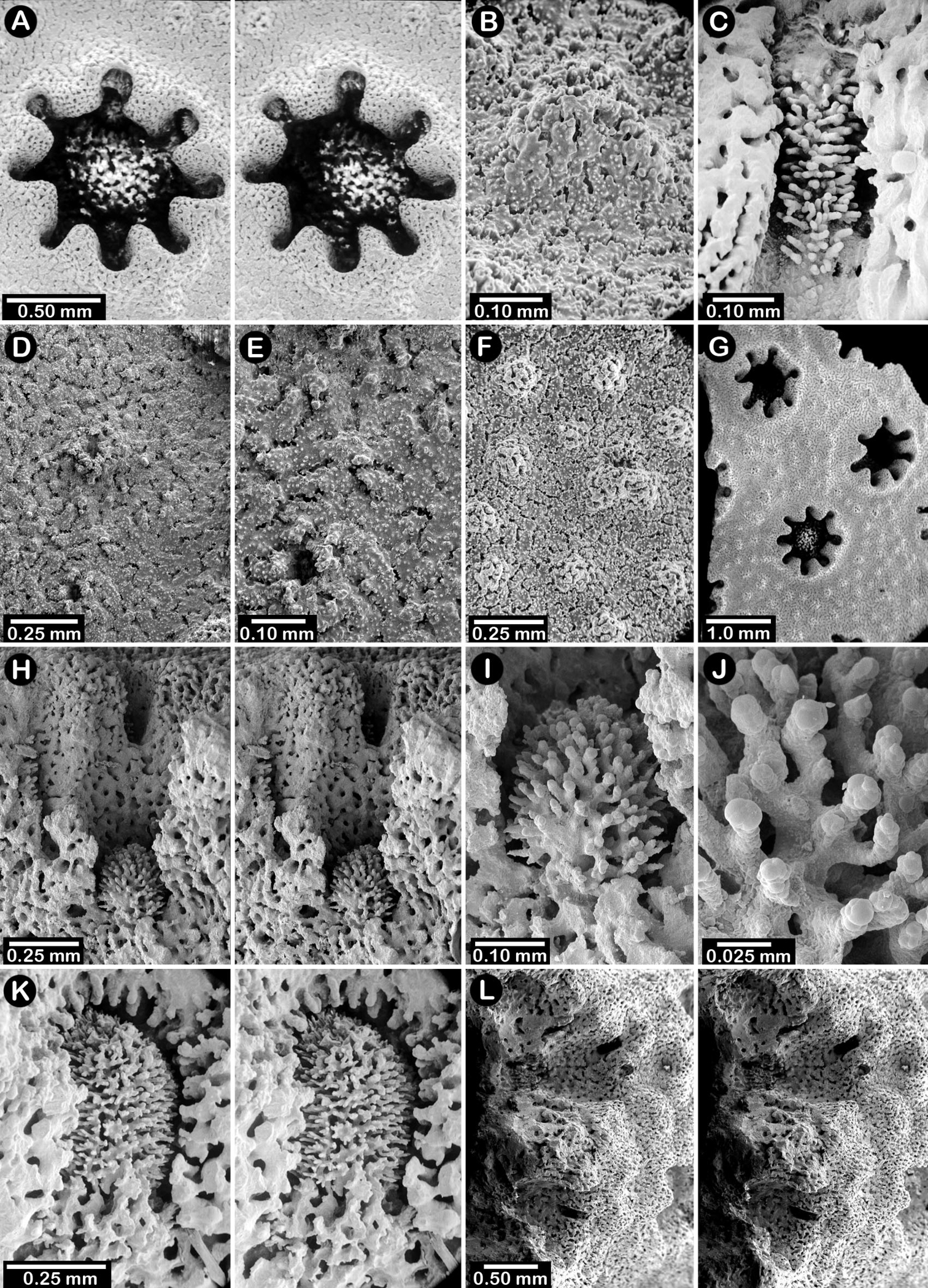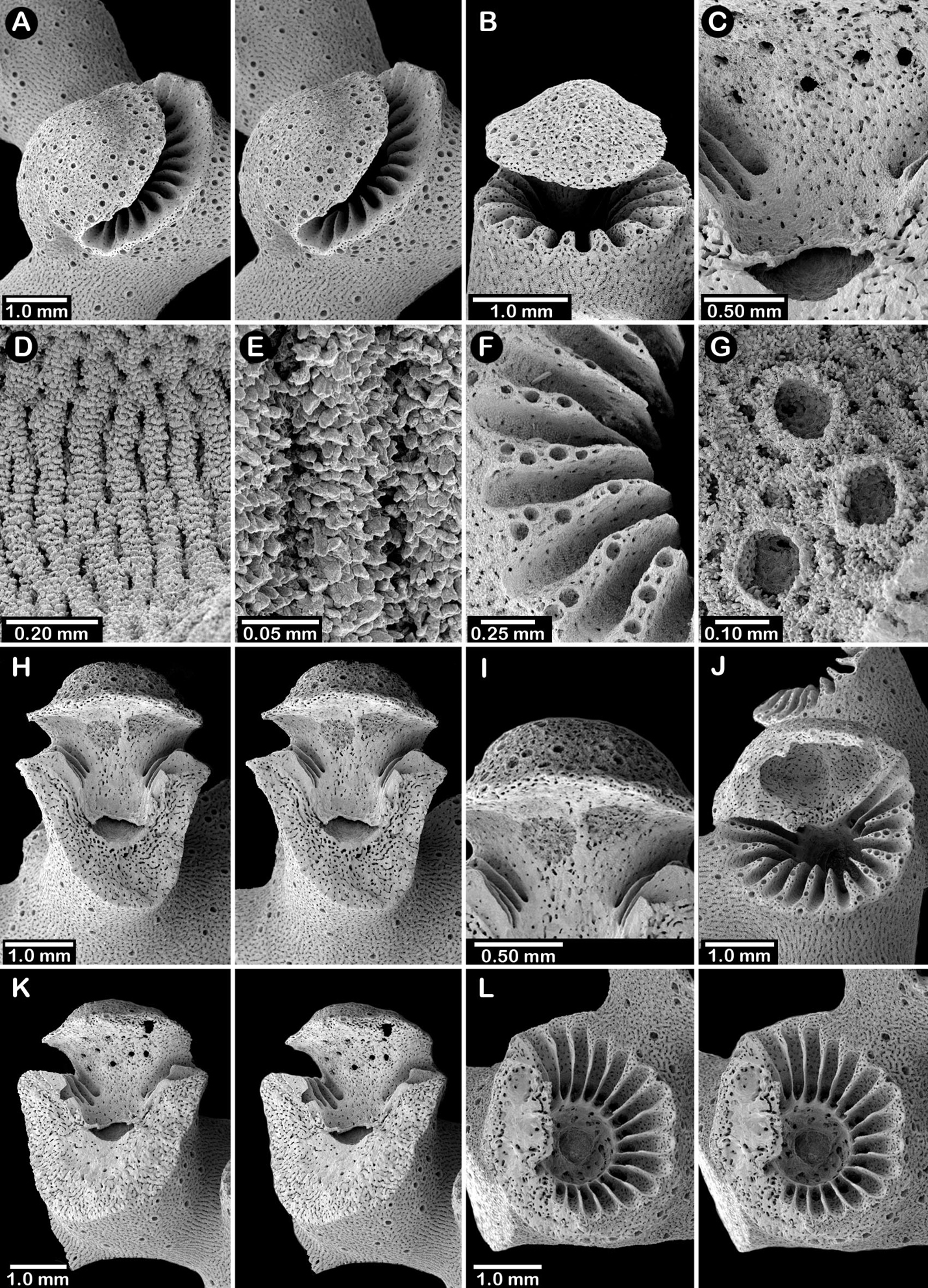






(C) 2011 Stephen D. Cairns. This is an open access article distributed under the terms of the Creative Commons Attribution License 3.0 (CC-BY), which permits unrestricted use, distribution, and reproduction in any medium, provided the original author and source are credited.
For reference, use of the paginated PDF or printed version of this article is recommended.
The stylasterid fauna of Alaska is revised, consisting of the description or redescription and illustration of 21 species, one additional subspecies, and a geographically adjacent species: Stylaster venustus. Six new species and one new subspecies are described: Errinopora fisheri, Errinopora undulata, Errinopora disticha, Errinopora dichotoma, Stylaster crassiseptum, Stylaster repandus, and Stylaster parageus columbiensis. Four subspecies are raised to species rank: Stylaster leptostylus, Stylaster trachystomus, Stylaster parageus, and Distichopora japonica, and five species and one subspecies were synonymized. A dichotomous key to the Errinopora species and tabular keys to the Errinopora and Alaskan Stylaster species are provided. The focus of the study was on the stylasterids from Alaska, primarily those from the diverse Aleutian Islands, but also including records from British Columbia. This is the first revisionary work on this fauna since the seminal report by Fisher in
Stylasteridae, Hydrozoa, Cnidaria, Aleutian Islands, Alaska, British Columbia, Stylaster, Errinopora
The history of the published information about Alaskan stylasterids is not long. The first stylasterids to be reported from off Alaska were beach-worn specimens or coralla obtained from very shallow water from the Aleutian Islands and the Alaskan Peninsula (
The major contributor to this fauna, however, was W. K.
Although no specimens were reported from the Aleutians,
Twenty years ago,
Abbreviations:
AB Auke Bay Marine Lab (NOAA), Juneau, Alaska
AL Alberto Lindner
Alb USFWS Albatross
CAS California Academy of Sciences, San Francisco
coll. private collector
FOMC Fiber Optic Monitoring Cruise of 2008
GM Geologisk Museum ved København Universitet, Copenhagen, Denmark
H:D Height to Diameter ratio of a gastrostyle
indet. gender indeterminate
MCZ Museum of Comparative Zoology at Harvard, Cambridge
MF Miller Freeman
NMNH National Museum of Natural History, Smithsonian Institution, Washington, DC
NOAA United States National Oceanic and Atmospheric Administration
RACE Resource Assessment and Conservation Engineering
USNM United States National Museum (now the NMNH)
WoRMS World Register of Marine Species
Specimens were obtained from collections deposited at the following institutions: CAS; MCZ; GM; and the NMNH. Specimens were also collected by one of us (AL) during NOAA’s RACE bottom trawling survey off the Gulf of Alaska and the Aleutian Islands in 2001 and 2002. Additional specimens were provided by Mr. Arthur Schultz and by NOAA’s Alaska Fisheries Science Center. We examined type specimens of all species reported herein.
Specimens were studied using scanning electron microscopy using the methodology as described by
The specimens on which this study was based resulted from collections from both the United States government and university vessels as well as from privately owned fishing vessels, the latter often having many with colourful names. The US research vessels owned by the US Government are the Albatross and the Miller Freeman, whereas fishing vessels temporarily chartered by the US Government (for NOAA’s RACE surveys) included: Dominator, Sea Storm, Pacific Knight, and the Vesteraalen. Additional private fishing vessels included: Alaska Beauty, Alaska Sea, AlaskaTrojan, Alaskan Leader, Ballyhoo, Delta Alfa, North Pacific, Ocean Olympic, Patricia Lee, and Shishaldin. Additionaly, the manned submersible Delta and the Remotely Operated Vehicles Jason II and Ropos were also used to collect specimens as part of NOAA expeditions. The types of all species known from have been examined with the only exception of Allopora abei. All of these types are deposited at the NMNH and a subset at the CAS. Unless otherwise stated, the condition of specimens examined is assumed to be in the dry state.
TaxonomyFamily Stylasteridae Gray, 1847
Colonies usually flabellate, with blunt branch tips. Coenosteum reticulate-granular and of many colors. Gastropores aligned along branch edge or, more rarely, meandering in lines on colony faces, the gastropore rows flanked (usually on both sides) by rows of horseshoe-shaped dactylopore spines. Gastro- and dactylopore tubes axial, extending along branch axis. Dactylostyles absent. Gastrostyles elongate (needle-shaped), often stabilized by transverse tabulae; a diffuse ring palisade sometimes present. Ampullae usually superficial and clustered.
Equally diverse in tropical and temperate waters as well as in shallow and deep environments, Distichopora is known from 26 Recent species and two fossil species (see
Millepora violacea Pallas, 1766, by monotypy.
Eocene to Recent: cosmopolitan except for off Antarctica, 1-806 m.
http://species-id.net/wiki/Distichopora_borealis
Figs 1A–C, 2A–KHolotype, Alb-3480, a female colony (dry) of 9 cm length (USNM 43274, Fig. 1B). Paratypes, Alb-3480, include 3 male, 4 female, 1 indeterminate dry colonies, and SEM stubs 1489–1494 (USNM 76810) and 2 dry female colonies from Alb-4781 (USNM 76375).
Alb-3480: 52°06'00"N, 171°45'00"W (Amukta Pass, Aleutian Islands), 518 m.
Alaskan Leader 40, 52°09'18"N, 175°40'42"W, 174 m, 8 Jun 2002, 1 female and 1 male, USNM 1122542; Alaskan Leader 54–14, 51°44.4'N, 178°16.7'W, 567–680 m, 11 Jun 2002, 6 indet., AB02–29; Alaska Trojan, 51°24'47"N, 178°50'02"W, 640 m, 2 Feb 2000, 1 female, USNM1122447; Ballyhoo, 54°49'52"N, 178°43'14"E, 236, 7 June 2000, 1 female, USNM 1122565; Delta 5600, 52°33'47"N, 179°26'45"W, 225 m, 15 Jul 2002, 1 male, USNM 1122543; Dominator 971–181, 51°27'43"N, 178°35'20"E, 384 m, 27 Jul 1997, 1 female and 1 male, USNM 1123357; Dominator 971–219, 53°00'03"N, 172°18.86'E, 223 m, 4 Aug 1997, 1 female, 2 male, USNM 1123358; Jason2–2103–7-4, 51°47.898'N, 179°57.169'E, 1267 m, 1 female, AB08–0036; MF 70, 52°03'24"N, 179°25'06"E, 174 m, 1 male, USNM 77047; Ocean Olympic, 52°04.78'N, 177°13.39'E, 256 m, 1 male, AB00–57; Ocean Olympic, 52°08.67'N, 176°35.46'E, 292 m, 1 female, AB00–21; Ommaney 8, 56°11'42"N, 135°06'31"W, 53 m, 17 Aug 2006, 1 female in alcohol, USNM 1086324; Patricia Lee, 51°53.44'N, 179°47.7'E, 298 m, 1 indet., AB00–41; Sea Storm 36, 53°05'45"N, 171°41'56"E, 458 m, 19 Jun 2002, 1 female and 1 male in alcohol, USNM 1076507 and 1122770; Sea Strom 92, 51°33'34"N, 177°36'59"W, 367 m, 4 Jul 2002, 7 males, USNM 1137601, 1123541, 1122874–76; Sea Storm 93, 51°50'59"N, 178°26'02"E, 390 m, 5 Jul 2002, 2 male, USNM 1122877 and 1123287; Sea Storm 105, 52°08'59"N, 176°02'17"E, 201 m, 8 Jul 2002, 2 female in alcohol, USNM 1122884; Sea Storm 106, 52°10'46"N, 175°10'34"E, 165 m, 8 Jul 2002, 1 female and 1 male in alcohol, USNM 1122885 and 1123288; Sea Storm 107, 52°10'28"N, 175°14'14"E, 214 m, 8 Jul 2002, 4 female and 2 males in alcohol, USNM 1122866–70; Sea Storm 108, 52°11'32"N, 175°17'E, 208 m, 8 Jul 2002, 1 female and 3 males, USNM 1122862–65; Sea Storm 109, 52°17'16"N, 175°20'56"E, 238 m, 8 Jul 2002, 6 female, 8 male, 3 indet. in alcohol, USNM 1122886 and 1123289; Sea Storm 122, 52°02'49"N, 175°16'54"E, 143 m, 13 Jul 2002, 2 female and 7 males, USNM 1122858–61; Sea Storm 132, 52°12'02"N, 176°05'56"E, 150 m, 15 Jul 2002, 1 female in alcohol, USNM 1122854; Sea Storm 133, 52°13'40"N, 176°02'13"E, 148 m, 15 Jul 2002, 1 male, 2 females in alcohol, USNM 1122855–57; Sea Storm 149, 52°30'15"N, 173°33'03"W, 239 m, 21 Jul 2002, 1 male in alcohol, USNM 1122883; Sea Storm 151, 52°33'40"N, 173°33'03"W, 203 m, 21 Jul 2002, 1 female and 2 male, USNM 1122878–80; Sea Storm 155, 52°38'43'N, 173°34'31"W, 393–401 m, 22 Jul 2002, 1 male and 1 indet., USNM 1122881–82; Shishaldin, 53°56'24"N, 179°49'31"E, 318 m, 14 Mar 2000, 1 female and 1 male, USNM 1122549; Shishaldin, 54°07'N, 179°45'E, 366 m, 20 Feb 2000, 1 female and 1 male, USNM 1122544–455; Shishaldin, 54°23'29"N, 179°19'46"E, 413 m, 12 Feb 2000, 1 male, USNM 1122548; Vesteraalen 941–165, 51°34'N, 178°19'E, 470 m, 18 Jul 1994, 1 female and 1 male, USNM 96247; Slear, coll., 51°59'52"N, 176°47'05"E, 241 m, 13 Nov 2000, 1 male, USNM 1122458; University of Washington, 51°32'N, 179°15'W, 278–289 m, 1 Sep 1968, 1 female, USNM 76377; 54°20'15"N, 133°03'19"W, 457–466 m, 1 Sep 2002, 1 female, USNM 1123535; 51°13'43"N, 179°49'31"E, 465–529 m, 13 Jun 2000, 1 male, USNM 1137421.
Colonies usually uniplanar (Fig. 1B), but occasionally multiplanar or arborescent (Fig. 1A, C). Largest specimen examined (USNM 1122542, Fig. 1C) 11 cm tall and 20 cm broad, having a basal diameter of 3 cm, colonies broader than tall not uncommon. Base of colony broadly encrusting. Branching irregularly dichotomous, occasionally anastomotic. Large basal branches circular to elliptical in cross section, but terminal branches have flattened faces, thus rectangular in cross section. Branch tips blunt and rounded. Coenosteum white to light orange, the latter usually having branches with a white core. Coenosteum reticulate-granular in texture, the strips being 0.10-0.14 mm in width, each strip covered with tall (22 µm tall, 9 µm in diameter), slender granules arranged 8-10 across the width of a strip. Faces of distal branches often bear longitudinal ridges (Fig. 2A, D, K), some ridges up to 4 mm in length, sometimes ending distally in what appears to be a dactylopore opening (Fig. 2D).
Pore rows well defined (Fig. 2B), 1.0–1.3 mm in width, and restricted to lateral branch edges, although isolated rows and some irregularities may occur proximally on large colonies. Gastropores linearly arranged in a shallow sulcus, closely spaced (approximately 12–16 per cm), and circular in shape, measuring 0.33–0.41 mm in diameter. Gastropore tubes long and slightly curved, a diffuse ring palisade present near gastrostyle tip, the elements globular and about 30 µm in diameter; tabulae absent. Gastrostyles long, slender, and fragile, up to 1 mm in length and 0.09 mm in diameter, having high H:W ratios up to 8-10. Gastrostyles longitudinally ridged and bear numerous long slender spines up to 0.07 mm in length and 10–12 µm in diameter. U-shaped dactylopore spines arranged on both sides of gastropore row, but often more common on one side than the other, e.g., 18-20 dactylopore spines on one side opposite 28-40 spines on other side. Dactylopore spines up to 0.4 mm tall and 0.25-0.30 mm in width, with a dactylotome width of 0.07-0.08 mm, always directed toward or slightly obliquely to the adjacent gastropore. Dactylostyles absent.
Female ampullae (Fig. 2J) prominent, superficial, hemispherical mounds clustered on branch faces, 1.0–1.5 mm in diameter. Ampullae usually covered by low ridges, either radiating from the central apex or arranged in parallel, longitudinal rows aligned with branch axis. Lateral efferent pores 0.25–0.30 mm in diameter. Male ampullae (Fig. 2K) also superficial mounds, but mostly embedded in coenosteum (internal), also occurring in clusters on branch faces. Male ampullae irregular in shape, often with an apical tip, and smaller than female ampullae (0.35–0.45 mm in diameter).
Among the 26 Recent species of Distichopora (see
Common in the Aleutian Islands from the Near Islands to Amukta Pass, including Bowers Bank; off Cape Ommaney, Alexander Archipelago, and Dixon Entrance, Queen Charlotte Islands; 53–1267 m, the shallowest record being from Cape Ommaney.
Color figures of skeleton of various Alaskan stylasterids: A–C Distichopora borealis D–I Cyclohelia lamellata A arborescent colony, USNM 1122878 B holotype, USNM 43274 C largest known colony, USNM 1122542 D holotype, USNM 85077 E digitate form, USNM 1122492 F intermediate form between lamellar and digitate, USNM 96236 G juvenile corallum H–I side and apical views of fully developed lamellar colony.
Paratypes of Distichopora borealis, USNM 76810: A stereo view of carinate branch face B–C pore row, B being a stereo view D branch face with longitudinal ridges E–F coenosteal texture G gastropore H dactylopore spine I stereo view of two gastrostyles J stereo view of pore row and female ampullae K stereo view of branch face and male ampullae.
Colonies lamellar, often attaining a large size. Coenosteum reticulate-granular, reddish-orange. Gastro- and dactylopores uniformly distributed on corallum faces, of the axial type. Dactylopore spines circular to elliptical, enclosed by a thin wall for entire perimeter. Dactylostyles absent. Gastrostyles elongate but tabulae absent; a diffuse ring palisade present. Ampullae internal.
The genus is monotypic. According to the molecular analysis of
Cyclohelia lamellata Cairns, 1991, by original designation.
Known only from the Aleutian Islands and Pribilof Islands, 27–567 m.
http://species-id.net/wiki/Cyclohelia_lamellata
Figs 1D–I, 3A–CThe holotype, a dry female colony (USNM 85077, Fig. 1D). Type locality. Off Pribilof Islands, 550 m.
Alaskan Leader 35, 53°01'48"N, 170°06'12"W, 172–178 m, 4 Jun 2002, 1 female, 1 male, USNM 1122491; Alaskan Leader, 54–14, 51°44.4'N, 178°16.7'W, 567–680 m, 11 Jun 2002, 1 female, AB02–0029; Alaska Beauty, 51°42.43'N, 176°56.05'E, 351 m, 3 Feb 2000, 1 female, AB00–15; Delta 5999–8E-5, 52°21.042'N, 179°30.483'W, 115 m, 4 Jul 2003, 3 fragments, AB10–0001; Delta 6000–10D-2, 51°50.8545'N, 179°49.6488'E, 150 m, 5 Jul 2003, 1 indet., AB; Delta 6001–10C-1, 51°52.396'N, 179°46.191'E, 230 m, 5 Jul 2003, 1 female, AB; Delta 6213–12B-1 , 2 and 4, 6 males, AB; Delta, 51°50'55"N, 179°48'35"W, 125 m, 17 Jul 2002, 1 female in alcohol (digitate form), USNM 1122494; North Pacific, 52°04.28'N, 176°05.35'E, 366 m, 1 indet., AB00–28; Ocean Olympic, 52°11.89'N, 176°17.3'E, 366 m, 20 Oct 2000, 1 female (digitate form), USNM 1122513; Pacific Knight 941–121, 51°38'00"N, 178°19'00"W, 0–373 m, 5 Jul 1994, 1 female and 1 male, USNM 96235 and 1122900; Pacific Knight 941–179, 52°00'N, 176°44'E, 0–90 m, 23 Jul 1994, 1 female (intermediate form), USNM 96236; Patricia Lee, 51°18'42"N, 179°30'04"E, 329 m, 20 Oct 2000, 1 male, USNM 1122488; Patricia Lee 51°53.44'N, 179°47.7'E, 298 m, 3 male, SEM stub 1488, AB00–41; Sea Storm 107, 52°10'28"N, 175°14'14"E, 214 m, 8 Jul 2002, 1 female in alcohol, USNM 1123297; Sea Storm 108, 52°11'32'N, 175°17'E, 208 m, 8 Jul 2002, 10 female, 6 male, 8 indet. (digitate form) in alcohol and dry, USNM 1122951, -54, -55, -57, -58, -59, 61, 1123290, 91; Sea Storm 111, 52°16'20"N, 175°59'13"E, 137 m, 9 Jul 2002, 1 male in alcohol, USNM 1122949; Sea Storm 112, 52°15'12"N, 176°10'42"E, 137 m, 9 Jul 2002, 1 indet., USNM 1122946; Sea Storm 116, 52°04'10"N, 177°14'25"E, 87–94 m, 11 Jul 2002, 1 male in alcohol (digitate form), USNM 1122942; Sea Storm 122, 52°02'49"N, 179°25'18"E, 143 m, 13 Jul 2002, 8 female, 4 male, 5 indet., USNM 1122899, 1122948, 1123294–96, -98; Sea Storm 123, 52°10'53"N, 179°37'02"E, 124 m, 13 Jul 2002, 2 male, USNM 1122952; Sea Storm 125, 52°12'53"N, 179°56'49"W, 89–96 m, 13 Jul 2002, 1 male, USNM 112305; Vesteraalen 3, 52°38'13"N, 169°47'14"W, 75–83 m, 22 May 2001, 1 male in alcohol, USNM 1076490; Vesteraalen 941–36, 52°56'N, 169°31'W, 0–227 m, 10 Jun 1994, 1 female, USNM 96237; Vesteraalen 941–46, 53°04'N, 170°09'W, 0–174 m, 12 Jun 1994, 1 female, USNM 96238; Vesteraalen 941–153, 52°10'N, 179°43'E, 0–94 m, 11 Jul 1994, 1 male, USNM 96239; “Vessel" 35, 51°45'48"N, 178°09'47"W, 200–400m, 4 Jun 2000, 2 female and 1 male, USNM 1122493; Renfro, coll., 51°56'35"N, 179°17'58"E, 236 m, 1 female, USNM 1122456; coll. Slear, 51°59'52"N, 176°47'05"E, 241 m, 13 Nov 2000, 1 male (digitate form), USNM 1122457; Petrel Bank, 1 male, 1 indet., USNM 1123540; 51°52.11'N, 179°49.51'W, 27 m, 17 Jul 2002, 1 female (digitate form), USNM 1122492.
This species is not redescribed herein as it was adequately described originally (
Colonies are usually firmly attached to a hard substrate by a robust cylindrical base and stem (Fig. 1H) up to 2.5 cm in diameter, which, at the height of about 2 cm, bifurcates into two lamellae or sheets, each sheet increasing its surface area by folding and undulating its surfaces into a complex three dimensional structure. Large colonies may attain a height of about 8 cm and a width of 10 cm, colonies wider than tall being the norm. However, a subset of colonies from seven stations (see Material Examined), termed the “digitate form”, differ from the typical colony morphology in having dissected plates, resulting in numerous flattened lobes and clavate branches (Fig. 1E). Furthermore, one colony (Fig. 1F) is intermediate between these two extremes, suggesting that these shapes are simply variations of the same species.
Male ampullae (Fig. 3A) entirely internal, and elliptical in shape, the greater axis of the ellipse perpendicular to the branch surface, unlike that of the female ampullae. Male ampullae are up to 0.6 mm in greater diameter and 0.45 mm in lesser diameter, occurring in great concentrations and invariably present on almost any broken surface. Each ampulla communicates to the surface by a circular efferent duct, the duct about 0.07–0.09 mm in diameter, which is surrounded by small inward projecting granules, giving the pore a star-shaped appearance (Fig. 3B–C). Of the 81 specimens examined, 34 are female, 29 male, and 18 indeterminate in gender.
In addition to the type locality off the Pribilof Islands, this species is common throughout the Aleutian Islands from the Rat Islands to the Islands of Four Mountains at 27–567 m, although it was more commonly collected from the western part of this range at depths of 100–300 m. The digitate form is known only from the western Aleutian Islands from 27–366 m.
Cyclohelia lamellata, USNM 1122488: A stereo view of male ampullae in cross section B–C male efferent pores.
http://species-id.net/wiki/Errinopora
(emended from
The ten species in this genus are differentiated and compared in both a dichotomous key (see below) and tabular key (Table 1); six of them occur exclusively in the Aleutian Islands. Another species was tentatively assigned to this genus by
Species within Errinopora are unique with the Stylasteridae in having both dimorphic gastro- and dactylopores, a condition first noted by
In comparison to other stylasterid genera, Errinopora is most similar to Gyropora Boschma, 1960, whose only species, Gyropora africana Boschma, 1960, has dactylopore spines and gastropores coordinated in pore rows, as in some species of Errinopora. Errinopora is also similar to Errina Gray, 1835 and Errinopsis Broch, 1935, whose species may also have thick-walled dactylopore spines. None of these genera, however, include species with dactylostyles, as in Errinopora. Among genera with species having dactylostyles, only species of Errinopora, Inferiolabiata Broch, 1951, and Paraerrina Broch, 1942 lack a coordination of gastropores and dactylopores in well-developed cyclosystems (whereas species of Stenohelia Kent, 1870, Stylantheca Fisher, 1931, Stylaster Gray, 1831 and Calyptopora Boschma, 1968 do have both dactylostyles and well-developed cyclosystems). Inferiolabiata differs from Errinopora in many characters, in particular by having thin-walled dactylopore spines (instead of thick-walled) that are markedly truncated at the tip (instead of rounded), whereas Paraerrina Broch, 1942 differs in having delicate dactylostyles (instead of robust) and either flush or only slightly raised dactylopore spines—instead of tall and robust (Cairns 1984,
In an attempt to investigate phylogenetic relationships, 37 partial mitochondrial rDNA 16S sequences were obtained for the six species of Errinopora from the Aleutian Islands, including the holotypes of Errinopora dichotoma, Errinopora disticha, Errinopora fisheri and Errinopora undulata. Based on
Errina pourtalesii Dall, 1884, by original designation.
North Pacific: Aleutian Islands, Kurile Islands, Sea of Okhotsk, Sea of Japan, off California. Subantarctic: off Tierra del Fuego, 40–658 m.
Tabular Key of the Ten Species of Errinopora (pscs = pseudocyclsosystems)
| Errinopora fisheri | Errinopora cestoporina | Errinopora porifera | Errinopora undulata | Errinopora disticha | Errinopora pourtalesii | Errinopora stylifera | Errinopora zarhyncha | Errinopora nanneca | Errinopora dichotoma | |
|---|---|---|---|---|---|---|---|---|---|---|
| Dactylopore Spines | ||||||||||
| Arrangement | Tall terraces and pscs | Tall terraces and pscs | Isolated or short unilateral rows | Pscs and short unilateral rows | Distichoporine rows; pscs at base | Distichoporine rows, unilateral rows, isolated, pscs | Distichoporine rows, pscs at base | Short unilateral rows, isolated | Short unilateral rows, pscs, isolated | Short unilateral rows, isolated |
| Compound Dactylopore Spines | Absent | Absent | Absent | Absent | Present | Present | Absent | Present | Absent | Present |
| Maximum Height | 1.5 mm | 1.3 mm | 0.46 mm | 0.25 mm | 0.5–0.9 mm | 1.1–1.2 mm | 0.5–0.9 mm | to 3 mm | 0.4 mm | 1.2 mm |
| Wall Thickness | Not individualized | Thick | Thin | Thin | Thick | Thick | Thick | Thick | Thick | Thick |
| Dactylotome Shape | Elliptical pores | Slit | Apical pores | Slit | Slit | Slit | Slit | Slit | Slit | Slit |
| External Surface of Dactylopore Spine | Inconspicuously ridged | Reticulate-Granular | Not ridged | Inconspicuosly ridged | Inconspicuously ridged | Inconspicuously ridged | Inconspicuously ridged | Inconspicuously ridged | Prominently ridged | Inconspicuously ridged |
| Dactylostyle | Narrow | Robust | Moderate width | Robust | Robust | Robust | Robust | Narrow | Moderate width | Robust |
| Secondary Dactylopores | Absent | Present | Present | Present | Present | Present | Present | Present | Present | Present |
| Corallum | ||||||||||
| Shape | Uniplanar | Bushy | Uniplanar | Lamellate | Uniplanar | Bushy | Uniplanar | Uniplanar | Uniplanar branching or plate-like | Three dimensional |
| Branch Size | Delicate | Delicate | Delicate | Sheets thin | Robust | Medium | Medium | Large | Delicate | Robust |
| Branch Cross Section | Circular to elliptical | Circular | Circular to slightly elliptical | Lamellar | Flattened | Circular | Circular to slightly elliptical | Circular to elliptical | Circular to lamellar | Circular to slightly elliptical |
| Color | Orange | White | White, light orange | Orange | Light orange | Orange | Orange, yellow | Orange | Orange, pink | Orange |
| Other Characters | ||||||||||
| Gastropore Diameter | 0.3–0.5 mm | 0.30–0.55 mm | 0.23–0.27 mm | 0.30–0.45 mm | 0.3–0.7 mm | 0.20–0.38 mm | 0.4 mm | 0.2–1.1 mm | about 0.2 mm | 0.3–0.5 mm |
| Secondary Gastropores | Absent | Absent | Present | Present | Present | Present | Present | Present | Present | Present |
| Coenosteal Texture | Reticulate-Spinose | Reticulate-Granular | Reticulate-Granular | Reticulate-Spinose | Reticulate-Spinose | Reticulate-Granular | Reticulate-Granular | Reticulate-Spinose | Reticulate-Spinose | Reticulate-Spinose |
| Unique Features | Gastropore tube constricted; ring palisade present; gastrostyles squat | Conical ampullae; coenenchymal papillae; gastrostyle pedicellate | Dactylopore spines conical | Gastrostyles flattened in cross section | Encrusting base | Gastropore tubes commodious | U-shaped branching axils | |||
| Distributon and Depth Range | Aleutian Islands, 455 m | Tierra del Fuego, 359–384 m | Okhotsk Sea, 190–250 m | Aleutian Islands, 350–640 m | Aleutian Islands, 178–536 m | Central California, 49–183 m | Off Japan, Okhotsk Sea, 84–379 m | Aleutian Islands, 207–658 m | Aleutian Islands, 40–517 m | Aleutian Islands, 178–217 m |
Key to the Recent species of Errinopora (bold face = occurs off Alaska)
| 1 | Dactylopore spines arranged in pseudocyclosystems near base but otherwise predominantly laterally fused into tall terraces flanking the lower side (unilateral) of one or a series of gastropores, their dactylotomes facing the gastropores | 2 |
| 1' | Dactylopore spines isolated, and/or arranged in pseudocyclosystems, short unilateral rows, or bilateral (distichoporine) rows | 3 |
| 2 | Individuality of fused dactylopore spines lost, the terraces having a continuous edge and the dactylotomes being elliptical pores; ampullae hemispherical; coenosteum orange; no coenosteal papillae; known only from Alaskan | Errinopora fisheri sp. n. |
| 2' | Fused dactylopore spines retain individuality, terraces having an irregular edge and dactylotomes being traditionally slit like; ampullae conical; coenosteum white; perforated papillae common on coenosteum; known only from the Subantarctic | Errinopora cestoporina Cairns, 1983 |
| 3 | Dactylopore spines predominantly conical, having a circular dactylotome | Errinopora porifera Naumov, 1960 |
| 3' | Dactylopore spines horseshoe-shaped, having a slit-like dactlylotome | 4 |
| 4 | Colonies lamellate (sheet-like) | 5 |
| 4' | Colonies branching | 6 |
| 5 | Colony a continuous, sinuous, thin sheet; pseudocyclosystems predominant form of dactylopore spine arrangement; dactylopore spines very short (0.25 mm) and thin walled | Errinopora undulata sp. n. |
| 5' | Colony a series of dissected blades of a larger sheet; pseudocyclosystems occur only at colony base, transverse rows of dactylopore spines being more common; dactylopore spines short (0.40 mm) and thick walled | Errinopora nanneca Fisher, 1938 (lamellate form) |
| 6 | When arranged in rows, dactylopore spines predominantly in bilateral (distichoporine) rows, the dactylotomes of both rows facing the flanked gastropore row (spines may also be isolated, in pseudocyclosystems, and/or arranged in unilateral rows) | 7 |
| 6' | When arranged in rows, dactylopores spines predominantly in unilateral rows flanking a single row of gastropores, the dactylotomes of only the proximal row facing the gastropores (spines may also be isolated and/or arranged in pseudocyclosystems especially basally) | 9 |
| 7 | Coenosteum reticulate-spinose; branches and gastrostyles flattened; known only from the Aleutian Islands | Errinopora disticha sp. n. |
| 7' | Coenosteum reticulate-granular; branches and gastrostyles circular in cross section; known from off California and off Japan and Russia | 8 |
| 8 | Colonies bushy, with an encrusting base; ampullae small (0.5-0.9 mm in diameter); compound dactylopore spines present; known only from off California | Errinopora pourtalesii (Dall, 1884) |
| 8' | Colonies uniplanar without an encrusting base; ampullae large (up to 1.6 mm in diameter); compound dactylopore spines lacking; known only from off Japan and Russia | Errinopora stylifera (Broch, 1935) |
| 9 | Dactylopore spines tall (up to 3 mm), and often compound; dactylostyle narrow in respect to dactylotome; gastropore tube short and commodious, much larger than gastrostyle | Errinopora zarhyncha Fisher, 1938 |
| 9' | Dactylopore spines smaller (0.4-1.2 mm), rarely compound; dactylostyle moderate to large with respect to dactylotome; gastropore tube longer and less commodious, providing a close fit for the gastrostyle | 10 |
| 10 | Dactylopore spines short (up to 0.4 mm); gastropores small (0.2 mm in diameter); colonies uniplanar, with angled branch axils | Errinopora nanneca Fisher, 1938 (branched form) |
| 10' | Dactylopore spines taller (up to 1.2 mm); gastropores larger (0.3-0.5 mm in diameter); colonies 3-dimensional, with U-shaped branch axils | Errinopora dichotoma sp. n. |
Midpoint rooting phylogeny of the Alaskan species of Errinopora estimated using mitochondrial rDNA 16S sequences. Numbers at nodes are the result of 100 bootstrap pseudoreplicates whenever >70. Shown is one of six most parsimonious trees (length: 38; CI: 0.868). Numbers preceded by ‘USNM’ represent specimen catalog numbers at the United States National Museum, Smithsonian Institution. Numbers preceded by ‘EU’ or ‘JN’ represent GenBank accession numbers. Asterisks (*) indicate the two specimens and rDNA 16S sequences of Errinopora nanneca and Errinopora zarhyncha previously published by
urn:lsid:zoobank.org:act:9D4515E9-8067-4E6B-8C59-46B775683599
http://species-id.net/wiki/Errinopora fisheri
Figs 5A, 6A–KHolotype: Pacific Knight 204, a dry female colony, USNM 1123526 (Fig. 5A). Paratype: Sea Storm 36, 53°05'45"N, 171°41'56"E, 458 m, 1 branch, USNM 1157073. Type locality. 53°06'N, 171°42'E (off Attu Island, Aleutian Islands), 455 m, 31 Jul 1994.
Named in honor of Walter K. Fisher, who wrote the original revision of the Aleutian Island stylasterids (
Holotype.
Holotype (Fig. 5A) uniplanar with a secondary flabellum at mid-height, 9 cm in height and 6.5 cm in width, with a basal branch diameter of 10 × 7.5 mm. Branches circular to slightly elliptical in cross section and irregularly dichotomous, small-diameter branches often diverging from larger main branches; branch anastomosis absent. Coenosteum reticulate-granular in texture, the strips being 80-90 µm in width and covered with small granules 5-15 µm in diameter; strips bordered by slits 40-45 µm wide. Coenosteum light orange.
Dactylopore spines favor one face of corallum over the other, arranged in abcauline, crescent-shaped terraces flanking one or two gastropores (Fig. 6A-D). Terraces sometimes almost completely surround a gastropore (Fig. 6C-D), resembling a cyclosystem of 1.5 mm diameter with an adcauline diastema, much as in Stylaster, but isolated dactylopore spines also fairly common, especially near base of colony. Dactylopore terraces quite thin (0.35 mm) and up to 1.5 mm in height, and, although laterally fused, the individuality of each dactylopore spine is subsumed into the more continuous terrace structure; compound dactylopore spines absent; exterior surface of spines longitudinally ridged. Terraces often horizontally oriented on branches, and slightly flared around gastropore(s). Dactylotomes not slit-shaped as in most other Errinopora, but instead small elliptical pores about 0.27 mm long and 0.15 mm in width occurring only near tips of spine structure; dactylotomes always directed toward a gastropore. Dactylostyles small, about 50 µm in width, having stubby elements up to 25 µm in length and 10-15 µm in diameter. Secondary dactylopores absent.
Gastropores circular, flush with coenosteum, 0.3-0.5 mm in diameter, being fairly consistent in size; gastropores isolated, not arranged in rows; secondary gastropores absent. Gastropore tube cylindrical, but with a slight medial constriction; often a ring palisade is present, the elements 50 µm tall and 15-25 µm in diameter. Gastrostyle squat, an illustrated one being 0.33 mm tall and 0.29 mm in diameter (Fig. 6I). Gastrostyles covered with longitudinal anastomosing ridges as consistent with the genus. Female ampullae (Fig. 6D) hemispherical but often irregular in shape due to protruding dactylopore spines. Female ampullae 1.0–1.2 mm in diameter; efferent pores not observed. Male ampullae unknown.
Even though represented by only one specimen, Errinopora fisheri can be distinguished from other Alaskan congeners by the distinctively terraced arrangement of its dactylopore spines, its small elliptically-shaped dactylotomes, its squat gastrostyles, and its constricted gastropore tube with a ring palisade (see Dichotomous Key and Table 1). Most of these features, however, are shared with Errinopora cestoporina, a species known only from Burdwood Bank and off Tierra del Fuego at 359-384 m. Errinopora cestoporina differs in having differently shaped ampullae, a different corallum color (white), small perforated mounds covering the coenosteum, and a differently shaped gastrostyle.
Known only from Aleutian Islands: off Attu Island; 455-458 m.
Color figures of skeleton of various Alaskan stylasterids: A Errinopora fisheri B, G–I Errinopora nanneca C, F Errinopora undulata, D Errinopora disticha E Errinopora zarhyncha. A holotype, USNM 1123526 B holotype, USNM 42875 C holotype, USNM 112327 D holotype, USNM 1123524 E holotype, USNM 42874 F lateral view of a large paratype, USNM 1123528 G lamellate colony with digitate distal branches, USNM 1123462 H lamellate colony, USNM 44070 I intermediate form between lamellate and digitate, USNM 1123510.
Holotype of Errinopora fisheri, USNM 1123526: A–D branch tips with dactylopore spines arranged in crescents (female ampulla shown in figure D) E, H–I lateral view of gastrostyles F–G coenosteal texture J detail of gastrostyle spines K dactylostyle.
urn:lsid:zoobank.org:act:CCDBFA1A-6AA3-4C95-A85A-216A3A760B4C
http://species-id.net/wiki/Errinopora_undulata
Figs 5C, F, 7A–JHolotype: Vessel and collector unknown, Amukta Pass, 350–500 m , 1 dry female colony 12 cm tall, USNM 1123527 (Fig. 5C). Paratypes: Vessel and collector unknown, Amukta Pass, 356–640 m, 1996, 1 dry female colony, USNM 1123528; south of Semisopochnoi Island, 366 m, 1 dry female colony, USNM 88371. Type locality. Aleutian Islands: Amukta Pass, 350–500 m.
The specific name undulata (from the Latin undulatus, meaning wavy) refers to the sinusoidal margin of the lamellate colonies.
Types.
Colonies lamellate, but wavy in construction resulting in a continuous, thin (1.7–2.0 mm thick), sinusoidal distal edge. Largest colony (USNM 1123528, Fig. 5F) 13 cm tall and 15 cm wide, with a massive basal branch 4.5 × 2.5 cm in diameter; holotype (Fig. 5C) smaller and less intact, measuring 12 cm tall and 11 cm wide, with a basal branch 3.5 × 2.8 cm in diameter. Parasitic spionid worm tubes found in only one colony (USNM 1123528). Coenosteum quite porous, consisting of a reticulum of narrow spiny strips separated by even wider slits, the spines being 10-15 µm in diameter. Coenosteum orange.
Dactylopore spines occur equally on both branch faces, but less abundant toward corallum base. Most dactylopores clustered around isolated gastropores in pseudocyclosystems, 3–5 spines surrounding one pore (Fig. 7B). Pseudocyclosystems most common toward base of colony but also occur frequently on more distal parts of corallum where they are interspersed with short, transverse rows of dactylopore spines that border the distal margins of one or more gastropores, their dactylotomes facing upward (abcauline) toward the gastropore; compound dactylopore spines absent. Dactylopore spines fairly short (rarely taller than 0.25 mm), 0.40–0.45 mm in width, and thin walled, the majority of width being the dactylotome; dactylopore spine walls longitudinally ridged. Dactylostyles robust (Fig. 7I–J), up to 0.12 mm in width, consisting of cylindrical elements up to 72 µm in length and 15 µm in diameter. Secondary flush dactylopores common, about 75 µm in diameter.
Gastropores circular, flush with coenosteum, and 0.3–0.45 mm in diameter; secondary gastropores about 0.19 mm in diameter. Gastropore tubes short and lack a ring palisade. Gastrostyles lanceolate, the figured style (Fig. 7G) 0.54 mm in height and 0.29 mm in diameter, covered with longitudinal anastomosing spiny ridges.
Female ampullae (Fig. 7A–B) irregularly-shaped, flattened hemispheres up to 1.6 mm in diameter. Efferent pores not observed. Male ampullae unknown.
. Errinopora undulata is quite similar to the lamellate form of Errinopora nanneca, but differs in a number of points, one being its colony form, which is a continuous wavy sheet of corallum, whereas that of Errinopora nanneca is more like a series of smaller dissected flat blades of a larger plate. Errinopora undulata also has shorter (0.25 vs 0.4 mm) and thin-walled (vs thick-walled) dactylopore spines, and larger gastropores (0.45 mm vs 0.20 mm in diameter) (see Dichotomous Key and Table 1).Of the 247 known stylasterid species (
Known only from the Aleutian Islands: Amukta Pass and south of Semisopochnoi Island; 350–640 m (unconfirmed).
Female paratype of Errinopora undulata, USNM 1123528: A–B, D plate surface showing female ampullae, dactylopore spines, and gastropores C cross section of plate showing several gastrostyles E–F coenosteal texture G–H lateral view of a gastrostyle and detail of spination I–J lateral and apical view of a robust dactylostyle.
urn:lsid:zoobank.org:act:3CA47961-430E-4FDF-BB00-15C6DDB19829
http://species-id.net/wiki/Errinopora_disticha
Figs 5D, 8A–JHolotype: a dry female colony 10 cm in height, coll. Renfro, USNM 1123524 (Fig. 5D). Paratypes: also from type locality, 1 female, USNM 1123521; Alaskan Leader 35, 53°01'48"N, 170°06.62'W, 172–178 m, 4 Jun 2002, 2 male, USNM 1123525; Alb-3480, 52°06'N, 171°45'W, 518 m, 8 Jul 1893, 2 males in alcohol, USNM 43768; Alb-3480, see above, 1 male, USNM 1148212 (ex USNM 52247, paratype of Errinopora zarhyncha); 52°03'26"N, 179°12.34'E, 475 m, 27 Apr 2000, 1 male, USNM 1123523; 51°52'46"N, 179°17'24"E, 536 m, 16 Jul 2000, 2 female, USNM 1123522. Type locality. 51°53'12"N, 179°17.40'E (west of Semisopochnoi I., Petrel Bank), 530 m.
Etymology. The specific name disticha (from the Greek distichos, meaning “of two rows") refers to the short distichoporine pore rows of this species.
Material examined. Types.
Description. Colonies uniplanar to multiplanar, consisting of cylindrical to highly compressed branches, the greater axis of compressed branches oriented in plane of colony flabellum and reaching up to two times length of lesser axis. Branching dichotomous and non-anastomotic, terminating in blunt tips and forming U-shaped axils between branching. Holotype (Fig. 5D) 10 cm tall and equally wide, with a basal branch diameter of 22 × 20 mm; largest specimen (USNM 1123523) 13.5 cm in height. Parasitic spionid polychaete tubes found in only one corallum (USMM 1123525). Coenosteum typical for the genus: reticulate spinose, the narrow strips separated by broad porous slits, resulting in a very porous surface. Coenosteum light orange; branch cores white or lighter orange.
Dactylopore spines mostly arranged in long meandering distichoporine (bilateral) rows of up to 18 laterally fused spines (Fig. 8A-B). Two rows or terraces of dactylopore spines usually flank each gastropore row, the dactylotomes facing the gastropore; however, the number of dactylopore spines is often unequal on either side of a pore row and are occasionally absent from one side. Toward corallum base, pore rows decrease in length, often resulting in a single gastropore surrounded by 3–6 dactylopore spines approximating a pseudocyclosystem. Dactylopore spines fairly short (0.5–0.9 mm in height) and thick-walled, the dactylotome consisting of one-third to half width of spine; compound dactylopore spines common. Dactylostyles robust, up to 75 µm in width, consisting of cylindrical elements up to 53 µm in length and 5–10 µm in diameter; exterior surface longitudinally ridged. Secondary dactylopores, which lack styles, very common on coenosteum, especially back sides of dactylopore spines, these pores being circular, flush with the surface, and measure about 75–110 µm in diameter.
Gastropores circular, flush with coenosteum, and variable in size, ranging from 0.3–0.7 mm in diameter, both size classes often adjacent to one another. Gastropores usually closely spaced and unilinearly arranged in a shallow sulcus created by adjacent dactylopore spine terraces. Gastropore tubes cylindrical, fairly shallow, and lack a ring palisade; secondary gastropores 0.19–0.30 mm in diameter. Gastrostyles lanceolate but somewhat stout, the figured symmetrical style (Fig. 8H–I) being 0.49 mm in height and 0.36 mm in diameter, however, many gastrostyles are asymmetrical, being elliptical to flattened in cross section. Gastrostyles bear longitudinal, spiny, anastomosing ridges, and fill most of gastropore cavity.
Female ampullae (Fig. 8A–B) hemispherical to somewhat flattened (1.3–1.5 mm in diameter), their basal perimeter often slightly undercut, and often with an irregular or ridged surface. Discrete efferent pores never observed. Male ampullae small, porous, hemispherical blisters 0.4–0.6 mm in diameter, often occurring in great concentrations on coenosteum.
Errinopora disticha is the only Alaskan Errinopora species to have its dactylopore spines arranged bilaterally in distichoporine rows flanking a row of gastropores, however two other species have a distichoporine arrangement: Errinopora pourtalesii (California) and Errinopora stylifera (Japan to Okhotsk Sea) (see Dichotomous Key and Table 1). Errinopora disticha differs from those two species in having reticulate-spinose coenosteum (vs reticulate-granular), and flattened gastrostyles and branches. Of the 10 specimens examined, 4 are female and 6 male.
Known only from the Aleutian Islands: off Petrel Bank, Amukta Pass, and off Four Kings Islands; 178-536 m.
Holotype of Errinopora disticha, USNM 1123524: A–B distichoporine pore rows and female ampullae (A a stereo view) C gastropore and adjacent dactylopore spine with dactylostyle D–E coenosteal texture F–G dactylostyle H–I lateral view of gastrostyle J detail of gastrostyle spines.
http://species-id.net/wiki/Errinopora_zarhyncha
Figs 5E, 9A–LHolotype, Alb-3480, a dry male colony 14 cm in height, USNM 42874 (Fig. 5E). Paratypes: Alb-3480, 3 dry female branches, USNM 52247; Alb-3480, 1 branch, CAS 28186. Type locality. Alb-3480: 52°06'N, 171°45'W (Amukta Pass, Aleutian Islands), 518 m.
Shishaldin, 53°56'24'N, 179°49'31"E, 318 m, 14 May 2000, 1 male, USNM 1123447; Shishaldin, 54°54'05"N, 178°37.27'E, 410 m, 11 Feb 2000, 3 female branches, and SEM stubs 1542–43, USNM 1123448; Vesteraalen 941–59, 52°02'00"N, 172°12'W, 658 m, 14 Jun 1994, 3 branches of a female colony, both dry and in alcohol, USNM 96234; Vesteraalen 941–62, 51°58'N, 172°40'W, 207 m, 15 Jun 1994, 1 female, USNM 96233; Vesteraalen, 51°13'17"N, 179°05'57"E, 488 m, 4 Jun 2000, 1 male, USNM 1071915; 51°13'43"N, 179°49'31"E, 465–529 m, 13 Jun 2000, large male colony, USNM 1123446; Types.
Colonies uniplanar or multiplanar, robust, with fairly close dichotomous branching, leaving little space between branches; branch anastomosis occurs but uncommon. Largest colony 26 cm in height and 27 cm in width, with a massive basal branch 4.3 cm in diameter (USNM 1123446). Branches circular to slightly flattened in cross section, attenuating to thick (7–15 mm in diameter), blunt tips. Parasitic spionid polychaete worms form tubes along branch axes in two colonies (USNM 96233, 96234), the tubes Fig. 8 in cross section. Coenosteum quite porous in texture (Fig. 9E–H), consisting of a reticulum of thin (25 µm), spinose ridges, separated by wide slits or series of pores. This texture also present on ampullae and dactylopore spines, in the latter the coenosteal strips forming longitudinal ridges. Coenosteum orange.
Dactylopore spines occur on all branch surfaces and are quite variable in orientation, sometimes forming rows of 10–13 spines laterally fused into a short tier on one side of a pore row (unilaterally), the dactylotomes usually facing upward (abcauline), but dactylopore spines also oriented with their dactylotomes facing downward (adcauline) or laterally, and occasionally are isolated; compound dactylopore spines common. Dactylopore spines quite large and thick-walled, up to 3 mm in height and 1.5 mm in width, the dactylotome occupying one-fourth to one-third width of spine; exterior surface longitudinally ridged. Small, circular, flush secondary dactylopores, measuring only 0.08–0.11 mm in diameter, occur on walls of dactylopore spines, often several on each spine. Whereas dactylopore spines are quite large, dactylostyles are small and thin, only about 30–35 um in width, bearing short spines up to 23 µm in length and 14 µm in diameter.
Gastropores circular and quite variable in size, up to 1.1 mm in diameter, often arranged linearly in valleys created by adjacent rows of dactylopores. Large gastropores often sit directly adjacent to much smaller ones; secondary gastropores about 0.38 mm in diameter. Gastropore fairly shallow, lacking a ring palisade, affording an easy view of base of pore, as the gastrostyle occupies only a small part of gastropore cavity. Gastrostyles lanceolate and slender, up to 0.9 mm in height, and bear longitudinal anastomosing ridges, the gastrostyle size commensurate with diameter of gastropore tube.
Female ampullae inconspicuous (Fig. 9J) and not common, rarely seen in cross section branch fracture. Female ampullae hemispherical, often overshadowed by tall dactylopore spines or becoming incorporated into dactylopore spines. Efferent pores elusive; when detectable they are lateral in position, and about 0.7 mm in diameter, but more often a spent female ampulla lacks its upper half or is simply a crater in the coenosteum, a function of its thin, porous coenosteal cover. Male ampullae equally inconspicuous (Fig. 9C), roughly hemispherical, highly porous, and only about 0.6–0.7 mm in diameter.
Errinopora zarhyncha is one of three species in the genus having a predominantly unilateral arrangement of dactylopore spines in which only one row of laterally fused spines (usually the proximal row) have their dactylotomes facing a gastropore or gastropore row, the other species being Errinopora nanneca and Errinopora dichotoma (see Dichotomous Key and Table 1). Errinopora zarhyncha differs from the other two species in having very tall dactylopore spines, relatively small dactylostyles, large robust colonies, and gastropore tubes that are much larger than their gastrostyles (see Dichotomous Key and Table 1).
Endemic to Aleutian Islands in a somewhat disjunct distribution: Amchitka Pass, Bowers Bank, and off Seguam Island; 207-658 m.
Errinopora zarhyncha, A–I, K–L male from USNM 1071915, J female from USNM 1123448: A–C branch surface showing tall dactylopore spines, gastropores, and ruptured male ampullae in figure C D stereo view of gastro– and dactylostyles and dactylopore spines E–H coenosteal texture I lateral view of a gastrostyle J female ampulla K dactylotome of a dactylopore spine L dactylostyle.
http://species-id.net/wiki/Errinopora_nanneca
Figs 5B, G–I, 10A–KHolotype: Alb-3599, a dry female colony 13 cm in height, USNM 42875 (Fig. 5B). Paratypes: Alb-3599, 6 colonies, including that figured by
Material examined. Alb-3480, 52°06'N, 171°45'W, 517 m, 8 Jul 1891, 1 indet., part of type series of Errinopora zarhyncha, ex. USNM 52247; Alb-3599, type locality, 8 female, 8 male, USNM 52248; Alb-4777, 52°11'N, 179°49'E, 95 m, 5 Jun 1906, 11 female, 7 male, USNM 44070, 52249, 60299, and 62715; Alaskan Leader 35, 53°01'48"N, 170°06'12"W, 172–178 m, 4 Jun 2002, 1 female, 1 male, USNM 1123451 and 1123532; Alaskan Leader 54, 51°45'48"N, 179°06'08"E, 90–467 m, 11 Jun 2002, 1 female, USNM 1123378; Delta, 51°13'30"N, 179°53'17" E, 40 m, 16 Jul 2002, 1 indet. in alcohol, USNM 1123377; Delta 5599, 52°33.47'N, 179°26.44'E, 225 m, 15 Jul 2002, 1 male, USNM 1123452; Delta 5605, 51°50'55"N, 179°48'13"W, 125 m, 17 Jul 2002, 1 male, 4 indet., USNM 1123450 and 1123462; Delta 5607, 51°23'57"N, 179°48'35"W, 182 m, 16 Jul 2002, 1 female, USNM 1123459; Delta 5620, 51°57'40"N, 176°00'42"E, 150 m, 24 Jul 2002, 2 female with fragments in alcohol, USNM 1027820 and 1123510; Delta 5622, 51°57.5'N, 176°50.1'W, 140 m, 24 Jul 2002, 2 female, 1 male, and fragments in alcohol, USNM 1123468, 1123472, and 1123472; Delta 5625, 51°57.7'N, 176°50.2'W, 130 m, 25 Jul 2002, 1 female, USNM 1123473; MF 833–47, 51°55'36"N, 176°52'48"W, 201 m, 5 Aug 1983, 1 female and 1 male, USNM 77049; MF 833–49, 52°00.2'N, 176°21.4'W, 115 m, 5 Aug 1983, 1 male in alcohol, USNM 77031; MF 833–56, 52°02'06"N, 176°22'36"W, 249 m, 6 Aug 1983, 1 female, USNM 77044; MF 833–69, 52°02.8'N, 179°27.2'E, 63 m, 25 Aug 1983, 1 indet., in alcohol, USNM 77030; Pacific Knight 941–61, 52°17'N, 173°06'W, 0–143 m, 17 Jun 1994, 1 female, USNM 96254; Sea Storm 86, 51°36'21"N, 176°17'39"W, 345 m, 3 Jul 2002, 1 female in alcohol, USNM 1123475; Sea Storm 92, 51°33'34"N, 177°40'W, 367 m, 4 Jul 2002, 3 female, 3 male, USNM 1123529, 1123469–70, and 1123376; Sea Storm 100, 51°42'59"N, 175°47'07"E, 86 m, 7 Jul 2002, 1 indet., in alcohol, USNM 1123520; Sea Storm 105, 52°08'59"N, 175°06'47"E, 201 m, 8 Jul 2002, 1 indet. in alcohol, USNM 1123519; Sea Storm 108, 52°11'32"N, 175°17'E, 208 m, 8 Jul 2002, 1 male in alcohol, USNM 1123517; Sea Storm 111, 52°16'20"N, 175°59'13"E, 137 m, 9 Jul 2002, 1 indet. in alcohol, USNM 1123518; Sea Storm 112, 52°15'12"N, 176°00'42"E, 137 m, 9 Jul 2002, 1 indet. in alcohol, USNM 1123512; Sea Storm 114, 52°02'29"N, 177°39'E, 130 m, 10 Jul 2002, 1 male, USNM 1123515; Sea Storm 115, 52°04'16"N, 177°19'04"E, 165 m, 10 Jul 2002, 2 indet. in alcohol, USNM 1123474 and 1123513; Sea Storm 116, 52°04'10"N, 177°14.4'E, 87–94 m, 11 Jul 2002, 5 male, 1 indet., USNM 1123516; Sea Storm 118, 52°00'14"N, 177°19'04"E, 104–111 m, 11 Jul 2002, 2 female, 2 male, USNM 1123375 and 1123471; Sea Storm 122, 52°02'49"N, 179°25'18"E, 143 m, 13 Jul 2002, 1 indet., USNM 1123511; Sea Storm 126, 52°13'22"N, 179°49'26"W, 115 m, 13 Jul 2002, 1 female in alcohol, USNM 1123466; Sea Storm 128, 52°03'22"N, 179°48.13'W, 242 m, 14 Jul 2002, 1 female in alcohol, USNM 1123374; Sea Storm 157, 52°12'35"N, 172°12'20"W, 348 m, 23 Jul 2002, 1 female, USNM 1123467; Vesteraalen 941–50, 52°34'N, 170°40'W, 0–88 m, 13 Jun 1994, 3 female, 3 male, USNM 96252 and 1138188; Vesteraalen 941–59, 52°12'N, 172°12'W, 0–360 m, 14 Jun 1994, 3 male, USNM 96251 and 1123514; Vesteraalen 941–61, 52°05'N, 172°26'W, 0–156 m, 15 Jun 1994, 5 female, USNM 96253; Vesteraalen 941–151, 52°11'N, 179°44'E, 0–151 m, 10 Jul 1994, 1 indet., USNM 96257; Vesteraalen 941–153, 52°10'N, 179°43'E, 0–94 m, 10 Jul 1994, 1 female, 4 indet., USNM 96531; Vesteraalen 941–154, 52°04'N, 179°47'E, 0–254 m, 11 Jul 1994, 1 male, USNM 96258; Vesteraalen 941–163, 51°37'N, 178°25'E, 0–155 m, 18 Jul 1994, 1 female, 1 male, USNM 96256; Vesteraalen 941–185, 52°04'N, 176°30'E, 0–91 m, 24 Jul 1994, 1 male, USNM 96255;Vesteraalen 3, 52°37'48"N, 169°47'16"W, 80 m, 21 May 2001, 1 female in alcohol, USNM 1123368; Gulf of Alaska, 219 m, 1 indet., USNM 77414; Renfro, coll., 52°02'17"N, 179°25'21"E, 236 m, 5 Apr 2000, 1 female, USNM 1123455; 52°18'N, 179°48'35"W, 490 m, 28 May 2000, 1 indet., USNM 1123457.
Colonies quite variable in shape. Most colonies examined uniplanar, consisting of irregularly dichotomous, non-anastomotic branching (e.g., the holotype, Fig. 5B). The opposite extreme is multilobate and multiplanar colonies (Fig. 5H), composed of thin blades of corallum set in a three dimensional arrangement. Virtually all intergrades in colony shape were observed, including some having both large flattened lobes and slender branches (Fig. 5G). Tallest colony examined (USNM 96252) 21 cm in height with a basal branch diameter of 3.5 cm, but a broken colony having a basal diameter of 4 cm (USNM 1123516) implies an even larger size. Although distal branches often circular in cross section, more often they are somewhat compressed in branching plane. Parasitic spionid polychaete worms often form tubes along axis of branches, Fig. 8 in cross section. Coenosteum reticulate-spinose, the narrow strips only about 60 µm wide and bordered by slits of equal width, each strip bearing irregularly unilinearly arranged spines, altogether producing a porous or rough coenosteal texture. Coenosteum light orange to light pink.
Dactylopore spines isolated or arranged in transverse to oblique rows on distal branches, their dactylotomes facing upward (abcauline), their edges often fusing with edges of adjacent dactylopore spines. On more proximal branches and the basal branch, dactylopore spines fewer in number, and arranged in pseudocyclosystems, short rows, isolated, or as circles around small islands of 2–5 gastropores. Dactylopore spines strongly favor one face of corallum, and are much less common on opposite face. Dactylopore spines relatively small, only about 0.4 mm in maximum height and 0.30-0.35 mm in width, the dactylotome occupying middle third. Small (40–115 µm in diameter) secondary dactylopores flush with coenosteum common. Outer surface of dactylopore spines prominently ridged; inner surface bears a moderately robust dactylostyle (40–50 µm in width, Fig. 10J–K) composed of elements up to 18 µm tall and 7 µm in diameter.
Gastropores circular and flush with coenosteum, 0.15-0.44 mm in diameter, the average about 0.20 mm. Gastropore tube cylindrical, without a ring palisade. Gastrostyles lanceolate, up to 0.55 mm in height, bearing spinose longitudinal, sometimes anastomosing, ridges that themselves bear small spines up to 32 µm long and 8 µm in diameter. Smaller secondary gastropores, lacking gastrostyles, also present, these 0.11–0.19 mm in diameter.
Female ampullae (Fig. 10C) large hemispheres 1.1–1.8 mm in diameter, occurring fairly densely and equally on both corallum faces. Dactylopore spines often occur on female ampullae. Efferent pores rarely observed, but are lateral and up to 0.5 mm in diameter. Male ampullae smaller mounds 0.4–0.7 mm in diameter, clustered, and somewhat irregular in shape. Both types of ampullae porous, like the coenosteum.
Errinopora nanneca is one of three species in the genus having a predominantly unilateral arrangement of dactylopore spines in which only one row of laterally fused spines (usually proximal to gastropores) have their dactylotomes facing a gastropore or gastropore row, the other species being Errinopora zarhyncha and Errinopora dichotoma (see Dichotomous Key and Table 1). Errinopora nanneca is distinguished from Errinopora zarhyncha in the account of the latter species, but differs from Errinopora dichotoma in having shorter dactylopore spines and smaller gastropores, uniplanar colonies, and prominently ridged dactylopore spines. Of the 126 specimens examined, 58 are female, 42 male, and 26 indeterminate in gender. The corallum was found to be 100% calcitic according to
Aleutian Islands from eastern Rat Islands to Islands of Four Mountains, including Petrel Bank; 40-517 m.
Errinopora nanneca, A–C female holotype, D–K USNM 96252: A–B dactylopore spines on branch tips C stereo view of clustered female ampullae D–G lateral views of gastrostyles H–I coenosteal texture J–K dactylostyle.
urn:lsid:zoobank.org:act:7200AE40-A33D-4D86-A96C-1B6FC259A159
http://species-id.net/wiki/Errinopora_dichotoma
Figs 11D, 12A–MHolotype: Dominator 971–73, 1 alcohol-preserved male colony 11.5 cm in height, USNM 1123508 (Fig. 11D). Paratypes: Alaskan Leader, 53°01'42"N, 170°05.99'W, 200–400 m, 4 Jun 2000, 1 male, USNM 1123507; Alaskan Leader 35, 53°01'48"N, 170°06'12"W, 172–178 m, 4 Jun 2002, 1 female, 1 male, USNM 1137600; Dominator 971–73, topotypic, 1 dry branch, male, USNM 1148143. Type locality. Dominator 971–73, 52°33'10"N, 179°25'18"E (off northwestern Petrel Bank), 217 m, 26 Jun 1997.
The specific name dichotoma, meaning “in two parts" (from the Greek dicha, meaning “in two" and tomos, meaning “part" or “slice"), referring to the dichotomous branching mode of this species.
Types.
Colonies three dimensional, robust, and sparsely branched, branching equally and widely dichotomously, resulting in broad U-shaped axils; branch anastomosis absent. Largest colony (holotype, Fig. 11D) 11.5 cm in height, with a basal branch diameter of 16 × 20 mm. Branches circular to elliptical in cross section, attenuating to thick (7–8 mm in diameter), blunt tips; tips of most branches missing (broken) from type material. As in most species of Errinopora, coenosteum quite porous (Fig. 12F–I), composed of a reticulum of thin, spinose strips separated by wide slits or series of pores, the spines being up to 55 µm in height and 15–24 µm in diameter. Coenosteum orange, branch cores being white.
Dactylopore spines occur on all branch surfaces and quite variable in orientation (Fig. 12B), sometimes forming transverse or longitudinal rows of up to 7 laterally fused spines, spines sharing the same laterally fused row sometimes oriented in opposite directions, their dactylotomes facing in opposite directions. Isolated dactylopore spines also present. Dactylopore spines of moderate size and thick-walled, up to 1.2 mm in height and 1.1 mm in width, the dactylotome occupying one-fourth to one-third width of spine. Small (80 µm diameter), circular secondary dactylopores common. Dactylostyles robust (Fig. 12C, L–M), each about 0.125 mm in width, composed of elements up to 40 µm in height and 10-12 µm in diameter.
Gastropores circular, sometimes arranged in rows, otherwise randomly arranged, 0.3-0.5 mm in diameter; pores lack a ring palisade. Secondary gastropores (Fig. 12C, lower) 0.22–0.30 mm in diameter. Gastrostyle occupies most of gastropore cavity. Gastrostyles lanceolate, up to 0.5 mm in height, bearing longitudinal, anastomosing, spinose ridges.
Intact female ampullae never observed, but coenosteal depressions 1.0–1.1 mm in diameter are common in one specimen, these presumed to be spent female ampullae. Male ampullae small, porous hemispheres 0.5–0.6 mm in diameter.
Errinopora dichotoma is one of three species in the genus having a predominantly unilateral arrangement of dactylopore spines in which only one row of laterally fused spines (usually proximal to gastropores) have their dactylotomes facing a gastropore or gastropore row, the other species being Errinopora nanneca and Errinopora zarhyncha. Errinopora dichotoma is compared to those species in their respective accounts and in the Dichotomous Key and Table 1. Of the five specimens examined, 1 was presumed to be female and 4 male.
Endemic to Aleutian Islands: off Petrel Bank, off Islands of Four Mountains; 178–217 m (
Color figures of skeleton of various Alaskan stylasterids: A, E, G Stylaster brochi B, F, H Stylaster verrillii C Stylaster stejnegeri, D Errinopora dichotoma. A holotype, USNM 43264 B arborescent colony, USNM 1027819 C holotype, USNM 43271 D holotype, USNM 1123508 E large delicate sponge encrusted colony, USNM 1123304 F holotype of Allopora moseleyi, USNM 6851 G massive colony, USNM 1123006 H syntype, USNM 4193.
Holotype of Errinopora dichotoma, USNM 1123508: A branch cross section B colony surface showing gastro– and dactylopores C dactylopore with dactylostyle (upper) and secondary gastropore (lower) D gastropore E, J gastrostyles F–I coenosteal texture K gastrostyle spines L–M dactylostyle.
Colonies branching in a flabellum or a bush shape (in only one case lamellate). Coenosteum usually reticulate-granular but may be linear-imbricate; coenosteum of many colors and hardness. Gastro- and dactylopores arranged in conventional cyclosystem arrangement, with only one gastrostyle per cyclosystem; pores of the peripheral type; supernumerary dactylopores often present. Cyclosystems arranged on branch edges and/or on corallum faces, or uniformly on all branch surfaces, but not unifacially. Gastropore tube single-chambered, but may be constricted by a ring palisade. Dactylostyles present. Ampullae usually superficial.
The genus and its various grouping are discussed by
Madrepora roseus Pallas, 1766, by subsequent designation (
Oligocene to Recent: cosmopolitan from depths of 0-2010 m (
Diagnosis. Species of Stylaster in which coralla form branching colonies, and in which cyclosystems are uniformly arranged on all sides of cylindrical, blunt branches.
Discussion. Previously called Allopora, these species were synonymized with Stylaster (see
http://species-id.net/wiki/Stylaster_brochi
Figs 11A, E, G, 13A–LAllopora brochi: Alb-4777: The dried holotype is deposited at the USNM (43264, also SEM stub 1497), measuring 9 cm in height (Fig. 11A); a paratype is also deposited at the CAS (28183). Type locality. Albatross 4777: 52°11'N, 179°49'E (Petrel Bank, Aleutian Islands), 79–95 m.
Allopora abei: Holotype, dry, Dept. of Mineral Sciences, Tohoku University (1001). Type locality. Off the Aleutian Islands, exact locality and depth unknown.
Holotype, USNM 43264; Alb-3599, 52°05'N, 177°40'E, 101 m, 9 Jun 1894, 1 female, USNM 76814 (part of type lot of Stylaster campylecus); Alb-4779, 52°11'N, 179°57'W, 99–102 m, 5 Jun 1905, 1 female, USNM 44069; Alaskan Leader 35, 53°01'42"N, 170°05'59"W, 200–400 m, 4 Jun 2000, 1 male, USNM 1122516; Delta 5607, 51°23'02"N, 179°01'38"W, 126 m, 18 Jul 2002, 1 female, USNM 1122486; Delta 5620, 51°57'40"N, 176°50'01"W, 150 m, 24 Jul 2002, 5 female, 5 males, 5 indet., some in alcohol, USNM 1112304, 1123302, 1123304, 1123345–1123350; Delta 5622, 51°57'37"N, 176°49'58"W, 140 m, 24 Jun 2002, 2 indet., USNM 1123303; Delta 5624, 51°47'40"N, 176°49'58"W, 140 m, 25 Jun 2002, 1 male, USNM 1123300; Delta 5625, 51°57'42"N, 176°50'01"W, 156 m, 25 Jun 2002, 1 female, 1 indet., USNM 1027821; Delta 6000–10D-12, 51°50.828'N, 179°49.674'E, 112 m, 5 Jul 2003, 1 female, AB10–0002; Dominator 971–73, 52°33'10"N, 172°20'58"W, 217 m, 6 Jun 1997, 1 male in alcohol, USNM 1123366; Dominator 971–135, 51°37'22"N, 178°35'E, 163 m, 14 Jul 1997, 1 female, USNM 1123364; Let's Go, 51°57'N, 178°11'E, 0–247 m, 30 Aug 1986, 3 males, USNM 96259; MF 801–70, 52°03'24"N, 179°25'06"E, 174 m, 29 Jul 1980, 1 female, USNM ; MF 833–47, 51°55'36"N, 176°52'48"W, 201 m, 5 Aug 1983, 1 male, USNM 77048; Ocean Olympic, 52°04'31"N, 177°12'28"E, 293 m, 4 Mar 2000, 1 male, USNM 1122540; Pacific Knight 941–36, 53°02'N, 170°13'W, 0–178 m, 11 Jun 1994, 8 male, USNM 96265, 96525, and 96542; Pacific Knight 941–37, 52°17'N, 170°40'W, 0–155 m, 12 Jun 1994, 1 male, USNM 96269; Pacific Knight 941–40, 52°41'N, 170°49'W, 0–126 m, 12 Jun 1994, 1 male, 1 indet., USNM 96270 and 96534; Pacific Knight 941–42, 52°55'N, 170°24'W, 0–225 m, 13 Jun 1994, 1 male, USNM 96522; Pacific Knight 941–49, 52°46'N, 171°45'W, 0–340 m, 14 Jun 1994, 1 female, USNM 96521; Pacific Knight 941–121, 51°38'N, 178°19'W, 0–375 m, 5 Jul 1994, 3 female, USNM 96262; Pacific Knight 941–204, 5306'N, 171°42'E, 9–455 m, 31 Jul 1994, 1 female, USNM 96523; Sea Storm 90, 51°36'30"N, 177°10'48"W, 217 m, 4 Jul 2002, 1 male in alcohol, USNM 1123009; Sea Storm 91, 51640'51"N, 177°10'49"W, 82 m, 4 Jul 2002, 1 male, USNM 1123021; Sea Storm 100, 51°42'59"N, 175°47'07"E, 86–94 m, 7 Jul 2002, 1 indet. in alcohol, USNM 1076928; Sea Storm 101, 51°45'27"N, 175°40'06"E, 83 m, 7 Jul 2002, 1 female, 2males, USNM 1123024, -26, -27; Sea Storm 105, 52°08'59"N, 175°06'47"E, 201 m, 8 Jul 2002, 1 male, USNM 1123023; Sea Storm 111, 52°16'20:N, 175°29'13"E, 137 m, 9 Jul 2002, 1 male and 1 female in alcohol, USNM 1123000, 1123013; Sea Storm 113, 52°03'07"N, 177°23'55"E, 128 m, 10 Jul 2002, 1 male, USNM 1123007; Sea Storm 115, 52°04'16"N, 177°19'04"E, 165 m, 10 Jul 2002, 1 indet. in alcohol, USNM 1123020; Sea Storm 116, 52°04'10"N, 177°14'25"E, 87–94 m, 11 Jul 2002, 1 female, USNM 1123006; Sea Storm 118, 52°00'14"N, 177°49'40"E, 104–111 m, 11 Jul 2002, 1 female, USNM 1123283; Sea Storm 122, 52°02'49"N, 179°25'18"E, 143 m, 13 Jul 2002, 6 male colonies, some in alcohol, and SEM stub 1499, USNM 1123043–44, 1123046, 1123048–49; Sea Storm 124, 52°16'24"N, 179°55'47"E, 88 m, 13 Jul 2002, 1 male in alcohol; Sea Storm 129, 51°53'24"N, 179°44'07"E, 84–93 m, 14 Jul 2002, 1 male, USNM 1123032; Sea Storm 130, 52°12'10"N, 176°12'40"E, 86 m, 15 Jul 2002, 1 female, USNM 1123002; Sea Storm 146, 52°15'55"N, 174°48'02"W, 113 m, 20 Jul 2002, 1 male in alcohol, USNM 1123019; Shishaldin, 51°53.84'N, 177°44.88'W, 374 m, Feb 2000, 1 male, USNM 1122495; Shishaldin, 52°27'14"N, 179°30'54"E, 218 m, 2 Feb 2000, 1 female, USNM 1122521; Vesteraalen 3, 52°38'12"N, 169°46'35"W, 75 m, 21 May 2000, 1 female, USNM 1123373; Vesteraalen 5, 54°40'43"N, 169°06'11"W, 102 m, 21 May 2000, 1 female, 1 male, USNM 1123372; Vesteraalen 8, 53°09'28"N, 167°04'14"W, 154 m, 22 May 2000, 1 male in alcohol, USNM 1123371; Vesteraalen 941–36, 52°56'N, 169°31'W, 0–227 m, 10 Jun 1994, 1 male, USNM 96261; Vesteraalen 941–151, 52°10'N, 179°44'E (topotypic), 0–90 m, 10 Jun 1994, 1 female, USNM 96267; Vesteraalen 941–153, 52°10'N, 179°43'E (topotypic), 0–94 m, 10 Jun 1994, 2 female, USNM 96268; Vesteraalen 941–167, 51°54'N, 178°20'E, 0–150 m, 19 Jul 1994, 3 male, SEM stub 1498, USNM 96264; Vesteraalen 941–185, 52°03'N, 176°31'E, 0–91 m, 24 Jul 1994, 1 female, USNM 96263; Vesteraalen 941–210, 53°07'N, 170°56'E, 0–92 m, 30 Jul 1994, 2 males, USNM 96266; University of Washington, 51°32'N, 179°15'W, 278–289 m, 1 Sep 1968, 1 female, USNM 96250; McClusky, coll., 51°53'14"N, 179°47'50"E, 351–393 m, 30 Mar 2000, 1 female, USNM 1122448; off Sharma, AK, depth unknown, 2 female, USNM 76539;
Colonies variable in shape, ranging from planar (Fig. 11G) to multi-planar to bushy (Fig. 11A, E), the growth form possibly moderated by commensals (see Remarks). Branch tips usually blunt and circular to slightly flattened in cross section, 2.5–3.0 mm in diameter, more slender if affected by commensals; branch anastomosis not uncommon. Largest colony (USNM 96523) 28 cm in height; colonies attached by massive, dense basal branches up to 4.2 cm in diameter (USNM 96262). Coenosteum reticulate-granular in texture, coenosteal strips 50–60 µm wide, separated by thin slits about 10 µm wide; granules rounded, 7–8 µm in diameter. All colonies infested with spionid polychaetes (Polydora) and their characteristic binary axial tubes (see Remarks). Coenosteum pale orange.
Cyclosystems circular, 0.9–1.1 mm in diameter, and slightly (about 1 mm) raised above coenosteum; cyclosystems uniformly arranged on three or all four sides of a branch, rarely in a linear fashion. Gastropores 0.35–0.40 mm in diameter. Gastropore tubes cylindrical, curved (Fig. 13J), and long (often 2–3 times length of gastrostyle), the length and curvature of tube making it difficult to see gastrostyle tip when viewed from above. Ring palisade absent or diffuse, the elements about 50 µm in height and diameter. Gastrostyles lanceolate and up to 0.7 mm in height, bearing long spines up to 70 µm in length.
Dactylotomes 80-110 µm in width; dactylostyles poorly developed, the cylindrical elements about 20 µm in height and 8 µm in diameter. Range of dactylopores per cyclosystem 6–13 (n = 50, average = 9.22 (σ = 1.43), and mode = 10). Supernumerary dactylopores quite common on coenosteum (Fig. 13A–C) and even on pseudosepta, presenting as small (0.09-0.11 mm in diameter), circular, slightly raised (rimmed) pores. Pseudosepta variable in width (Fig. 13D), in the same cyclosystem varying between 0.11 and 0.30 mm; adcauline diastemas also frequently present, each about twice pseudoseptal width.
Female ampullae (Fig. 13J) superficial hemispheres 0.8-1.1 mm in diameter; efferent pores rarely expressed, but if present, occurring in lateral position and somewhat recessed into coenosteum, each about 0.25 mm in diameter. Male ampullae (Fig. 13K) primarily internal, visible on coenosteal surface only as low mounds 0.3-0.5 mm in diameter, often with a small (30 µm diameter) apical efferent pore. Male ampullae often occur in high density clusters, directly adjacent to one another.
Virtually every colony of Stylaster brochi examined contained commensal spionid polychaetes of the genus Polydora (K. Fauchald, per. comm.) , such that this character was informally used to distinguish it from other Stylaster species, such as Stylaster campylecus. Almost every branch is bored axially by this robust worm, which forms binary longitudinal tubes 0.7-0.8 mm in diameter that are figure 8-shaped in cross section (Fig. 15K). Several worms may occur in the same colony, each having one or more efferent openings somewhere on the colony surface. It is easy to conjecture an advantage to the worm in this relationship, i.e. a secure place to live and protection from predators, but it is difficult to imagine an advantage to the stylasterid, as the worm must weaken the strength of the branches as well as compete for the same filtered plankton in the water. Thus, it would seem that these polychaetes are parasites on the coral. Large colonies of Stylaster brochi also form substantial three dimensional habitats for a variety of invertebrates, including sponges, bryozoans, hydroids, barnacles, bivalves, and ophiuroids. Heavy encrustation by sponges seems to promote a more delicate colony growth form, in which the terminal branches are only 1.5 mm in diameter (Fig. 11E). In a monograph otherwise devoted to stylasterids from Sagami Bay, Japan,
Widespread throughout Aleutian Islands from west of Attu Island to Unalaska (including Petrel Bank), with one disjunct record near Sharma (near Anchorage); 75–351 m, but most records between 100–200 m.
Tabular Key of the Northeast Pacific Species of Stylaster (AI= Aleutian Islands, BB=Bowers Bank, PB=Petrel Bank, GOA=Gulf of Alaska, CS=Cyclosystem, PS=Pseudosepta, GS=gastrostyle, DP=Dactylopore)
| Stylaster brochi | Stylaster stejnegeri | Stylaster verrillii | Stylaster repandus | Stylaster venustus | Stylaster californicus | Stylaster campylecus | Stylaster leptostylus | Stylaster trachystomus | Stylaster parageus parageus | Stylaster parageus columbiensis | Stylaster alaskanus | Stylaster elassotomus | |
|---|---|---|---|---|---|---|---|---|---|---|---|---|---|
| Colony: Shape; Branching | Planar to bushy; Branch tips blunt | Arborescent; Branch tips blunt | Arborescent; Branch tips blunt | Lamellar (solid) | Planar to slightly bushy; Slender, blunt | Arborescent, large; Blunt tipped | Planar; Delicate | Planar, dichotomous; Delicate | Planar; Delicate branches | Bushy (multi-flabellate); Verydelicate | Bushy; Delicate | Planar; Branches forming sieve-like reticulum | Bushy; Delicate |
| Coenosteal Color | Orange | Orange, Pink | Light orange | Light orange, pink | Violet, Pink | Rose, red, purple | White, orange, pink | White | Pale orange, pink | White | White | Orange, pink, white | White |
| Spionid Worm Tubes | Present | Present | Present | Present | Present | Present | Absent | Absent | Common | Common | Absent | Absent | Absent |
| Arrangement of Cyclosystems | All sides of branch | All sides of branch | All sides of branches | Transverse rows | All sides of branches | All sides of branches | Branch edges and anterior face | Branch edges and anterior face | Branch edges and anterior face | Branch edges and anterior face | Branch edges and anterior face | Only on branch edges | Only on branch edges |
| Cyclosystems: Shape and Size | Circular; 0.9-1.1 mm | Circular; 1.0-1.2 mm | Circular; 1.0-1.2 mm | Circular; 1.0-1.15 mm | Polygonal, raised; 0.7-0.9 mm | Circular or irregular; 0.7-1.0 mm | Variable, slightly flared; 1.0-1.3 mm | Circular; 1.0-1.1 mm | Asymmetrical, slightly curved; Not visible | Circular; 0.9-1.0 mm | Circular to elliptical; 1.1-1.5 mm | Circular to irregular; 0.9-1.3 mm | Circular to elliptical; 1.0-1.2 mm |
| Gastropore Tube: Shape; Visibility of GS Tip | Cylindrical, curved; Difficult to see | Cylindrical, curved; Not visible | Straight rounded upper, cylindrical lower); Visible | Funnel-shaped, straight; Visible | Straight rounded upper, cylindrical lower); Visible | Straight, funnel-shaped; Visible | Cylindrical, curved; Difficult | Funnel-shaped above, cylindrical below; Visible | Funnel-shaped above, cylindrical below; Visible | Cylindrical, curved; Not visible | Funnel-shaped upper, cylindrical lower;Visible | Cylindrical, straight; Easilyvisible | Cylindrical, curved; Rarely seen |
| Ring Palisade | Absent or rudimentary | Absent | Robust | Rudimentary | Robust | Present | Absent to rudimentary | Absent | Rudimentary | Well-developed | Well-developed | Well-developed | Rudimentary |
| Dactylopores/Cyclosystem; Supernumerary Dactylopores | 6-13 (x=9.22); Common | 5-11 (x=6.46); Common | 5-10 (x=7.10); Absent | 1-11 (x=3.94); Absent | 4-8 (x=5.70); Absent | 3-8 (x=5.52); Common | 7-17 (x=11.94); Absent | 7-12 (x=9.76); Absent | 8-18 (x=11.82); Rare | 5-11 (x=8.54); Rare | 6-13 (x=9.38); Rare | 7-14 (x=11.30); Absent | 11-17 (x=14.40); Common |
| Dactylostyles | Rudimentary | Rudimentary | Robust | Robust | Robust | Robust | Rudimentary | Moderate | Rudimentary | Well-developed | Well-developed | Rudimentary | Rudimentary |
| Ampullae: Female; Male | Superficial; Partially internal | Superficial, ridged; Unknown | Bothinternal | Superficial; Primarily internal | Bothinternal | Bothinternal | Bothsuperficial | Bothsuperficial | Superficial, papillose; Superficial | Superficial; Partially internal | Both superficial | Superficial, ridged; Superficial | Unknown; Superficial |
| Other Characters | Pseudosepta of variable width | Coenosteal papillae common | Coenosteal papillae common | Coenosteal papillae common; Cssoccasionally linked | Coenosteal papillae common; Css often linked | Coenosteal strips linear near css | Ps porous and wide; Coenosteal ridges | Gastropores only 0.25-0.30 mm in diameter | Gastropores 0.45-0.50 mm in diameter | Coenosteal papillae occassionally | Dactylotomes very shallow |
Stylaster brochi, A, E, G–H, K male from USNM 96264 B–D, F, J female syntype, USNM 43264 I, L male from USNM 1123049: A stereo view of cyclosystems on branch tip B stereo view of cyclosystems and supernumerary dactylopores C branch tip D a cyclosystem E coenosteal texture F dactylostyle G stereo view of longitudinal section through a cyclosystem H a gastrostyle surrounded by its ring palisade I, L an elongate gastrostyle J longitudinal section of a cyclosystem showing curvature of gastropore tube, sectioned female ampulla, and two gastrostyles K cross section through several male ampullae and a gastropore tube.
http://species-id.net/wiki/Stylaster_stejnegeri
Figs 11C, 14A–JHolotype, 1 female colony, and SEM stub 1500, dry, USNM 43271 (Fig. 11C). Type locality. Albatross 4777: 52°11'N, 179°49'E (Petrel Bank, Aleutian Islands), 79–95 m.
Holotype.
The holotype (Fig. 11C) is a small, arborescent colony 6 cm in height and 7 cm in width, with a basal branch diameter of 9.3 mm. Branches cylindrical and blunt tipped, the tips measuring 3-5 mm in diameter. Coenosteum reticulate-granular in texture, coenosteal strips 50-55 µm wide, separated by slits 13-15 µm wide. Coenosteum also covered with small papillae (nematopores). Binary spionid worm tubes present along branch axes. Coenosteum light orange to pink.
Cyclosystems on all sides of branches, circular, 1.0–1.2 mm in diameter. Gastropores circular, 0.35–0.45 mm in diameter. Gastropore tube cylindrical and usually slightly curved such that gastrostyle tip is not visible from apical view; ring palisade absent. Gastrostyle lanceolate.
Cyclosystems flush to only slightly raised above coenosteum; surface of pseudosepta porous. Dactylotome width 0.08-0.11 m. Range of dactylopores per cyclosystems 5-11 (n = 50, average = 6.46 (σ = 1.03), and mode = 6). Small (0.11–0.14 mm diameter), circular supernumerary dactylopores fairly common (Fig. 14A-C). Dactylostyles rudimentary (Fig. 14H).
Female ampullae (Fig. 14A, I–J) superficial hemispheres up to 1.1 mm in diameter, often bearing low ridges radiating from their apex. Male ampullae unknown.
Although only one specimen is known of this species, it does appear to be distinctive. Perhaps most similar to Stylaster brochi, it differs from that species in having flush cyclosystems, fewer dactylopores per cyclosystem, and ridged female ampullae (Table 2).
Known only from one specimen from the type locality.
Holotype of Stylaster stejnegeri, USNM 43271: A stereo view of branch with cyclosystems, female ampullae, and supernumerary dactylopores B stereo view of a cyclosystem C–E cyclosystems with adjacent supernumerary dactylopores F coenosteal texture G longitudinal section of a gastropore tube H dactylostyles I–J ridged female ampullae.
http://species-id.net/wiki/Stylaster_verrillii
Figs 11B, F, H, 15A–MAllopora verrillii: 5 badly worn, dry, female syntypes, the largest 44 mm in diameter (USNM 4193, Fig. 11H). All branches are eroded from the colony, thus resembling an encrusting colony. Collected together with four dry topotypic specimens (USNM 8850).
Chika Island, Akutan Pass, near Unalaska, Aleutian Islands, on beach.
Allopora moseleyi: Holotype, 1 small (18 mm) dry colony, USNM 6851 (Fig. 11F).
Kiska Harbor, Kiska Island, Aleutian Islands, on beach.
Types of the two species; Alb-4777, 52°11'N, 179°49'E, 95 m, 5 June 1906, 1 female, 1 male, 1 indet., and SEM stub 1501, USNM 53394 and 76524 (mentioned by
Colonies arborescent, dichotomously branching to form a three dimensional bush; branch tips blunt to slightly clavate, 3.0–4.5 mm in diameter. Largest colony (USNM 1027819, Fig. 11B) 3.5 cm tall, 7.0 cm wide, and attached by a basal branch 11 mm in diameter. Colonies usually attached to stones or bivalve shells. Coenosteum reticulate-granular in texture, coenosteal strips 52–55 µm wide, separated by thin slits 10–13 µm wide. Strips covered with small (8–10 µm in diameter) spines, occurring 4–5 across width of a strip, conferring a fine, granular or “sugary" texture. Coenosteal papillae common. Most colonies infested with spionid worms and their characteristic binary tubes (Fig. 15A, K). Coenosteum light orange.
Cyclosystems occur on all sides of branches, circular, and 1.0–1.2 mm in diameter. Gastropore circular and small (0.25–0.30 mm in diameter). Gastropore tubes funnel-shaped near surface but cylindrical adjacent to gastrostyle, straight, and often quite long in thick branches. Ring palisade robust near gastrostyle tip, composed of squat, clavate elements about 40 µm in diameter. Gastrostyles lanceolate to elongate (up to 1.5 mm, Fig. 15H), with a pointed tip; gastrostyles covered with anastomosing, longitudinal, spiny ridges, the spines quite long (up to 65 µm in length) and sharp.
Cyclosystems flush to only slightly raised above coenosteum. Dactylotomes 0.07–0.10 mm in width, sometimes becoming obsolete within a system by infilling of the axial slit, resulting in just an apical pore. Dactylostyles robust (Fig. 15F, M), composed of tall slender cylindrical elements up to 60 µm in height and 10–15 µm in diameter. Range of dactylopores per cyclosystem 5–10 (n = 50, average = 7.10 (σ=1.16), and mode = 7). Pseudosepta triangular; diastemas rare.
Female ampullae primarily internal (Fig. 15K), with only a slight superficial swelling; internal diameter of ampullae 0.7–0.8 mm. Efferent pores of female ampullae never observed. Male ampullae (Fig. 15H, L) also primarily internal, visible on surface only as small dimples about 0.4 mm in diameter; internal cavity diameter 0.3–0.5 mm.
Stylaster verrillii is similar to Stylaster venustus (Figs 16A–I, 17F–G), but differs in having orange, bushy coralla (not pink to purple planar colonies, Fig. 17G); larger cyclosystems (1.0–1.2 mm vs 0.7–0.9 mm in diameter); larger diameter and blunt distal branches; triangular (not rectangular, Fig. 16B) pseudosepta; and straight-sided gastropore tubes (not hemispherical, Fig. 16B)(also see Table 2). Both species are confined to relatively shallow water and have overlapping distributions off British Columbia and Washington. According to the
Known from Kiska Harbor, Aleutian Islands to Sucia Islands, Washington; 21-393 m, although most records between 60-155 m.
Stylaster verrillii, A, F, L–M male from USNM 76524, B, G–J male from USNM 1123517, C–E USNM 1123299, K female from USNM 76528: A stereo view of blunt branch tip showing cyclosystems and spionid tubes B–C cyclosystems D–E coenosteal texture F, M dactylostyle G–J lateral view of gastrostyles (H a stereo view) K stereo view of axial spionid tubes and cross section of female ampullae L male ampulla.
Stylaster venustus, A, E–I USNM 76545, B–D holotype, MCZ 5525: A blunt branch tip B–D cyclosystems (C a stereo view) E coenosteal texture F stereo view of a gastrostyle and ring palisade G two dactylostyles H cross section of two internal male ampullae I stereo view of branch cross section showing many internal male ampullae.
urn:lsid:zoobank.org:act:255EF5E7-5BFA-428A-A5B9-CC47C1A28385
http://species-id.net/wiki/Stylaster_repandus
Figs 27A–C, 28A–MHolotype: 1 large dry male colony, and SEM stub 1504, USNM 1122740 (Fig. 27A-B). Paratypes: 52°21.20'N, 171°02.77'W, 475 m, 1 Sep 2000, 1 dry female colony, and SEM stub 1505, USNM 1122739; Amukta Pass, depth unknown, 1996, 2 dry male colonies, USNM 1122741. Type locality. 52°17.86'N, 170°58.28'W (southeast of Amukta Island), 375 m, 12 Sep 2000.
The specific name repandus (from the Latin, meaning “bent backwards”, “undulate”) refers to the complexly folded coenosteal lamellae of this species.
Types.
Colonies firmly attached to a hard substrate by a robust basal stem and encrusting base, the base being 9 cm in diameter and the basal stem 5 cm in diameter in the case of the holotype. Immediately above basal stem the colony divides into two or three lamellae (Fig. 27C), each lamella (or sheet) of coenosteum increasing its surface area by folding its surfaces into a complex three-dimensional structure similar to that of Cyclohelia. Short (up to 15 mm) cylindrical branches project from plane of colony, but always in response to housing a parasitic spionid worm tube. Holotype (Fig. 27A–B) 23 cm tall and 19 cm in width. Coenosteal lamellae thin at edge, only 2.0–2.5 mm thick, and thus easily damaged during collection; basal lamellae up to 10 mm in thickness. All colonies examined heavily infested with spionid worm tubes. Coenosteum reticulate-granular in texture, the strips being about 30 µm wide, bordered by slits about 9–19 µm thick; granules spinose. Coenosteum covered uniformly with small papillae (Fig. 28B). Coenosteum light orange, but central core a light shade of pink.
Cyclosystems equally common on both faces of lamellae, and even occur on lamellar edges, often arranged in transverse rows of up to 15 cyclosystems that parallel lamellar edge; diameter of cyclosystems 1.0–1.15 mm. Gastropore tube funnel-shaped near branch surface, and straight but constricted, the upper diameter being about 0.34 mm in diameter, the constriction corresponding to a diffuse ring palisade, the blunt elements being up to 60 µm tall and 40 µm in diameter. Gastrostyles lanceolate, pointed, and bear longitudinal, spinose ridges. Illustrated style (Fig. 28D) 0.53 mm in height and 0.26 mm in basal diameter.
Cyclosystems almost flush with coenosteum, the dactylopore slits raised only slightly above coenosteum; dactylotomes 0.15-0.17 mm in width. Based on 74 cyclosystems the range of dactylopores per cyclosystem is 1-11 (average = 3.94 (σ = 2.05), and mode = 4). In many cyclosystems there is an adcauline diastema (Fig. 28E), often produced by the infilling of 1–3 adcauline dactylopores, these dactylopores becoming obsolete. Dactylostyles robust, composed of an almost unilinear arrangement of cylindrical, blunt to clavate elements up to 60 µm tall and 13–15 µm in diameter (Fig. 28D, H, J–K).
Female ampullae (Fig. 28L–M) low swellings on coenosteum 0.9–1.1 mm in diameter (internal diameter 0.7–0.8 mm), each with a peripheral efferent pore 0.3–0.4 mm in diameter that faces upward. Male ampullae (Fig. 28I) densely arranged, superficially visible only as inconspicuous mounds 0.5–0.6 mm in diameter (internal diameter 0.4–0.5 mm), often with an irregularly shaped apical efferent pore about 60 µm in diameter.
Among the 80 Recent species in the genus Stylaster (
Known only from three localities in the vicinity of Amukta Island, Aleutian Islands; 375–475 m.
Diagnosis. Species of Stylaster in which coralla form branching colonies, and in which cyclosystems are arranged primarily on branch edges, but also on anterior and occasionally posterior sides of branches; branches usually delicate.
Discussion. Called the “annectant” group by
http://species-id.net/wiki/Stylaster_campylecus
Figs 17A–D, 18A–MAllopora campyleca: Holotype: Alb-3480, 1 dry male colony, now in two pieces, length 16 cm, and SEM stub 1524–25, 1545, USNM 42870 (Fig. 17A). Paratypes: Alb-3480, 7 dry colonies and 7 in alcohol, and SEM stub 1526, USNM 43767, 52262, 52265, 58099, and CAS 28297; Alb-2852 (missing in 2011); Alb-2858, 3 dry colonies (not considered conspecific with Stylaster campyleca); Alb-3599, 2 dry colonies (1 male is Stylaster campylecus, 1 female is Stylaster brochi), USNM 76814; Alb-4230, 1 dry male colony (not considered to be conspecific with campyleca); Alb-4302, 2 female dry colonies, USNM 76816. Type locality. Alb-3480: 52°06'N, 171°45'W (Amukta Pass, Aleutian Islands), 518 m.
Allopora polyorchis: Holotype: Alb-3480, 1 large dry colony now in two pieces, and SEM stubs 1527–28, USNM 43266 (Fig. 17B). Paratypes: Alb-3480: about 15 dry branch fragments, USNM 76540–76542, CAS 28293. Type locality. Alb-3480: 52°06'N, 171°45'W (Amukta Pass, Aleutian Islands), 518 m.
Allopora campyleca tylota: Syntypes: Alb-4781, 4 dry female colonies, the largest 15 cm in height, and SEM stub 1539, USNM 43263, and 12 dry male branches, and SEM stub 1540, USNM 86000 (Fig. 17C). Type locality. Alb-4781: 52°14'30"N, 174°13'E (off Agattu I., Near Islands, Aleutians), 882 m.
Allopora moseleyana: Holotype: Alb-4781: 1 dry male colony now in two pieces, largest 13 cm in length, USNM 42869 (Fig. 17D). Paratypes: Alb-4781, 1 dry male colony, USNM 86003; Alb-3480, 3 female and 1 male dry colonies, and SEM stub 1519, USNM 76556, 76557; Alb-3480, 2 dry female and 1 male colonies (considered as Stylaster leptostylus), USNM 76555. Type locality. Alb-4781: 52°14'30"N, 174°13'E (off Agattu I., Near Islands, Aleutians), 882 m.
Types of Allopora campyleca, Allopora polyorchis, Allopora campyleca tylota, and Allopora moseleyana; Alb-3480, numerous branch fragments (topotypic), USNM 76565; Alaskan Leader-35, 53°01'42"N, 170°05'59"W, 200–400 m, 4 Jun 2000, 1 female, USNM 1122510; Alaskan Leader 64, 53°07'N, 166°53'42"W, 324–766 m, 21 Jun 2002, 1 female, USNM 1122484; Alb-4781, type locality, 1 female, USNM 76700; Ballyhoo, 54°47'20"N, 178°46'53"E, 254 m, 5 Jun 2000, 1 female, USNM 1122535; Ballyhoo, 54°42.44'N, 178°46.83'E, 250 m, 5 Jun 2000, 1 female, AB00–0013; Delta, 51°50'55"N, 179°49'26"W, 125 m, 17 Jul 2002, 1 indet., USNM 1123463; Delta Alfa, western Aleutian Islands, depth unknown, 1961, 1 female, USNM 52447; Dominator 971–181, 51°27'43"N, 176°38'20"E, 384 m, 27 Jul 1997, 2 female, 2 male, USNM 1123363; Jason 2095–7-7, 51°48.693'N, 173°49.965'W, 843 m, 25 Jul 2004, 1 male, AB09–0013; Jason 2102–7-8, 51°30.56'N, 177°55.36'W, 824 m, 2 Aug 2004, 6 male, AB09–0012; Jason 2101–9-1, 51°31.43'N, 177°57.5'W, 494 m, 2 Aug 2004, 1 male, AB09–0015; Jason 2103–15–1, 51°50.968'N, 179°51.007'E, 678 m, 1 male, AB08–0037; Jason 2104–1-5, 51°43.83'N, 179°36.0'W, 1011 m, 5 Aug 2004, 1 female, 1 male, AB08–0038 and AB09–0016; MF 833–38, 51°42'54"N, 178°51'30"W, 582 m, 3 Aug 1983, 1 male in alcohol, USNM 77055; MF 833–47, 51°55'36"N, 176°52'48"W, depth unknown, 5 Aug 1983, 1 female, USNM 96529; North Pacific, 52°04'22"N, 176°58'01"E, 384 m, 20 Oct 2000, 1 male, USNM 1122539; Ocean Olympic, 52°09'06"N, 176°09'48"E, 384 m, 2000, 1 male, USNM 1122536; Pacific Knight 941–49, 52°46'N, 171°45'W, 0–340 m, 14 Jun 1994, 1 female, USNM 96528; Pacific Knight 941–75, 52°31'N, 173°30'W, 0–213 m, 20 Jun 1994, 1 male, USNM 96527; Pacific Knight 941–204, 53°06'N, 171°42'E, 0–455 m, 31 Jul 1994, 1 female, 1 male, USNM 96249 and 1123534; Patricia Lee, 52°21'09"N, 179°32'52"E, 375 m, 2000, 1 female, USNM 1122500; Sea Storm 90, 51°36'30"N, 177°10'48"W, 202–217 m, 4 Jul 2002, 1 male in alcohol, USNM 1123012; Sea Storm 91, 51°40'51"N, 177°10'49"W, 82 m, 4 Jul 2002, 1 male, USNM 1123284; Sea Storm 92, 51°33'34"N, 177°36'59"W, 367 m, 4 Jul 2002, 1 female in alcohol, 1 male, USNM 1123028–29; Sea Storm 107, 52°10'28"N, 175°14'14"E, 214 m, 8 Jul 2002, 1 female, 2 male in alcohol, USNM 1123001, -05, -31; Sea Storm 108, 52°11'32"N, 175°17'E, 208 m, 8 Jul 2002, 1 female, 1 male, both in alcohol, USNM 1122998 and 1123041; Sea Storm 109, 52°17'16"N, 175°20'56"E, 238 m, 8 Jul 2002, 2 indet. in alcohol, USNM 1122997 and 1123536; Sea Storm 111, 52°16'20"N, 175°59'13"E, 137 m, 9 Jul 2002, 1 male, 1123034; Sea Storm 112, 52°15'12"N, 176°00'42"E, 137 m, 9 Jul 2002, 1 indet., USNM 1122999; Sea Storm 134, 52°14'38"N, 176°01'25"E, 138 m, 15 Jul 2002, 1 indet. in alcohol, USNM 1123033; Sea Storm 138, 52°13'50"N, 175°14'31"E, 146 m, 16 Jul 2002, 1 female, 1 male, USNM 1122769 and 1122965; Sea Storm 148, 52°28'16"N, 173°19'10"W, 194 m, 21 Jul 2002, 2 male, USNM 1122748 and 1122752; Sea Storm 150, 52°30'47"N, 173°29'W, 213 m, 21 Jul 2002, 1 female, USNM 1122758; Sea Storm 151, 52°33'40"N, 173°19'10"W, 203 m, 21 Jul 2002, 1 female, 1 male, USNM 1122755–6; Sea Storm 155, 52°38'43"N, 172°16'23"W, 393–401 m, 22 Jul 2002, 2 indet., USNM 1122761, -64; Shishaldin, 54°07'N, 179°45'E, 366 m, 20 Feb 2000, 1 female, USNM 1122529; Shishaldin, 54°24'03"N, 179°36'11"E, 313 m, 25 Feb 2000, 1 female, USNM 1122532; Shishaldin, 53°56'54"N, 179°49'31"E, 318 m, 14 mar 2000, 1 indet., USNM 1122568; Chew, coll., 51°32'N, 179°15'E, 218–289 m, 1 Sep 1968, 3 female, USNM 76573 and 96532; Haaga, coll. 53, 51°24;12:N, 177°37'20"W, 12 Jun 2000, 1 female, USNM 1122515; Haaga, coll., 54, 51°45;48"N, 178°09'47"W, 441–791 m, 10 Jun 2000, 1 female, 1 male, USNM 1122496 and AB02–30; McCloskey, coll., 52°03'26"N, 179°12'20"E, 475 m, 27 Apr 2000, 2 indet., USNM 1122449 and 1122461; McCloskey, coll., 52°17'45"N, 179°28'57"E, 28 May 2000, 1 female, USNM 1122964; McCloskey, coll., 51°16'46"N, 178°56'01"E, 373 m 21 May 2000, 2 indet., USNM 1122463; Miller, coll., 51°31'09"N, 176°53'14"W, 375 m, 2000, 1 female, USNM 1122498; Myer, coll., 52°15'N, 173°30'W, 208–274 m, 20 Nov 1973, 4 female, USNM 76567; Slear, coll., 52°07'54"N, 177°14'46"E, 238 m, 8 Dec 2000, 1 female, USNM 1122453; Slear, coll., 51°54'04"N, 179°17'28"E, 567 m, 9 Dec 2000, 2 female, USNM 1122450, -51; Stone, coll., 51°51.133'N, 179°50.9'E, 630 m, 8 Aug 2005, 1 female, AB05–0055; Tierny, coll., Cross Sound, Alexander Archipelago, 334 m, 30 Jul 1953, 1 indet., USNM 76569;
Corallum essentially uniplanar or multiplanar, with occasional short side branches oriented perpendicular to flabellum. Branches anastomose only in larger colonies, the largest colony being the holotype of Stylaster polyorchis, which is 28 cm tall and 35 cm broad, having a massive, dense basal branch diameter of 3.9 cm (Fig. 17B). Distal branches circular to slightly flattened in cross section; larger-diameter branches often rectangular in cross section, the longer axis of the rectangle oriented perpendicular to plane of flabellum. Commensal spionid worm tubes not present. Coenosteum reticular-granular in texture, the coenosteal strips 50–55 µm in width, the slits being a discontinuous series of elongate pores about 15 µm in width; strips covered by small granules. Although generally reticulate in texture, coenosteal strips parallel and straight on exsert abaxial side of each cyclosystem (Fig. 18A). In some specimens the coenosteum is porcellaneous (polyorchis form, Fig. 18I), whereas in others (typical form, Fig. 18G–H) it appears to be more porous. Coenosteum white, pale orange, and pale pink.
Cyclosystems linearly arranged on both edges of branches, as well as on anterior face, and occasionally on posterior face. Those on branch edges often closely spaced, sometimes directly adjacent to one another (Fig. 18C) or even coalescent. Cyclosystems circular, elliptical, or irregular in shape, 1.0–1.3 mm in diameter, slightly flared, and standing slightly exsert from branch; gastropores circular, 0.40–0.45 mm in diameter. Gastropore tubes cylindrical and usually slightly curved (Fig. 18M) on distal branches, such that gastrostyle tip is difficult to see; ring palisade often absent or only poorly developed. Gastrostyles lanceolate, about 0.5 mm in height, and occupying only lower quarter of gastropore tube; H:D about 2.3–2.5. Gastrostyle bears spines up to 0.4 mm in length.
Dactylotomes 0.10–0.11 mm in width; dactylostyles inconspicuous. Range of dactylopores per cyclosystem is 7–17 (n = 50, average = 11.94 (σ = 2.4), mode = 10). Supernumerary dactylopores absent. Pseudosepta slender and fairly uniform in width, 0. 11–0.13 mm in width, an adcauline diastema of about twice pseudoseptal width sometimes present.
Female ampullae (Fig. 18L) large, smooth, superficial hemispheres 1.0–1.1 mm in diameter, often having a lateral efferent pore about 0.25 mm in diameter. Male ampullae (Fig. 18A–B) superficial swellings 0.4–0.5 mm in diameter, often clustered on anterior face.
Known from throughout the Aleutian Islands from Agattu Island to Unalaska, including Petrel and Bowers Banks, two disjunct records in Alexander Archipelago; 82-1011 m, but most records from 150-500 m.
Color figures of skeleton of various Alaskan stylasterids: A–D Stylaster campylecus E Stylaster leptostylus F–G Stylaster venustus H Stylaster trachystomus A holotype, USNM 42870 B holotype of Allopora polyorchis, USNM 43266 C syntype of Allopora campyleca tylota, USNM 86000 D holotype of Allopora moseleyanus, USNM 42869 E holotype of Allopora moseleyanus leptostylus, USNM 43270 F holotype, MCZ 5525 G three branches, USNM 76545 H holotype, USNM 43265.
Stylaster campylecus, A male syntype of tylota form, USNM 86000, B–H, M male holotype of campylecus, USNM 42870, I male holotype of polyorchis form, USNM 43266, J female syntype of tylota form, USNM 43263, K male holotype of moseleyanus form, USNM 42869, L female paratype of campylecus, USNM 52262: A–B distal branches showing male ampullae and striate coenosteum C stereo view of two aligned cyclosystems D rudimentary dactylostyle E–F cyclosystems G–H porous coenosteal texture I porcellaneous coenosteal texture J longitudinal section of a cyclosystem K gastrostyle L female ampulla M stereo view of a damaged cyclosystems showing curved gastropore, small dactylostyles, and lack of a ring palisade.
http://species-id.net/wiki/Stylaster_leptostylus
Figs 17E, 19A–IHolotype: Alb-3480, 1 dry male colony 8.5 cm in height, and SEM stub 1544, USNM 43270 (Fig. 17E). Paratypes: Alb-3480, 4 female, 2 male colonies, dry, and SEM stub 1536–38, USNM 76817. Type locality. Alb-3480: 52°06'00"N, 171°45'00"W (off Seguam Island, Amukta Pass), 518 m.
Types. Alb-3480, 2 female, 1 male colonies, dry, USNM 76555 (paratype of Allopora moseleyana).
Corallum uniplanar, branching equal and dichotomous; no anastomosis of branches. Largest colony (the holotype, Fig. 17E) 8.5 cm in height and 7.0 cm in width, with a basal branch diameter of 8.4 mm. All branches circular in cross section. Commensal spionid polychaetes absent. Coenosteum reticulate-granular in texture, the coenosteal strips 45–55 µm in width, the slits about 15 µm in width; strips; strips not linear near cyclosystems. Coenosteum white.
Cyclosystems occur on branch edges and anterior face, but rarely on posterior face, those on edges not aligned in rows. Cyclosystems circular, 1.0–1.1 mm in diameter, and raised only slightly above branch coenosteum. Gastropores about 0.35 mm in diameter, leading to a slightly curved, funnel-shaped upper tube that narrows to a cylindrical lower part that houses the gastrostyle (Fig. 19G–H); ring palisade absent. Gastrostyles elongate-lanceolate, up to 0.6 mm in length, occupying lower half of gastropore tube, its pointed tip easily seen in an intact cyclosystem; H:D about 3.5.
Dactylotomes 0.10-0.13 mm wide; dactylostyles moderate in size, elements up to 50 µm in length. Range of dactylopores per cyclosystem 7–12 (n = 50, average = 9.76 (σ = 1.92), mode = 9). Supernumerary dactylopores absent. Pseudosepta slender and fairly uniform in width (0.10–0.11 mm), an adcauline diastema of twice that width sometimes present.
Female ampullae (Fig. 19D) large, smooth, superficial hemispheres 0.9-1.1 mm in diameter, occasionally having a lateral efferent pore about 0.20 mm in diameter. Male ampullae (Fig. 19A) superficial swellings 0.45-0.55 mm in diameter, often clustered on anterior and posterior branch faces; apical efferent pores about 25 µm in diameter.
Known only from type locality.
Stylaster leptostylus, A–B, D–I paratypes from USNM 76817, C holotype, USNM 43270: A stereo view of a male branch B a cyclosystem C gastrostyle D stereo view of a gastrostyle and female ampullae E–F coenosteal texture G–H gastrostyle I two dactylostyles.
http://species-id.net/wiki/Stylaster_trachystomus
Figs 17H, 20A–MHolotype: Alb-4784, 1 dry female colony 9 cm in height, and SEM stubs 1516, 1541, USNM 43265 (Fig. 17H). Paratypes: Alb-4784, 2 female, 2 male, 1 indet. colonies, and SEM stub 1517–18, dry, USNM 76811. Type locality. Alb-4784: 52°55'40"N, 173°26'E (off East Cape, Attu Island, Aleutians), 247 m.
Types; Delta 5999–8E-3, 51°21.042'N, 179°30.483'W, 115 m, 4 Jul 2003, 1 male, AB10–0001; Delta 6230–20–18, 52°28.142'N, 173°35.882'W, 190 m, 8 Jul 2004, 5 male branch fragments in alcohol, AB10–0004; Shishaldin, 54°54.09'N, 178°37.27'E, 366 m, 11 Feb 2000, 1 female, 2 male, AB00–45.
Corallum uniplanar, occasionally with short side branches oriented perpendicular to flabellum; branch anastomosis occurs only in large-diameter basal branches. Largest colony (paratype) 12 cm tall and 8 cm wide, with a basal branch diameter of 3 × 1.5 cm. Distal branches circular to slightly flattened in cross section. Commensal spionid worm tubes common. Coenosteum reticulate-granular in texture, the coenosteal strips 70–80 µm wide, the slits discontinuous and about 10-15 µm wide, the small granules producing a rough texture. On exsert cyclosystems, coenosteal strips are parallel and straight. Most coralla bear some short coenosteal ridges, called “spinous outgrowths” by
Cyclosystems arranged uniformly on branches, not linearly, but fewer in number on posterior face. Cyclosystems rarely circular in shape, rather elliptical or asymmetrical, the longer axis of the ellipse up to 1.8 mm. Gastropore tubes cylindrical, slightly curved, and quite deep (up to 3 mm); a well-developed ring palisade present near gastrostyle tip, composed of squat elements about 50 µm in height and width. Gastrostyles lanceolate, up to 0.67 mm, having a H:D of about 3.1, and occupying lower quarter of gastropore tube. Because of curvature of the long gastropore tube, the short gastrostyle, and the wide pseudosepta, the gastrostyle tip is rarely seen when viewed from above.
Dactylotomes 0.085–0.10 mm in width, supernumerary dactylopores being quite rare, usually associated with pseudosepta. Dactylostyle inconspicuous (Fig. 20J). Range of dactylopores per cyclosystem 8–18 (n = 50, average = 11.82 (σ = 2.15), and mode = 11). Pseudosepta slender (0.07–0.21 mm wide), adcauline diastemas twice that width sometimes present; surface of pseudosepta quite porous (Fig. 20F).
Female ampullae (Fig. 20D, G, K–L) superficial hemispheres 1.0–1.3 mm in diameter, having a knobby or papillose surface; efferent pores not evident in material at hand. Male ampullae (Fig. 20M) also superficial swellings 0.50–0.55 mm in diameter. Both types of ampullae clustered on anterior and posterior branch faces.
Aleutian Islands: from off Attu Island and north of Amalia Island (Andreanof Islands), including Bowers Bank; 115–366 m.
Stylaster trachystomus, A–L holotype, USNM 43265, M male paratype, USNM 76811: A stereo view of a cyclosystem showing internal decurrent ridges within gastropore B a cyclosystem C a damaged cyclosystem showing decurrent ridges D stereo view of longitudinal section of a cyclosystem and some female ampullae E a gastrostyle and ring palisade F porous pseudosepta G stereo view of ridged coenosteum and a small female ampulla H branch segment I coenosteal texture J rudimentary dactylostyle K–L clusters of female ampullae M male ampullae.
http://species-id.net/wiki/Stylaster_parageus_parageus
Figs 21A, 22A–JHolotype: 1 dry male colony 13 cm in height, plus many tiny branch fragments, and SEM stub 1514, USNM 42871 (Fig. 21A). Paratypes: Alb-4245, 1 female colony, and SEM stub 1515, USNM 76812; near Sitka, Alaska, coll. E. R. Ricketts, 1 female, deposition unknown (not seen); Alaska, deposition unknown (not seen); Yakutat Bay, Alaska, 152 m, specimens reported by
Types; Alaskan Leader 21–91A, 59°31'18"N, 144°42'42"W, 401–600 m, 31 Jul 2002, 1 male, USNM 1122485; Lambert, coll., 55°18'N, 129°57'18"W, 23 m, 28 Mar 1976, 1 male in alcohol, USNM 76976; Freege and Worth, coll., 57°48'N, 134°02'W, 30 m, 17 Apr 2000, 4 branches in alcohol, USNM 1122523; “an Indian", coll., Sitka Bay, depth unknown, about 1884, 2 male branches, USNM 4192.
Corallum consisting of overlapping flabella, also with short branchlets oriented perpendicular to flabella, producing what
Cyclosystems occur on branch edges and anterior face, but rarely on posterior face. Cyclosystems circular in shape, small (0.9-1.0 mm in diameter, not 0.6 mm as stated by
Dactylotomes 0.09–0.10 mm wide, the inner slit very shallow, resulting in a ring of essentially apical dactylopores surrounding a thick-walled gastropore tube (Fig. 22B). Dactylostyles well developed, the elements up to 35 µm in height and 10–11 µm in diameter (Fig. 22H). Range of dactylopores per cyclosystem 5–11 (n = 50, average = 8.54 (σ = 1.20), mode = 8). Supernumerary dactylopores present but not common. Pseudosepta 0.12–0.13 mm in width; diastemas rare.
Female ampullae (Fig. 22I) superficial hemispheres 0.8-1.0 mm in diameter, the lateral efferent pores being 0.15-0.20 mm in diameter. Male ampullae (Fig. 22A, J) partially submerged in coenosteum (internal) on distal branches, entirely internal on larger-diameter branches, the outer diameter being about 0.5 mm, the internal diameter of internal ampullae about 0.42 mm; male ampullae often clustered on branch faces.
Although
Bays and inland passages of southeastern Alaska from off Kayak Island to just north of Dixon Entrance (i.e., Prince of Wales Islands and Portland Canal); 23-401 m.
Color figures of skeleton of various Alaskan stylasterids: A Stylaster parageus parageus, B Stylaster parageus columbiensis C Stylaster elassotomus D Stylaster crassiseptum E–G Stylaster alaskanus. A holotype, USNM 42871 B holotype, USNM 1122462 C holotype, USNM 43268 D holotype, USNM 1122531 E holotype of Stylaster gemmascens alaskanus, USNM 43269 F holotype of Stylaster cancellatus, USNM 43267 G large colony, USNM 1122454.
Stylaster parageus parageus A–E, G–H, J holotype (male), USNM 42871 F I female paratype, USNM 76812: A stereo view of three cyclosystems and male ampullae B a cyclosystem C gastrostyle tip surrounded by ring palisade D stereo view of a gastrostyle E–F coenosteal texture G–H rudimentary dactylostyles I female ampullae J cross section of internal male ampullae.
urn:lsid:zoobank.org:act:8B19F022-F84F-4AA7-B16B-E29DB8A8756D
http://species-id.net/wiki/Stylaster_parageus_columbiensis
Figs 21B, 23A–JHolotype: FOMC 1162 (209), male colony, dry, and SEM stubs 1389–91, USNM 1122462 (Fig. 22B). Paratypes: Alaskan Leader 21–108, 54°27'N, 133°55'48"W, 215–563 m, 10 Jul 2002, 1 male, USNM 1122483; Alb-4230, 55°N, 131°W, 198–439 m, 7 Jul 1903, 1 male, USNM 76815 (paratype of Allopora campylecus); FOMC 1158 (206), 48°07'546"N, 125°05'46"W, 246 m, 10 Jul 2008, 1 male in alcohol, USNM 1122465; FOMC 1159 (161), 48°07'56"N, 125°05'45"W, depth unknown, 10 Jul 2008, 3 males, USNM 1122472; FOMC (162), 48°07'56"N, 125°05'46"W, depth unknown, 10 Jul 2008, 1 male in alcohol, USNM 1122471; FOMC 1159 (166), 48°07'46"N, 125°05'41"W, 273 m, 10 Jul 2008, 1 male in alcohol, USNM 1122473; FOMC 1159 (169), 48°07'48"N, 125°05'41"W, 264 m, 10 Jul 2008, 1 male in alcohol, USNM 1122467; FOMC 1162 (203 and 205), 48°08'26"N, 125°11'28"W, 265 m, 12 Jul 2008, 2 males in alcohol, USNM 1122464, and -68; Lindner, coll., AL470 (41), Race Rocks, near Sooke Community, Straits of Juan de Fuca, British Columbia, depth unknown, Jul 2002, 1 male, USNM 1096625; Lindner, coll., AL466 (25), off Triangle Island, British Columbia, depth unknown, 1 male in alcohol, USNM 1096628; Ropos 956 (103), 48.15605°N, 124.9973°W, 288 m, 30 May 2006, 1 male, USNM 1117117; Ropos 957 (116), 48°08'42"N, 125°11'26"W, 285 m, 31 May 2006, 1 female in alcohol, SEM stub 1402, USNM 1117112. Type locality. 48°08'31"N, 125°11'01"W (off Cape Flattery, Washington), 273 m.
Named for the region from which it is primarily known: British Columbia.
Types.
Corallum shape and branching similar to that of typical subspecies: bushy or flattened bushy with delicate terminal branches. Holotype 7 cm tall and 7 cm wide, with a basal branch diameter of 10.1 × 8.1 mm; largest corallum (USNM 1096625, Fig. 21B) 8.5 × 8.0 cm, with a massive basal branch diameter of 3 cm. Commensal spionid worm tubes absent. Coenosteum reticulate-granular in texture, the coenosteal strips 50–60 µm wide, bordered by slits about 10 µm wide, the strips originally covered with irregularly-shaped nodules that are subsequently covered with smoother granular coenosteum (Fig. 23E shows the transition). Coenosteum white.
Cyclosystems occur exclusively on edges of distal branches, but also on anterior face of larger-diameter branches. Cyclosystems circular to elliptical in shape, the larger axis ranging from 1.1 to 1.5 mm, the abaxial edge slightly raised above coenosteum; gastropores circular, 0.45–0.50 mm in diameter. Gastropore tubes somewhat inflated in upper half, changing to a narrow cylinder proximally; a well-developed ring palisade present as in the typical subspecies, the narrow pointed gastrostyle tip projecting through the ring palisade constriction into upper chamber (Fig. 23G) and thus easily visible from above. Gastrostyles elongate-lanceolate (Fig. 23D), occupying lower half of gastropore tube, and up to 0.67 mm in length, having a H:D ratio of 3.1–3.7.
Dactylotomes 0.09–0.10 mm in width, the inner slit short but longer than that of typical subspecies. Dactylostyles well developed, the cylindrical elements up to 38 µm in height and about 14 µm in diameter. Range of dactylopores per cyclosystem 6–13 (n = 50, average = 9.38 (σ = 1.43), and mode = 9). Supernumerary dactylopores rare. Pseudosepta 0.17–0.28 mm in width; diastemas uncommon.
Female ampullae (Fig. 23I) smooth superficial hemispheres 0.9–1.0 mm in diameter, with lateral efferent pores about 0.23 mm in diameter. Male ampullae (Fig. 23J) superficial swellings up to 0.5 mm in diameter, with small apical efferent pores. Both types of ampullae clustered on anterior and posterior faces.
Subspecies columbiensis resembles the typical subspecies in many ways, including colony shape and branching, and ring palisade shape, but also differs in a number of small but consistent characteristics (Table 2). Subspecies columbiensis has larger cyclosystems and gastropores, a slightly higher average number of dactylopores per cyclosystem, a more commodious upper gastropore chamber and deeper dactylotome slits, and a more elongate gastrostyle that is easily seen from above. Dixon Entrance appears to be the border between the two subspecies, the typical subspecies occurring to the north and columbiensis occurring to the south of this body of water. Because of the overall similarity of the two taxa, and their consistent minor differences, including their geographic separation, columbiensis is considered as a subspecies or Stylaster parageus. Of 16 colonies examined, 15 are male and one is female.
Entire coast of British Columbia (Canada) from Dixon Entrance to off Cape Flattery, Washington (USA); 246–285 m.
Stylaster parageus columbiensis, A–H, J holotype (male), USNM 1122462, I female paratype, USNM 1117112: A stereo view of branch segment including male ampullae B a cyclosystem C longitudinal fracture of a cyclosystem D stereo view of a gastrostyle and rudimentary ring palisade E–F rough and smooth coenosteal texture G gastrostyle tip and ring palisade H two dactylostyles I female ampulla J male ampullae.
Diagnosis. Species of Stylaster in which coralla form branching colonies, and in which cyclosystems are arranged exclusively on branch edges; branching delicate.
http://species-id.net/wiki/Stylaster_alaskanus
Figs 21E–G, 24A–MStylaster gemmascens alaskanus: Holotype, Alb-3480, 1 dry male branch fragment 4.5 cm in length, USNM 43269 (Fig. 21E); 5 (perhaps one broken from the four mentioned by Fisher) dry paratype branches (2 female, 2 male, 1 indet.), and SEM stubs 1511–12, Alb-3480, USNM 86006. Type locality. Alb-3480: 52°06'N, 171°45'W (Amukta Pass, Aleutian Islands), 518 m.
Stylaster cancellatus: Holotype, Alb-3480, 1 dry female branch fragment 9 cm in height, and SEM stub 1509, USNM 43267 (Fig. 21F); 7 dry paratype branches (2 female, 5 male), and SEM stub 1510, Alb-3480, USNM 86005. Type locality. Alb-3480: 52°06'N, 171°45'W (Amukta Pass, Aleutian Islands), 518 m.
Types of Stylaster alaskanus and Stylaster cancellatus; Alaskan Leader 35, 51°50.9'N, 175°08'W, 178–365 m, 14 Jun 2002, 1 male, AB02–31;MF 833–38, 51°42'54"N, 178°51'30"W, 582 m, 3 Aug 1983, 2 female, USNM 96526; MF 833–56, off Great Sitkin I., 249 m, 6 Aug 1983, 2 male, USNM 77045; Alaska Sea, 52°09'24"N, 173°44'19"E, 318 m, 5 Feb 2000, 1 indet., USNM 1122566; Alb-3480, see above, 8 female and 1 male (non-type), USNM 76722; Dominator 971–135, 51°37'22"N, 178°26'28"W, 163 m, 14 Jul 1997, 2 female, USNM 1123365; Dominator 971–201, 51°54'28"N, 175°49'00"E, 378 m, 1 Aug 1997, 1 indet., USNM 1123361; Ocean Olympic, 52°04.78'N, 177°13.39'E, 256 m, 1 female, AB00–57; Pacific Knight 941–204, 53°06'N, 171°42'E, 455 m, 31 Jul 1994, 4 female some in alcohol, USNM 96246 and 1123533; Sea Storm 36, 53°05'45"N, 171°41'56"E, 453–458 m, 19 Jun 2002, 1 female, 1 male, USNM 1123277–78; Sea Storm 108, 52°11'32"N, 175°16'54"W, 208–215 m, 8 Jul 2002, 1 indet. in alcohol, USNM 1027822; Sea Storm 138, 52°13'50"N, 175°24.2'E, 146 m, 16 Jul 2002, 2 female, 2 male, USNM 1122766–68, 1122898; Sea Storm 148, 52°28'16"N, 173°29'35"W, 194 m, 21 Jul 2002, 2 female, USNM 1122757; Shishaldin, 54°24'04"N, 177°37'43"E, 154 m, 9 Feb 2000, 1 female, USNM 1122533; Shishaldin, 54°24'03"N, 179°36'11"E, 313 m, 25 Feb 2000, 4 indet., USNM 1122532; McClusky, coll., 52°01'47"N, 179°56'14"W, 362 m, 5 May 2000, 1 female, USNM 1122454; McClusky, coll., 51°17'58"N, 179°00'48"E, 265 m, 25 May 2000, 3 male, USNM 1122455 and AB01–92; University of Washington, 51°32'N, 179°15'W, 278–289 m, 1 Sep 1968, 4 male, USNM 76632 and 96530; A. Vatter, coll., 52°04'25"N, 177°11'00"E, depth unknown, 1 male, USNM 1122466.
Colonies uniplanar or multiplanar, additional flabella usually oriented perpendicular to original flabellum. Branches highly anastomotic, smooth large-diameter branches forming a framework for infilling by smaller-diameter branches, resulting is a sieve-like reticulum (Fig. 21G). Largest colony (USNM 1122768) 28 cm in height, having a massive, dense basal branch diameter of 5 cm. Distal branches circular to rectangular in cross section. Spionid worm tubes do not occur in this species. Coenosteum reticulate-granular in texture, the coenosteal strips 50–60 µm wide, bordered by short slits 6–8 µm wide; strips covered with small granules 6–7 µm in width; strips arranged linearly adjacent to cyclosystems. In some colonies, such as the type of Stylaster alaskanus, linearly arranged, apically perforate processes up to 0.2 mm tall (Figs 24D–E, J) occur on coenosteum, these structures of unknown function. Coenosteum light orange, pink, or white.
Cyclosystems circular, elliptical or irregular in shape, 0.9–1.3 mm in greater diameter, occurring exclusively on branch edges; gastropores circular, 0.40–0.45 mm in diameter. Gastropore tubes straight and funnel-shaped, having a well-developed ring palisade (Fig. 24G) composed of rounded elements about 40 µm in diameter. Gastrostyles slender and pointed, up to 0.5 mm in height, the gastrostyle tip easily seen when viewed from above. Very rarely two gastrostyles may be present in one gastropore tube.
Dactylotomes 80–85 µm in width; dactylostyles inconspicuous. Range of dactylopores per cyclosystem 7–14 (n = 50, average = 11.30 (σ = 1.57), and mode = 13). Supernumerary dactylopores absent. Pseudosepta of cyclosystems usually only slightly exsert, but if two cyclosystems are in close proximity, pseudosepta may become quite exsert. Pseudosepta of uniform thickness; diastemas, if present at all, are narrow.
Female ampullae (Fig. 24D–E, K–L) prominent hemispheres up to 0.9 mm in diameter, often bearing several low ridges or short spines; lateral efferent pore about 0.25 mm in diameter. Male ampullae (Fig. 24A–B, J, M) superficial, densely clustered, and also irregular in shape, up to 0.60 mm in diameter, each with a small efferent pore 40–60 µm in diameter. Efferent pores sometimes at the apex of a small curved spine.
Originally described as a subspecies of Stylaster gemmascens by
Known from throughout Aleutian Islands from west of Attu Island to Amukta Pass, including Bowers Bank; 146-582 m.
Stylaster alaskanus, A–C, M male paratype of Stylaster cancellatus, USNM 86005 D–E, H, J, L female paratype of Stylaster gemmascens alaskanus, USNM 86006, F–G, I, K holotype (female) of Stylaster cancellatus, USNM 43267: A stereo view of branch tip with male ampullae B–C, J cyclosystems and male ampullae D stereo view of cyclosystem and female ampulla with a distinct efferent pore E cyclosystem and female ampulla F coenosteal texture G stereo view of gastrostyle and ring palisade H a cyclosystem I rudimentary dactylostyle K–L female ampullae M cluster of male ampullae.
http://species-id.net/wiki/Stylaster_elassotomus
Figs 21C, 25A–GHolotype: 1 dry male colony, and SEM stub 1507, USNM 43268 (Fig. 21C). The pale pink paratype 5 cm in length (USNM 86007) mentioned by Fisher is an unidentified Stylaster having little in common with the holotype. Type locality. Albatross 4781, 52°14'30"N, 174°13'E (off Agattu Island), 882 m.
Types.
Description. Holotype (Fig. 21C) colony bushy, 5.5 cm tall and 4.5 cm wide, attached by a basal branch 6 mm in diameter. Branches do not anastomose and are circular in cross section. Coenosteum reticular-granular in texture, the strips 55–60 µm in width, separated by slits 10–14 µm wide; strips covered with small angular granules. Spionid worm tubes absent. Coenosteum white.
Cyclosystems circular to slightly elliptical, 1.0–1.2 mm in diameter, arranged exclusively on branch edges in an alternating fashion, most projecting perpendicular to branch. Gastropores circular and quite large (0.5–0.6 mm in diameter), occupying up to 55% of cyclosystem diameter (Fig. 25F). Gastropore tube cylindrical, curved, and long, such that gastrostyle tip is rarely seen when viewed from above (Fig. 25A). A delicate ring palisade (Fig. 25C–D) occurs near gastrostyle tip, composed of slender cylindrical elements up to 60 µm long and 25 µm in diameter. Gastrostyle slender (H:D = 4.4), the illustrated style 0.53 mm in height, occupying lower quarter of gastropore tube (Fig. 25A).
Dactylotomes 60–80 µm wide but very short as well as having short internal slits, thus contributing to the large size of the gastropore tube (Fig. 25F); dactylostyles inconspicuous. Range of dactylopores per cyclosystem 11–17 (n = 21, average = 14.40 (σ = 1.36), and mode = 15). Supernumerary dactylopores common (Fig. 25B), 70–100 µm in diameter. Pseudosepta same width as dactylotomes; diastemas rare.
Female ampullae unknown. Male ampullae (Fig. 25G) hemispherical, 0.5–0.6 mm in diameter.
Despite access to a diverse stylasterid collection from the Aleutian Islands, no unequivocal additional specimens could be identified as Stylaster elassotomus, even the paratype of the species not considered to be conspecific. Its distinctive characteristics of having a highly curved gastropore tube, slender ring palisade elements, and a very large gastropore surrounded by very short dactylotomes and pseudosepta distinguish it from all other Alaskan species (see Table 2).
Known only from type locality.
Holotype (male) of Stylaster elassotomus, USNM 43268: A stereo view of curved gastropore tube B cyclosystems and supernumerary dactylopores C poorly preserved gastrostyle and ring palisade D truncated gastrostyle showing ring palisade E coenosteal texture F stereo view of cyclosystem showing shallow dactylotomes G male ampulla.
urn:lsid:zoobank.org:act:D638F3B7-D697-40BE-B502-5D4F5F9E519B
http://species-id.net/wiki/Stylaster_crassiseptum
Figs 21D, 26A–JHolotype: dry female branch fragment 12 cm in length, plus many smaller broken pieces, and SEM stubs 1520–1521, 1546, USNM 1122531 (Fig. 21D). Paratypes: North Pacific, 52°04'17"N, 176°59'21"E , 366 m, date unknown, 1 female, USNM 1122511; Shishaldin, 54°00'41"N, 179°46'52"E, 291 m, 14 Mar 2000, 1 female, USNM 1122497; Shishaldin, 53°56'24"N, 179°49'31"E, 318 m, 14 Mar 2000, 1 male, and SEM stub 1522–23, USNM 1122519; Shishaldin, 51°48.49'N, 174°29.92'W, 531m, 2000, 1 female, USNM 112527. Type locality. Shishaldin station, 53°59'50"N, 179°46'52"E (off Bowers Bank, Aleutian Islands), 291 m, 5 Mar 2000.
The specific name crassiseptum (from the Latin crassus, meaning “thick" + septum meaning “wall"), in reference to the wide pseudosepta of the cyclosystems.
Types.
Colonies primarily uniplanar, having no branch anastomosis. Holotype (Fig. 21D) a branch fragment 12 cm in length and 1 cm in basal branch diameter; largest specimen (USNM 1122527) an intact colony 24 cm in height and 19 cm wide, with a basal branch diameter of 4.5 cm. Distal branches circular in cross section, basal branches somewhat rectangular in cross section, the longer axis perpendicular to colony plane; symbiotic polychaetes absent. Coenosteum reticulate-granular in texture, coenosteal strips 60–70 µm in width, separated by very narrow slits only 3–5 µm wide; coenosteal strips not linearly arranged near cyclosystems. Coenosteal granules very low and smooth, conferring a shiny or porcellaneous texture to branches. Coenosteum dense and uniformly pale orange.
Cyclosystems circular, slightly exsert, and relatively small (0.7–1.0 mm in diameter), occurring exclusively on branch edges (Fig. 26A) in alternating fashion (Fig. 26B), most projecting perpendicular to branch. Cyclosystems well spaced, separated by 1–3 cyclosystem diameters from one another on one side of a branch. Gastropores circular, about 0.5 mm in diameter; gastropore tubes cylindrical and slightly curved, having a well-developed ring palisade (Fig. 26I) composed of numerous large squat elements up to 35 µm in height and 50 µm in diameter. Gastrostyles lanceolate and slender, the figured style being 0.48 mm in height and only 0.15 mm in diameter (Fig. 26I), the tip usually seen when viewed from above. Gastrostyle covered with blunt spines up to 33 µm in length.
Dactylotomes slender and uniform in width (60–70 µm); dactylostyles quite robust (Fig. 26G), the large cylindrical elements (up to 45um tall and 13 µm in diameter) almost completely filling the lower dactylopore, but because of the narrow dactylopores and exsert pseudosepta, the dactylostyles are barely visible in an intact cyclosystem. Range of dactylopores per cyclosystem 6–12 (n=60, average = 8.89 (σ = 1.4), mode = 9). Supernumerary dactylopores not present. Pseudosepta solid, exsert, and variable in width (0.15–0.31 mm in width), or up to five times width of adjacent dactylotomes (Fig. 26C–E). Diastemas rare.
Female ampullae (Fig. 26J) smooth superficial hemispheres 0.9–1.1 mm in diameter, with a lateral efferent pore about 0.3 mm in diameter. Male ampullae (Fig. 26A, H) often clustered, slightly irregular in shape, 0.45–0.50 mm in diameter, often with one or more tiny (28–30 µm in diameter) apical efferent pores.
Although similar to Stylaster alaskanus, Stylaster crassiseptum is distinguished by having non-anastomosing branches, a curved gastropore tube, relatively wide pseudosepta, and more robust dactylostyles (Table 2).
Aleutian Islands from off Kiska to off Atka Islands, Bowers Bank; 291–531 m.
Stylaster crassiseptum A, D, H–I male paratype, USNM 112519, B–C, E–G, J holotype (female), USNM 1122531: A stereo view of cyclosystems and a cluster of male ampullae B branch segment showing sympodial arrangement of cyclosystems C–D cyclosystems E thick pseudosepta and thin dactylotomes F coenosteal texture G robust dactylostyle H stereo view of gastropore tube and male ampulla I gastrostyle surrounded by well–developed ring palisade J female ampulla.
Colonies encrusting, forming thin laminae on rocks and shells, rarely forming short stubby branches. Coenosteum reticulate-granular and of many colors; coenosteal papillae quite common. Gastro- and dactylopores arranged in cyclosystems, often with more than one gastrostyle per cyclosystem; pores of the peripheral type; supernumerary dactylopores rare. Gastropore tube single-chambered, but may be constricted by a ring palisade. Dactylostyles usually robust. Ampullae usually internal.
As summarized by
Stylantheca porphyra Fisher, 1931, by monotypy.
From the Alaska Peninsula to Lower California, 0–27 m.
http://species-id.net/wiki/Stylantheca_papillosa
Figs 27D–G, 29A–LAllopora papillosa: holotype, a small (11 mm long) dry encrusting fragment, USNM 6852 (Fig. 27D).
Coal Harbor, Unga Island, Shumagin Islands, Alaska Peninsula, 11 m.
Stylantheca porphyrea: holotype (USNM 43018, Fig. 27G) and 13 paratype colonies (USNM 43019, 43276, 43277 and SEM stub 136), all dry.
Pescadero Point, Carmel Bay, California (36°33'42"N, 121°57'13"W), intertidal.
Allopora petrograpta: two small (15 and 17 mm in length) dry, male encrusting fragments, syntypes, and SEM stub 1506, USNM 43272 (Fig. 27F). Type locality. Kyack Island, mouth of Sitka Harbor, Alaska, intertidal.
Types of the three named species; Middle of Cross Sound, AK, 15–21 m, 27 Jul 1978, 5 female colonies, AB78–120; South of Yasha Island, Chatham Strait, AK, depth unknown, 31 Jul 1976, 8 female colonies in alcohol, and SEM stubs 1532–34, AB76–55; Wooden Island, AK, depth unknown, 2002, 1 indet., AB02–150; Wooden Island, AK, depth unknown, 15 May 2009, 1 male in alcohol, AB09–10; Race Rocks, Victoria, British Columbia, depth unknown, 2002, 8 colonies dry and in alcohol, USNM 1073478; Seontary Island, Victoria, BC, 10 m, Jul 2002, 1 large male colony, USNM 1096626; 48°18'N, 123°31.8'W, 12.1 m, 6 Sep 1973, 1 female colony, USNM 76559; cactus island Channel, BC, 15 m, 1 male, AB02–0006; Lion's Gate Bridge, Burrard Inlet, British Columbia, 18 m, Jan 2002, 2 indet., AB02–0005; Turn Island, Washington, 0–27 m, 6 Jul 1995, 10 colonies, USNM 1084659; Puget Sound, Washington, 27 m, 2, CAS 117458–59; Squaw Island, Oregon, 20 Jul 1962, 1 female colony, USNM 45685; 43°18'15"N, 124°23'56"W (Charleston, Oregon), intertidal, 2 indet in alcohol, USNM 1086321; Pillar Point, Half Moon Bay, California, intertidal, 18 Feb 1996, 16 colonies, USNM 1084663; Pigeon Point, California, intertidal, 12 Jul 1995, 12 colonies (forma porphyra), USNM 1084662.
The typical form is variable in colony shape, those specimens living in a high energy shallow-water environment usually being encrusting, the layer of coenosteum sometimes less than 1 mm thick (Fig. 27E), the gastrostyle base almost resting on the hard substrate. In deeper water, colonies produce short (up to 17 mm), knobby, clavate, cylindrical branches, which originate from the basal encrustation. Only rarely will these branches bifurcate. Although the types of Stylantheca papillosa and Stylantheca petrograpta are small, beach-worn fragments (Figs 27D, F), the species produces mats up to 30 cm in diameter. Parasitic spionid polychaetes (Polydora ?alloporis Light, 1970) usually present, forming binary tubes/paired burrows throughout the coenosteum. Coenosteum reticulate-granular in texture, the strips about 50–55 µm in width, separate by slits 12–15 µm wide. Short, porous, conical papillae (nematopores?) common on coenosteum, each about 0.13 mm in diameter and equally tall (Fig. 29B, D, F–G). Coenosteum purple, pink, red, and occasionally white, the tips of the clavate branches usually white.
Cyclosystems uniformly arranged on encrustations and on all sides of branchlets; diameter of cyclosystems 0.9–1.2 mm. Gastropore tube highly constricted, the upper larger portion being infundibuliform to spherical, the lower chamber spherical and almost completely occupied by the gastrostyle(s), the two portions of the chamber constricted near gastrostyle tip. Gastropore tube diameter about 0.3 mm, the tube constriction about half that diameter. Just above the constriction numerous small (up to 45 µm in length) papillae form a wide ring palisade (Fig. 29K) further reducing access to lower chamber. Gastrostyles quite variable and sometimes irregular in shape, including globose (Fig. 29K), lanceolate, or triangular. Regardless, gastrostyles bear quite long (up to 50 µm long and 15 µm in diameter) spines that completely obscure the underlying gastrostyle shaft. Usually there is only one gastrostyle per cyclosystem, but occasionally the upper chambers of two cyclosystems are linked together resulting in two gastrostyles in one cavity, and rarely there appears to be 2 gastrostyles in one normal gastropore chamber.
In well-preserved colonies, dactylopores are slightly raised above surface of coenosteum; dactylotomes 0.10–0.12 mm wide. Number of dactylotomes per cyclosystem variable, depending on size of cyclosystem, but ranges from 2–12, with common modes of 4, 5 and 8 (see Remarks). Dactylostyles robust (Fig. 29A, C, H), the cylindrical elements up to 55 µm long and 13–17 µm in diameter, not unlike the gastrostyle elements.
Female ampullae (Fig. 29L) primarily internal, with little superficial relief, even by an efferent pore; internal diameter 0.7–0.9 mm. Male ampullae also internal, the internal diameter being 0.4–0.5 mm.
Although the holotype of Allopora papillosa is a small, worn colony measuring only 9.4 × 6.6 mm in width and containing only 28 cyclosystems (Fig. 27D), it is not difficult to see the similarity to the two syntypes of Allopora petrograpta Fisher, 1938 (Fig. 27F), also worn specimens (13 and 16 mm in width, constituting over 100 cyclosystems), even though they were collected from shallow water on opposite sides of the Gulf of Alaska. All of the cyclosystems of the type of Stylantheca papillosa have only one gastrostyle, whereas all but four of the cyclosystems of the syntypes of Stylantheca petrograpta have one gastrostyle, the other four having two. The more difficult synonymy is with the more southerly species Stylantheca porphyra Fisher, 1931, described from shallow water in Carmel Bay, California. Stylantheca porphyra is very similar to the encrusting forms of Stylantheca papillosa, differing only in usually having more than one gastrostyle per cyclosystem, sometimes as many as 8.
Two other eastern Pacific species are similar to Stylantheca papillosa in color and cyclosystem and gastrostyle shape: Stylaster venustus (Verrill, 1870) and Stylaster californicus (Verrill, 1866). Stylantheca venustus (Figs 16A-I, 17F–G) is known from Monterey Bay, California (USA) to Vancouver Island, BC (Canada) at depths of 10-108 m and, although it may originate with an encrusting base (Fig. 17F, MCZ 5525, holotype), it quickly forms small colonies with delicate branches (Fig. 17G). Sixteen locality records are present at the NMNH, most from off Washington and Oregon (USA), but this species is not treated in this review except to illustrate some of its characters (Table 2). On the other hand, the more southern Stylantheca californicus, known from off southern California (USA) from approximately 21–45 m (see
Widespread from the Alaska Peninsula (Shumagin Islands) to Monterey Bay, California, although not yet reported from the northern Gulf of Alaska. Common in the inner passages of Alaska and British Columbia; intertidal to 27 m. Forma porphyra known only from Monterey Bay area.
Color figures of skeleton of various Alaskan stylasterids: A–C Stylaster repandus D–G Stylantheca papillosa H–I Crypthelia trophostega: A–B lateral and apical views of holotype, USNM 1122740 C small paratype colony, USNM 1122741 D holotype of Allopora papillosa, USNM 6852 E encrusting colony, AB02–0005 F syntype of Allopora petrograpta, USNM 43272 G holotype of Stylaster porphyrea, USNM 43018 H holotype, USNM 42876 I arborescent colony, USNM 1122435.
Stylaster repandus, A–K, M holotype (male), USNM 1122740, L female paratype, USNM 1122739: A–C cyclosystems and coenosteal papillae D gastrostyle and robust dactylostyle E stereo view of a cyclosystem F–G coenosteal texture H stereo view of a gastrostyle and adjacent dactylostyle I stereo view of plate cross section showing some gastrostyles and male ampulla J a robust dactylostyle K elements of a dactylostyle L cross section of a female ampulla M cross section of a male ampulla.
Stylantheca papillosa, A–G, K topotypic specimen, USNM 43276, H–J syntype of Allopora petrograpta, USNM 43272, L female colony, AB76–55: A stereo view of a cyclosystem B, D, F coenosteal papillae (nematopores) C robust dactylostyle E supernumerary dactylopore G three cyclosystems and many papillae H stereo view of longitudinal section through cyclosystem I gastrostyle J gastrostyle spines K stereo view of squat gastrostyle and ring palisade L stereo view of longitudinal section of two cyclosystems and a female ampulla.
Colonies usually uniplanar and quite delicate. Coenosteum linear-imbricate and white; nematopores common. Gastro- and dactylopores arranged in cyclosystems that are arranged unifacially on colony, only rarely on both faces; cyclosystems covered all or in part by a fixed lid. Gastropore tube double-chambered, lacking gastro- and dactylostyles. Ampullae usually superficial with a variety of locations of efferent pores.
Crypthelia is the second-most species-rich genus in the family, currently boasting 31 Recent and one fossil species (
Crypthelia pudica Milne Edwards and Haime, 1849, by monotypy.
Eocene to Recent: cosmopolitan, but not off continental Antarctica, 183-2789 m.
http://species-id.net/wiki/Crypthelia_trophostega
Figs 27H–I, 30A–LHolotype: Alb-3480, 1 large dry male colony, 15 cm in width, SEM stubs 1482–1484, USNM 42876 (Fig. 27H). Paratypes: Alb-3480, 2 dry colonies, male and female, USNM 52264; Alb-3480, 1 female colony in alcohol, USNM 43769; Alb-3480, 1 dry colony, CAS 69609.
Alb-3480: 52°06'N, 171°45'W (Amukta Pass), 517 m.
Material examined. Alaskan Leader 40, 52°09'18"N, 175°40'42"W, 174 m, 8 Jun 2002, 1 indet., USNM 1137354; Alaskan Leader 54–14, 51°44.4'N, 178°16.7'W, 567–680 m, 11 Jun 2002, 1 indet., AB02–29; Alb-4771, 54°30'N, 179°17'E, 779 m, 4 Jun 1906, 2 males, USNM 76780; Alb-4780, 52°01'N, 174°39'E, 1913 m, 7 Jun 1906, 2 female, USNM 62371; Alb-4781, 52°14'30"N, 174°13'E, 882 m, 7 Jun 1906, 3 male, USNM 43770; Delta 6230–20–19, 52°28.142'N, 173°35.882'W, 190 m, 8 Jul 2004, 1 female, AB; Dominator 971–142, 51°43'10"N, 178°35'E, 215 m, 17 Jul 1997, 1 male, USNM 1123356; Dominator 971–181, 51°27'43"N, 178°35'E, 384 m, 27 Jul 1997, 1 indet., USNM 1123354; Dominator 971–201, 51°54'28"N, 378 m, 1 Aug 1997, 1 male, USNM 1123355; Dominator 971–126, 51°34'16"N, 177°47'36"W, 237 m, 12 Jul 1997, 1 indet. in alcohol, USNM 1123353; Jason II-2095–2-9–5, 51°48.682'N, 173°50.070'W, 843 m, 26 Jul 2004, 1 male, AB08–0035; Jason II-2099–17–1, 51°30.101'N, 177°02.354'W, 1453 m, 30 Jul 2004, 1 indet. in alcohol, AB09–0029; Ocean Olympic, 52°22.5'N, 176°03.5'E, 237 m, 1 female, AB 00–0024; Patricia Lee, 51°59'N, 179°30.08'E, 457 m, 1 male, AB00–0042; Sea Storm 93, 51°50'59"N, 178°26'02"E, 390 m, 5 Jul 2002, 1 male in alcohol, USNM 1122897; Sea Storm 108, 52°11'32"N, 175°28'18"E, 208 m, 8 Jul 2002, 1 male, USNM 1122893; Sea Storm 109, 52°17'16"N, 175°20'56"E, 238 m, 8 Jul 2002, 1 female in alcohol, USNM 1122894; Sea Storm 133, 52°13'40"N, 176°02'19"E, 148 m, 15 Jul 2002, 1 female and 1 male in alcohol, USNM 1122889–90; Sea Storm 138, 52°13'50"N, 175.242'E, 146 m, 16 Jul 2002, 1 female and 1 male, USNM 1122891–92; Sea Storm 148, 52°28'16"N, 173°19'10"W, 194 m, 2 female, SEM stub 1485, USNM 1122887–88; Sea Storm 150, 52°30'47"N, 173.2935°W, 220 m, 21 Jul 2002, 1 female, USNM 1075952; Sea Storm 151, 52°33'40"N, 173.3195°W, 203 m, 21 Jul 2002, 1 male, USNM 1122895; Sea Storm 155, 52°38'43"N, 172°16.38'W, 393–401 m, 22 Jul 2002, 1 indet., USNM 1122896; Shishaldin, 54°12'37"N, 179°30'05"E, 179 m, 1 female and 1 male, USNM 1122435and 1122446; Shishaldin, 54°07'N, 179°45'E, 366 m, 20 Feb 2000, 1 female, SEM stubs 1486–87, USNM 1122487; Vesteraalen 941–138, 51°28'N, 178°38'W, 0–311 m, 7 Jul 1994, 1 male, USNM 96248; Vesteraalen 941–167, 51°54'N, 178°20'E, 0–150 m, 19 Jul 1994, 1 female, USNM 96240; 51°50'32"N, 176°00'08"E, 272 m, 5 Dec 2000, 1 male, USNM 1122441; “Gulf of Alaska", 219–274 m, 1 female, USNM 77415; “Bering Sea", 1 male in alcohol, USNM 76570; University of Washington, 51°32'N, 179°15'W, 278–289 m, 1 Sep 1968, 1 female, USNM 62372.
Colonies variable in shape, usually uniplanar (Fig. 27H) but sometimes forming three dimensional bushes (Fig. 27I) or multiplanar colonies. Largest colony known (USNM 1122446) is multiplanar, 20 cm tall and 12 cm wide, with a basal diameter of 11.5 mm, this colony only slightly larger than the holotype. Branching irregularly dichotomous and often anastomotic, which reinforces strength of a uniplanar colony. Coenosteum linear-imbricate in surface texture, the parallel strips 50–70 µm wide. Strips covered with irregularly shaped platelets, which are rarely continuous across a strip but dissected into 2–5 smaller sections, each of which has an irregular leading edge and only a slight imbricating overlap with more distal platelet, altogether producing a rough microtexture. Shallow, circular (0.06–0.13 mm in diameter) nematopores very common, occurring on branch coenosteum , cyclosystem lids, and even on pseudosepta (Fig. 30A–C, F–G, J), most concentrated around cyclosystem edge. Nematopores flush with coenenchyme or encircled with a very low rim. Coenosteum white.
Cyclosystems unilinearly arranged either bifacially or on one face, both conditions sometimes occurring on same colony. Unifacially arranged cyclosystems seem to be more common on uniplanar colonies, whereas the bifacial arrangement favors bushy coralla. Cyclosytems circular to slightly elliptical in outline (2.2–2.6 mm in diameter), the greater axis of ellipse being perpendicular to branch axis. Cyclosystems slightly flared, each covered with a horizontal lid that covers most of cyclosystem, sometimes even fusing to opposite side of cyclosystem. Lids usually greatly inflated, containing the male or female ampullae. Cyclosystems have a range of 13–23 dactylopores (n = 50, average = 18.66 (σ=1.96), and mode = 19). Upper gastropore chamber spherical, about 0.9-1.0 mm in diameter, which is separated from lower, flattened chamber by a circular gastropore ring constriction 0.4–0.6 mm in diameter, the lower chamber being about 0.8–0.9 mm in diameter (Fig. 30H). Dactylotomes uniform in width, 0.14-0.16 mm; pseudosepta quite slender, having a thin (20–60 µm) blade-like inner edge (Fig. 30F). Upper edges of pseudosepta not exsert, but gradually attenuate in size near cyclosystem edge.
Female ampullae (Fig. 30H–J) smooth, massive, hemispherical swellings in cyclosystem lid, often two ampullae contained in same lid (Fig. 30I). Efferent pores quite large (up to 0.5 mm in diameter), opening beneath lid (type A ampulla formula of
Among the 31 Recent species of Crypthelia (
Aleutian Islands from Near Islands to Amuka Pass, Petrel and Bowers Banks, off Pribilof Bank; 146-1913 m, although most records between 200 and 400 m.
Crypthelia trophostega, A–B, F, H–J female colony, USNM 1122887 C–E, G, K–L holotype (male), USNM 42876: A–B cyclosystem and lid, covered with numerous nematopores C under side of cyclosystem lid showing numerous male efferent pores D–E coenosteal texture F slender pseudosepta bearing nematopores G three nematopores H stereo view of longitudinal section of cyclosystem showing multiple female efferent pores under lid I enlargement of efferent pores of figure H J fractured female lid K stereo view of fractured cyclosystem showing multiple male efferent pores (enlarged in fig. C) L stereo view of cyclosystem missing its lid revealing several male ampullae.
We are grateful to the following people who generously loaned or gave us specimens to study: Anita Brinckmann-Voss, Arthur Schultz, Garry Fletcher, Steve Blair, ‘Skip’ Zenger, Jay Orr, Dale Calder, Bob van Syoc, Bob Stone, Bruce Wing, Kirsten Lindstrom, Mary Sue Brancato, Adam Baldinger, and John Pearse. We are indebted to Tim Coffer for constructing most of the figures and to Walter Larrimore for taking the color photographs. This work was partially funded by a National Science Foundation grant (NSF PEET DEB-9978086) and by a scholarship from Coordenação de Aperfeiçoamento de Pessoal de Nível Superior (CAPES BEX0917-0) to A. Lindner. We also thank the reviewers for comments that improved the manuscript.
